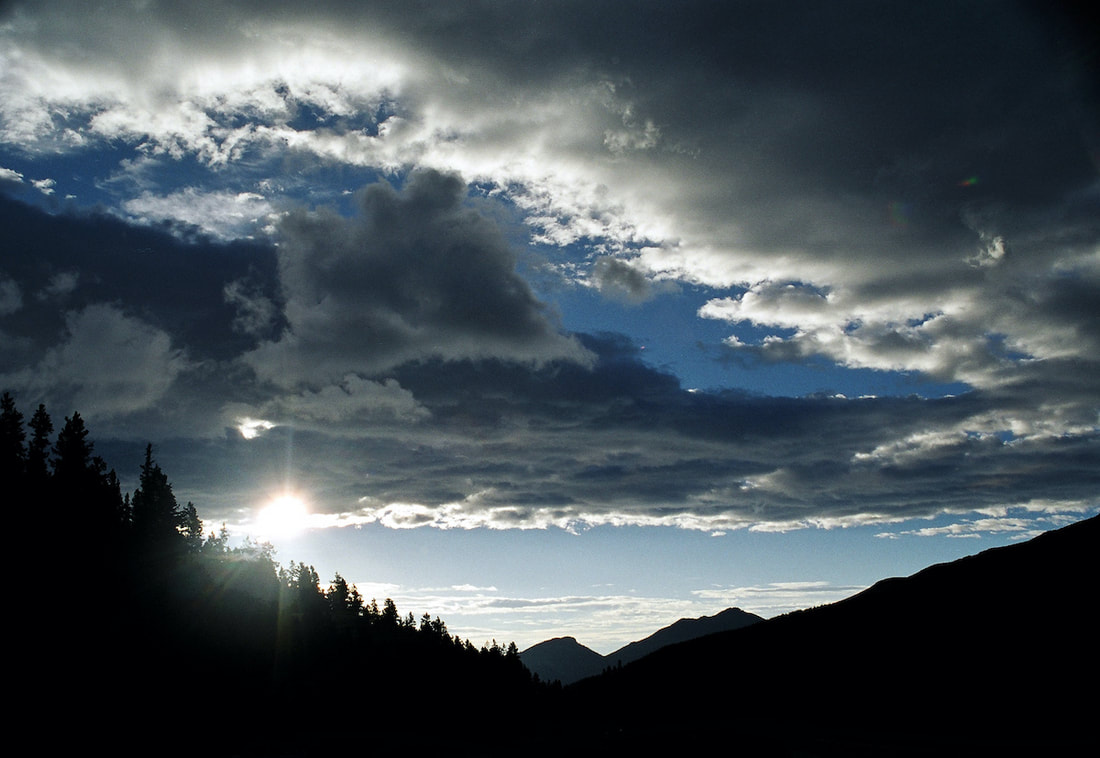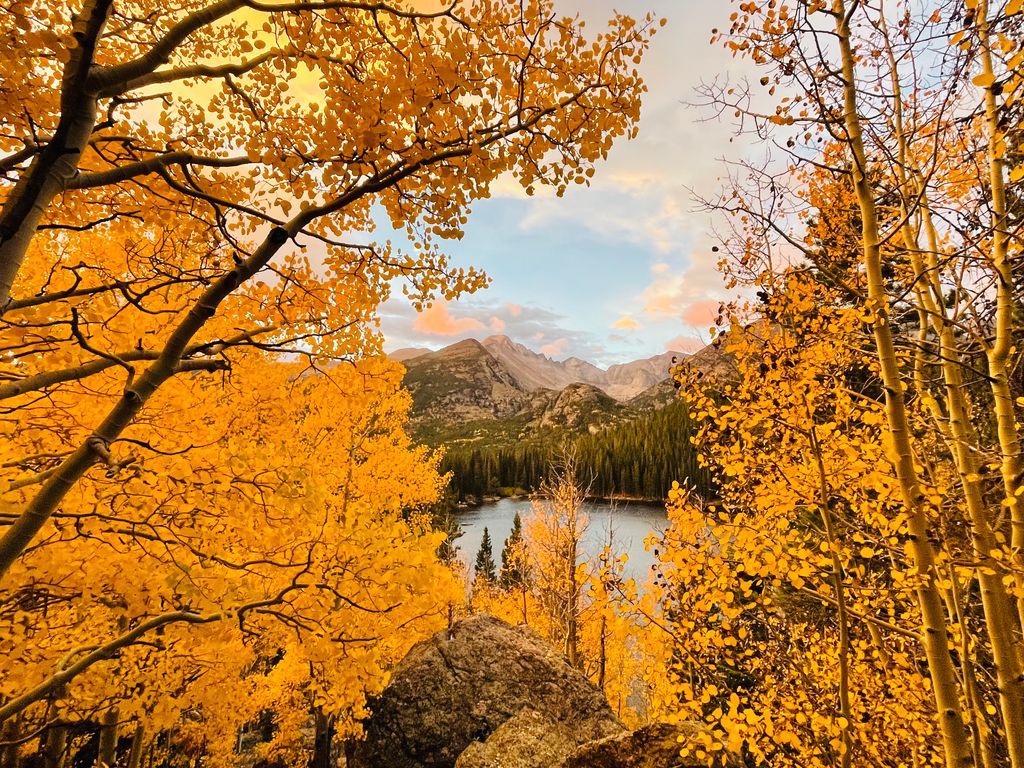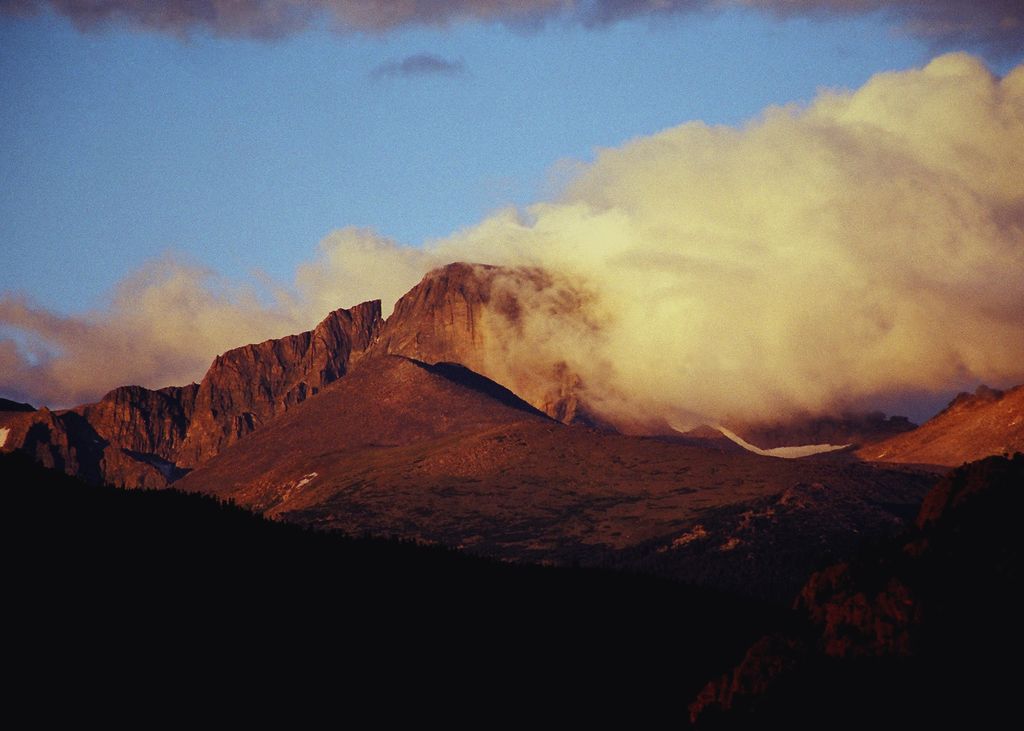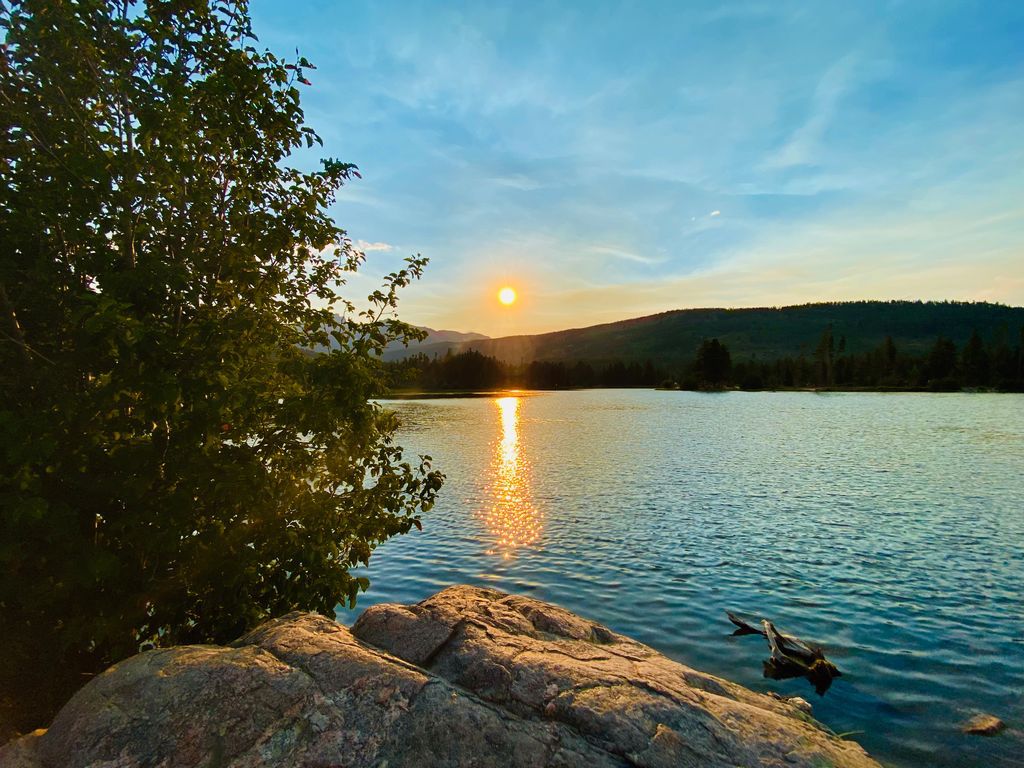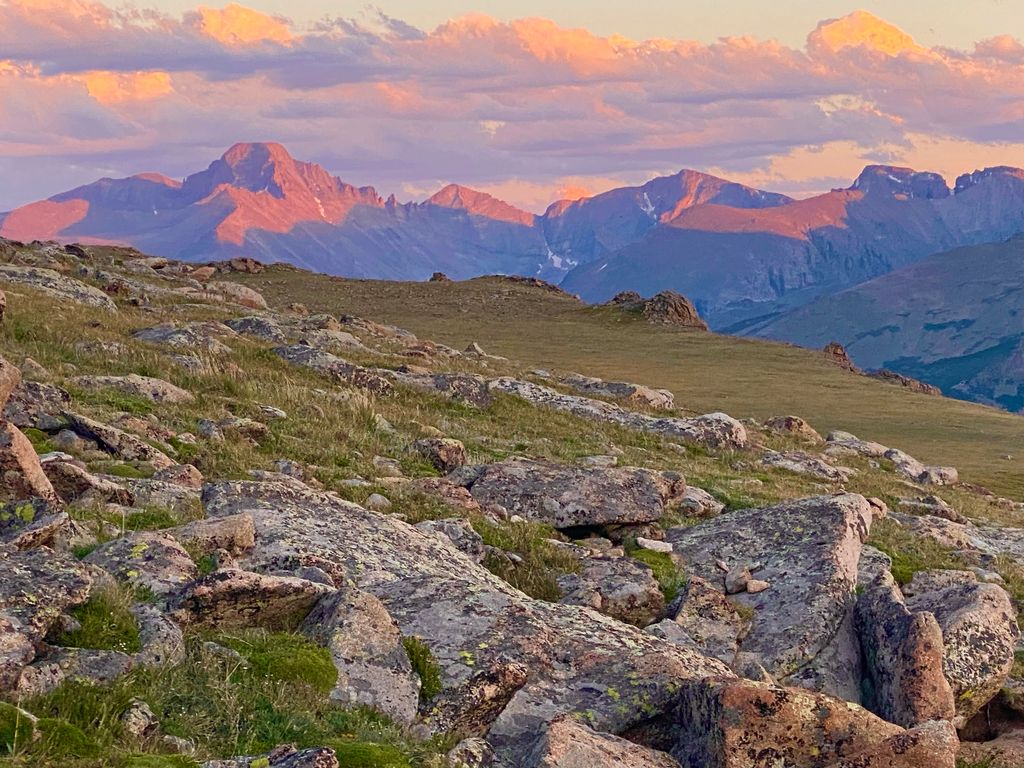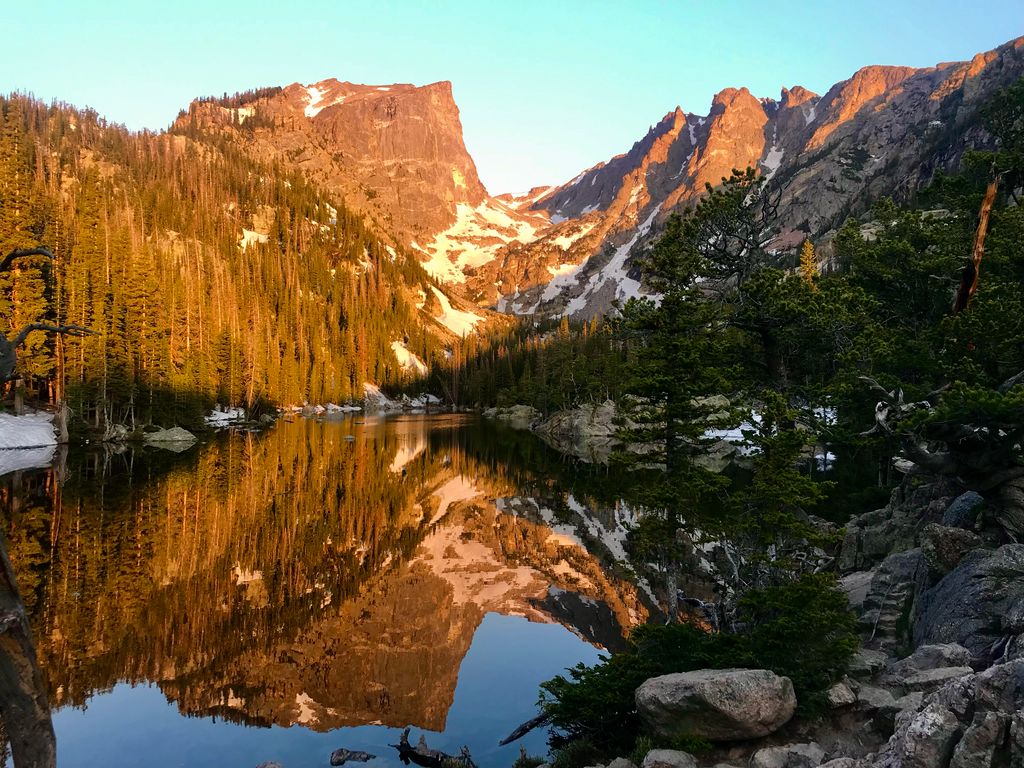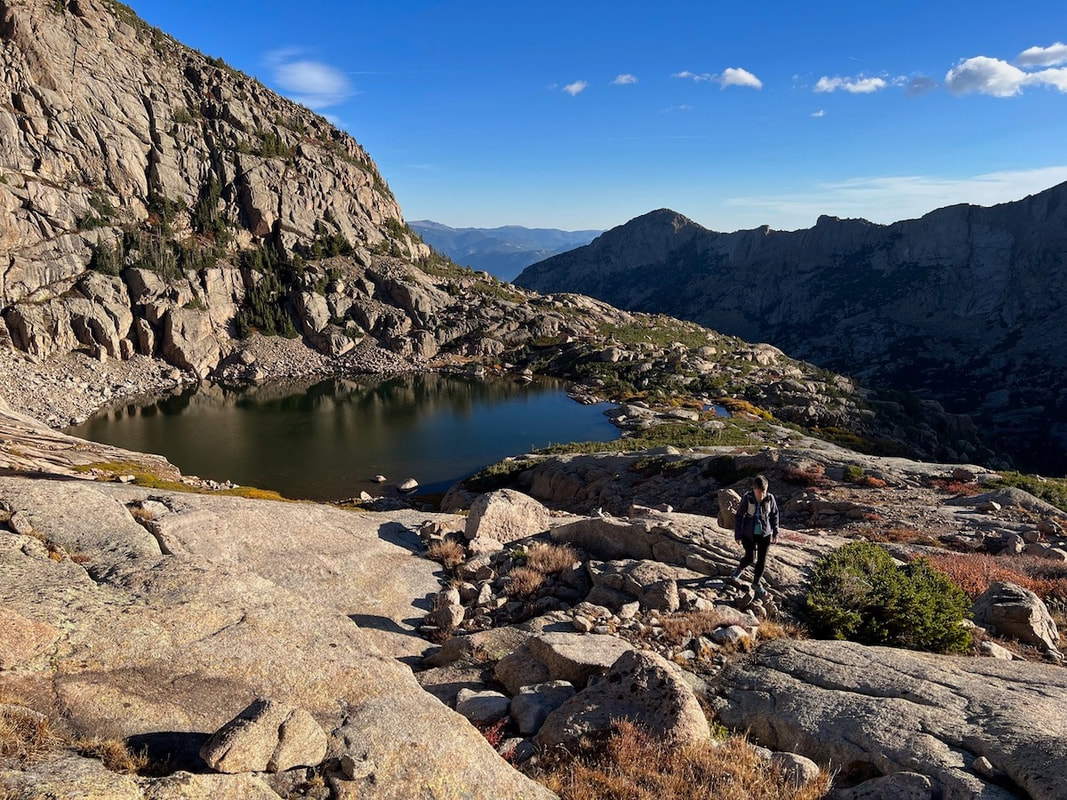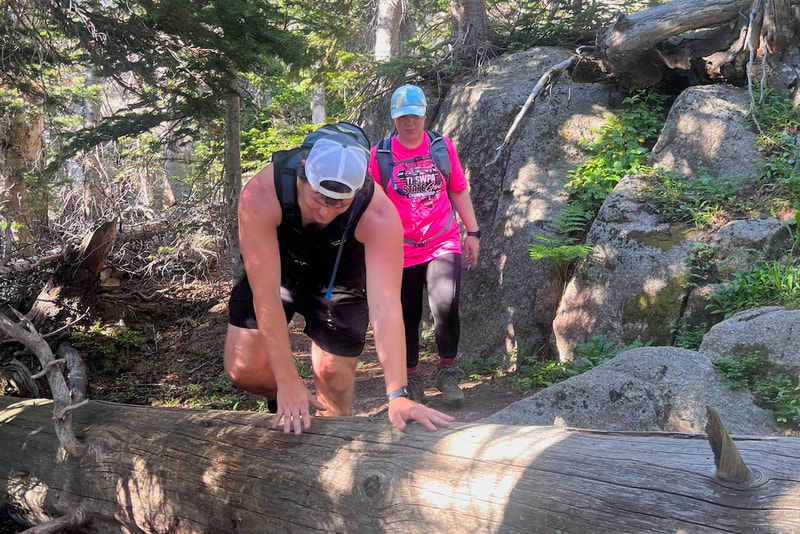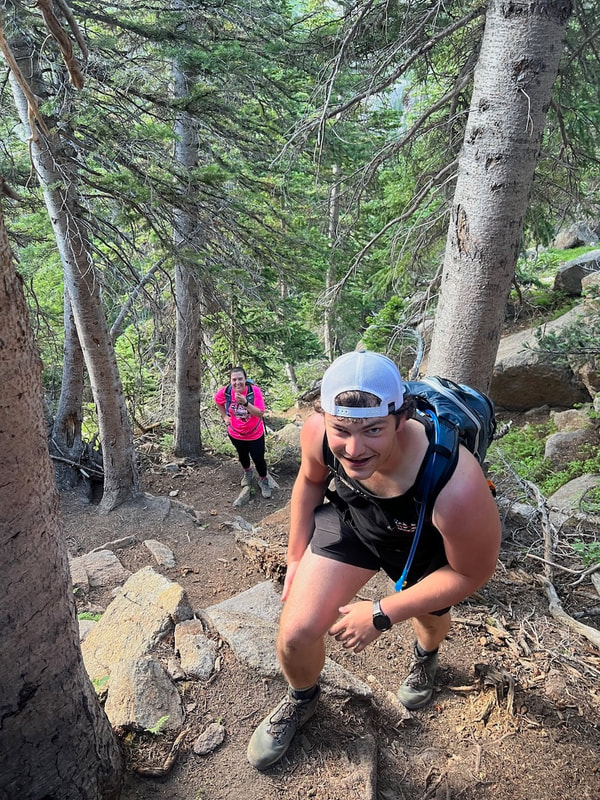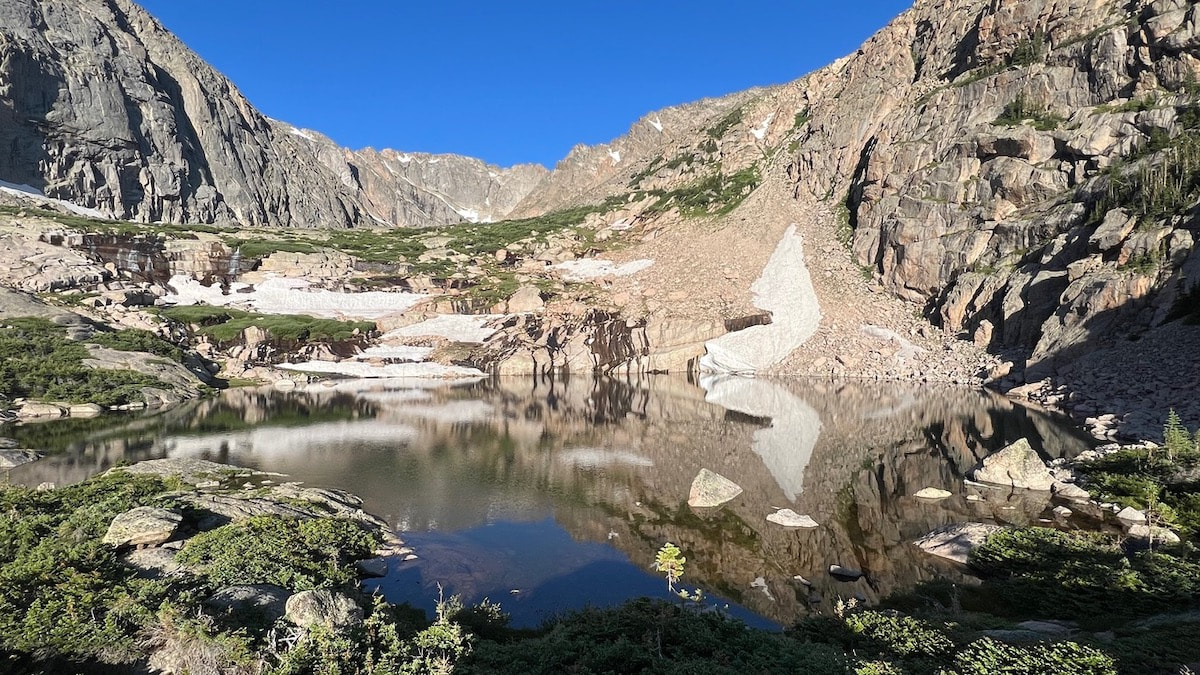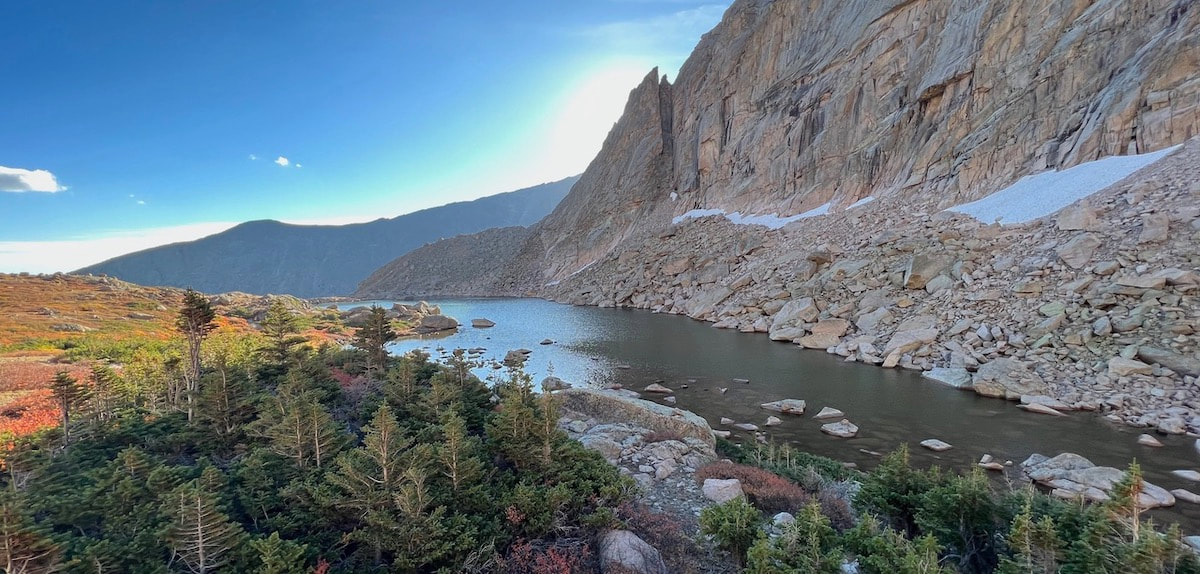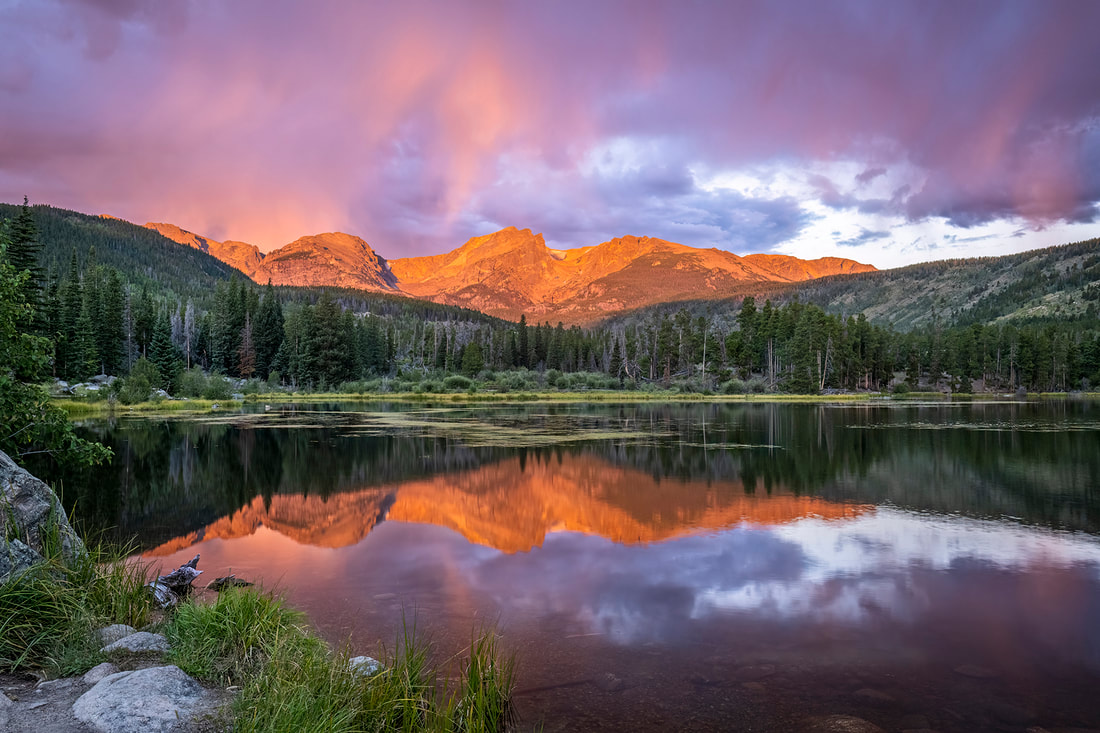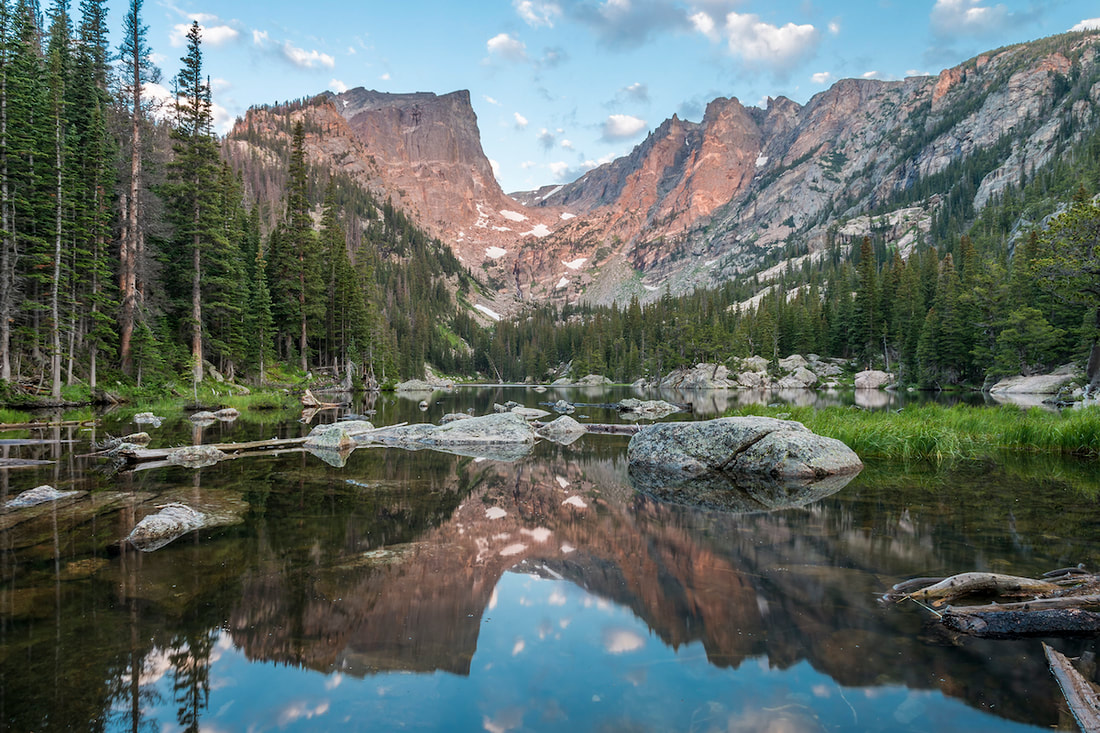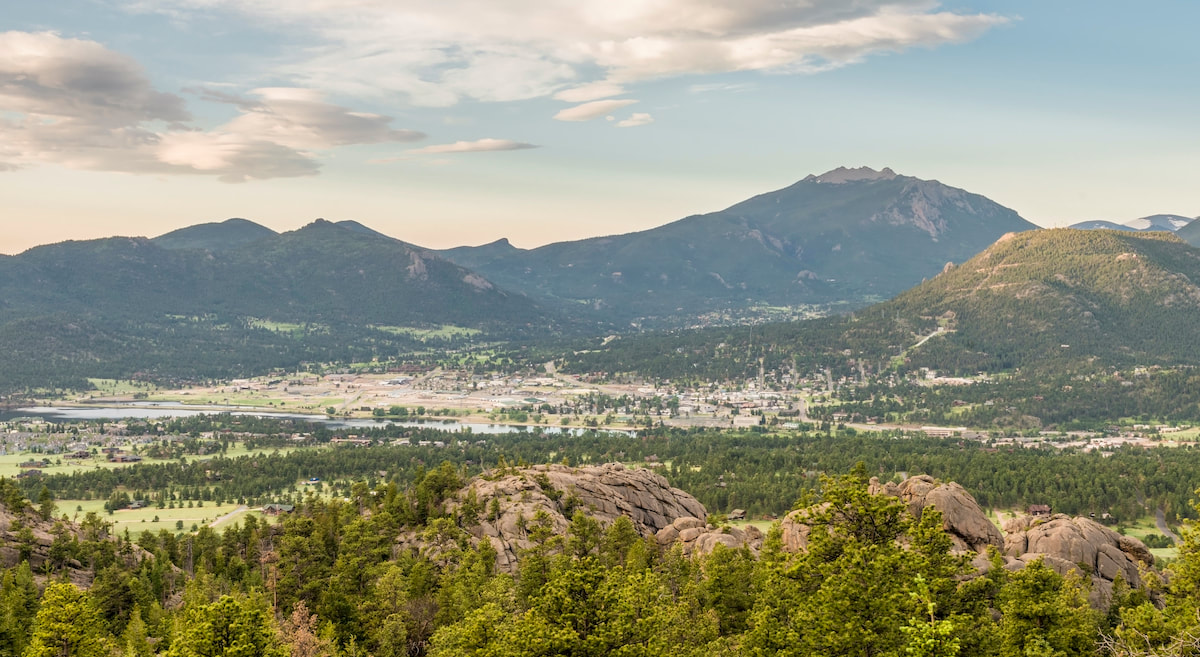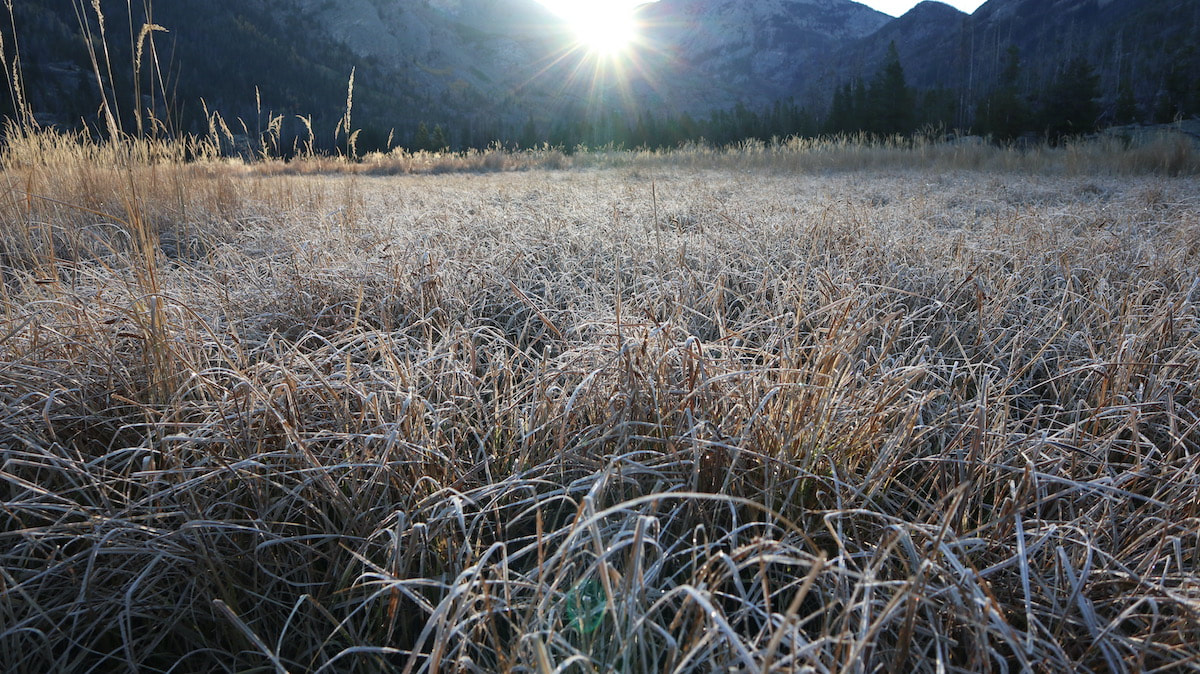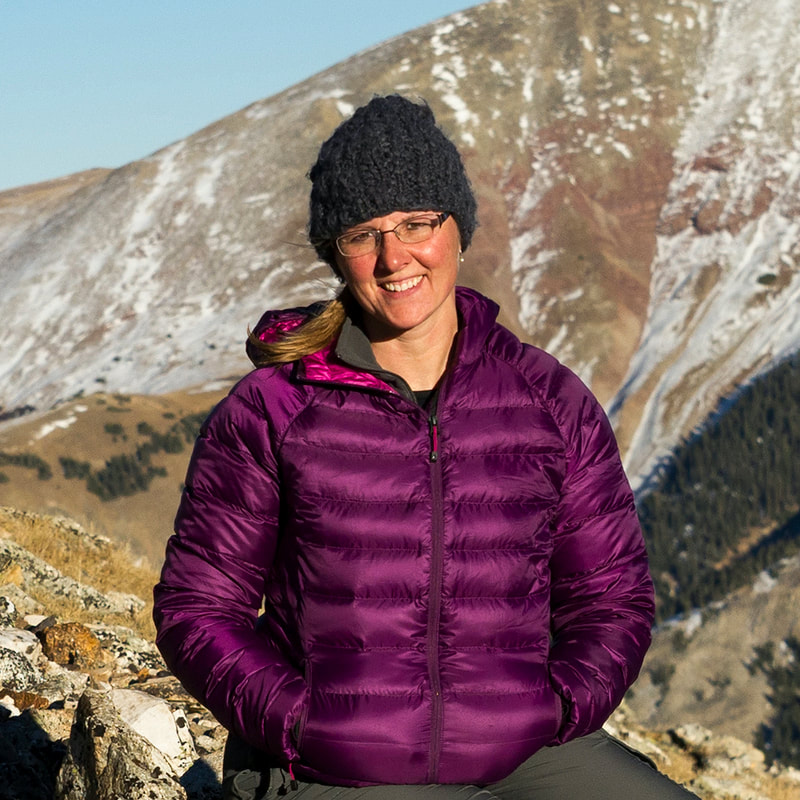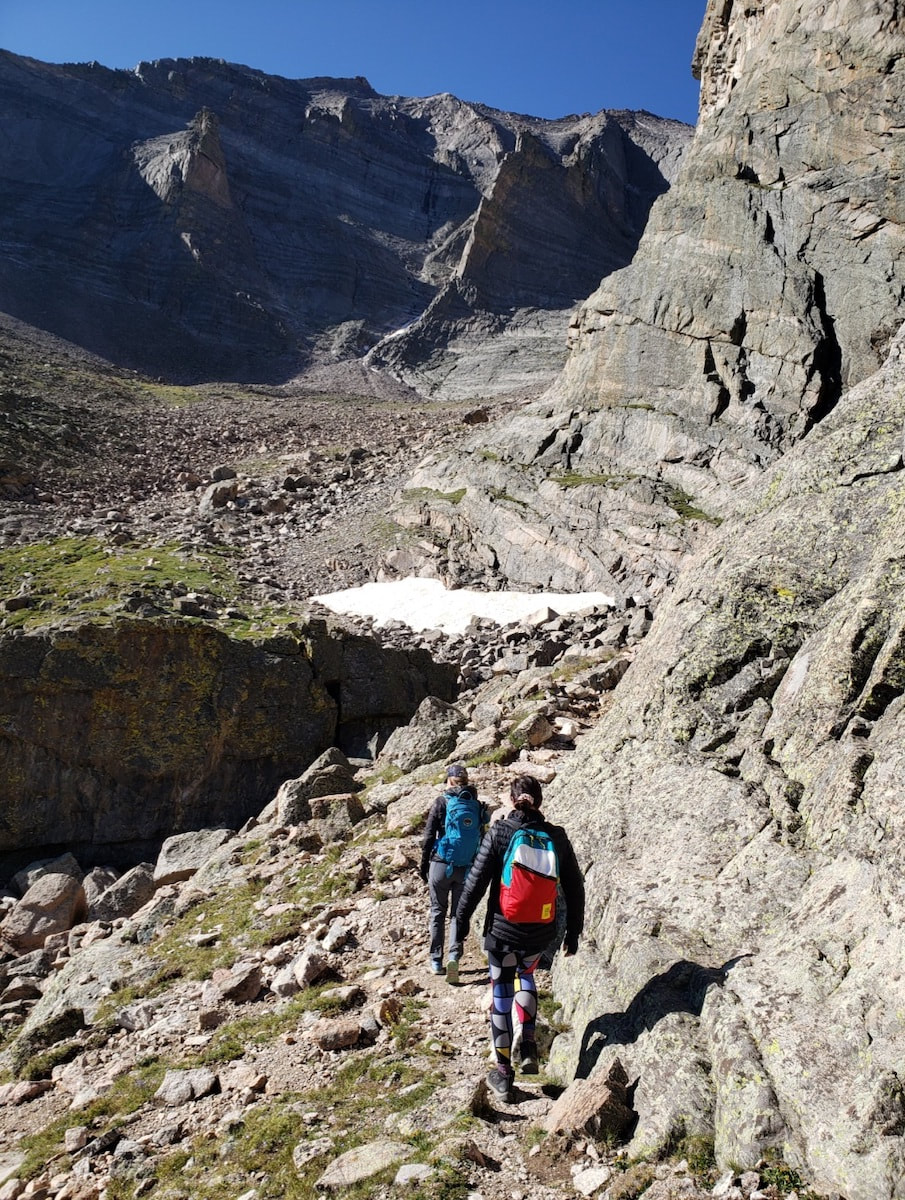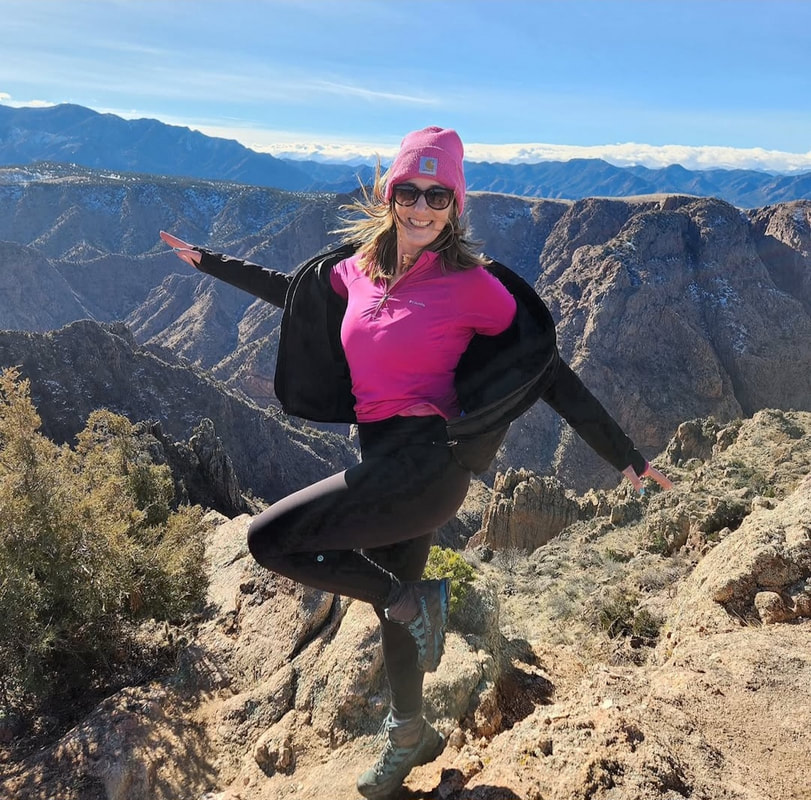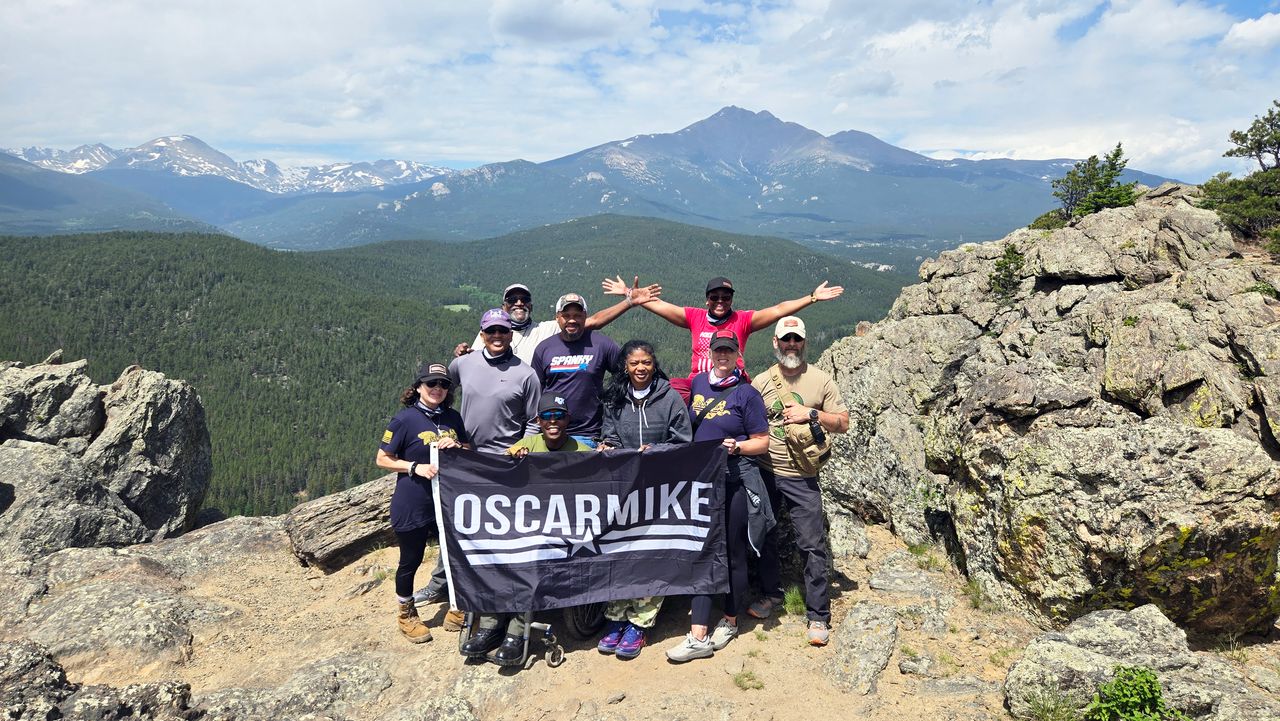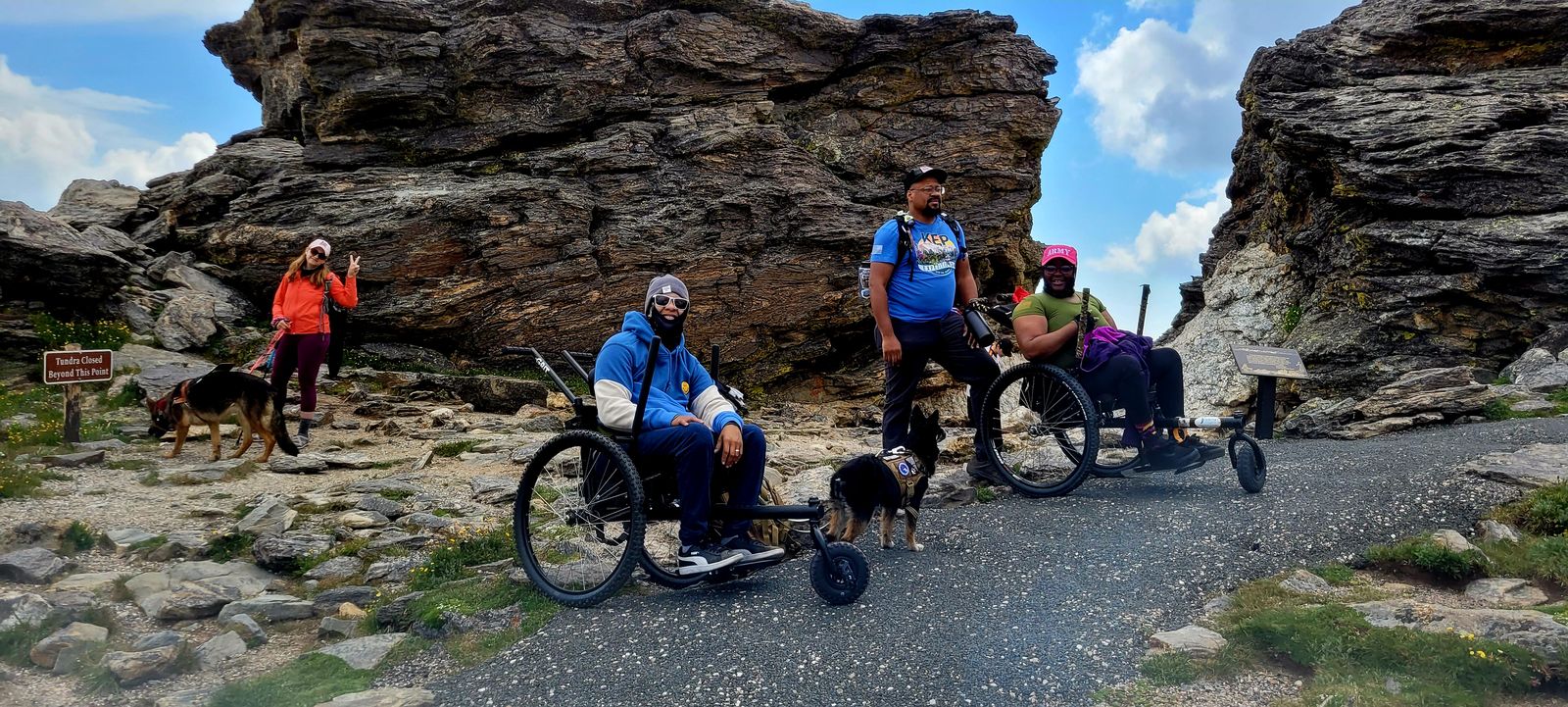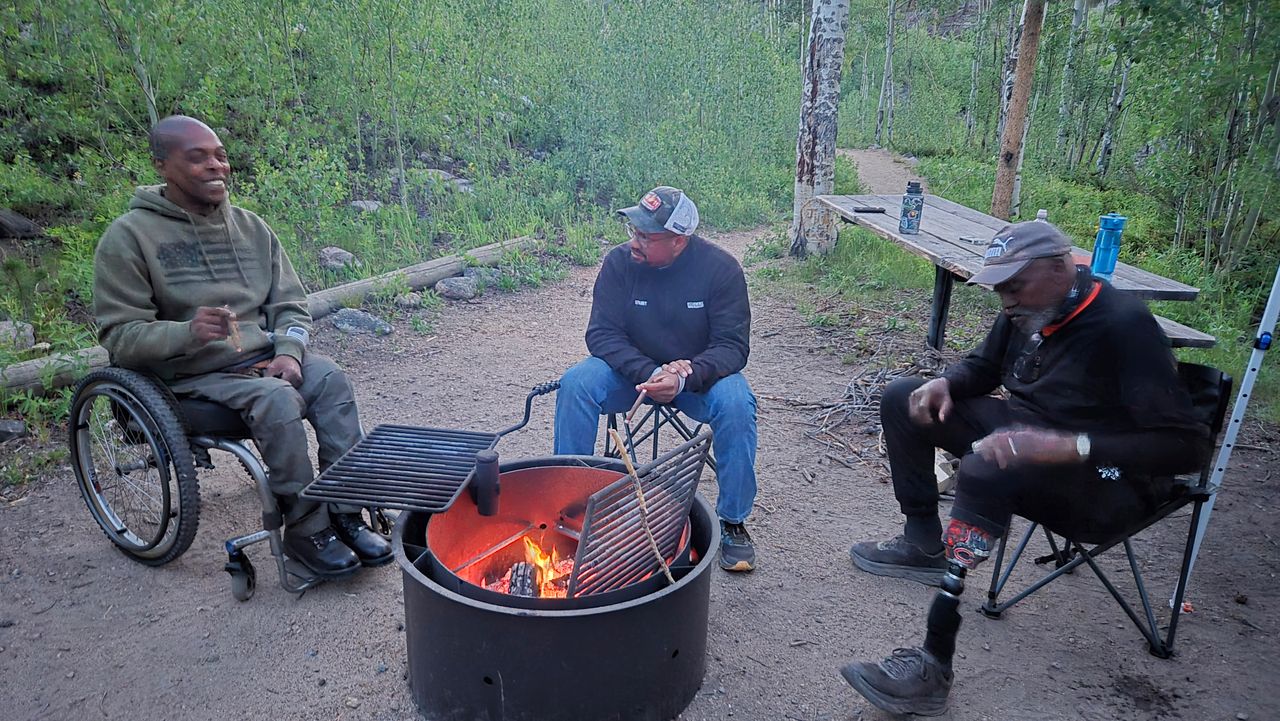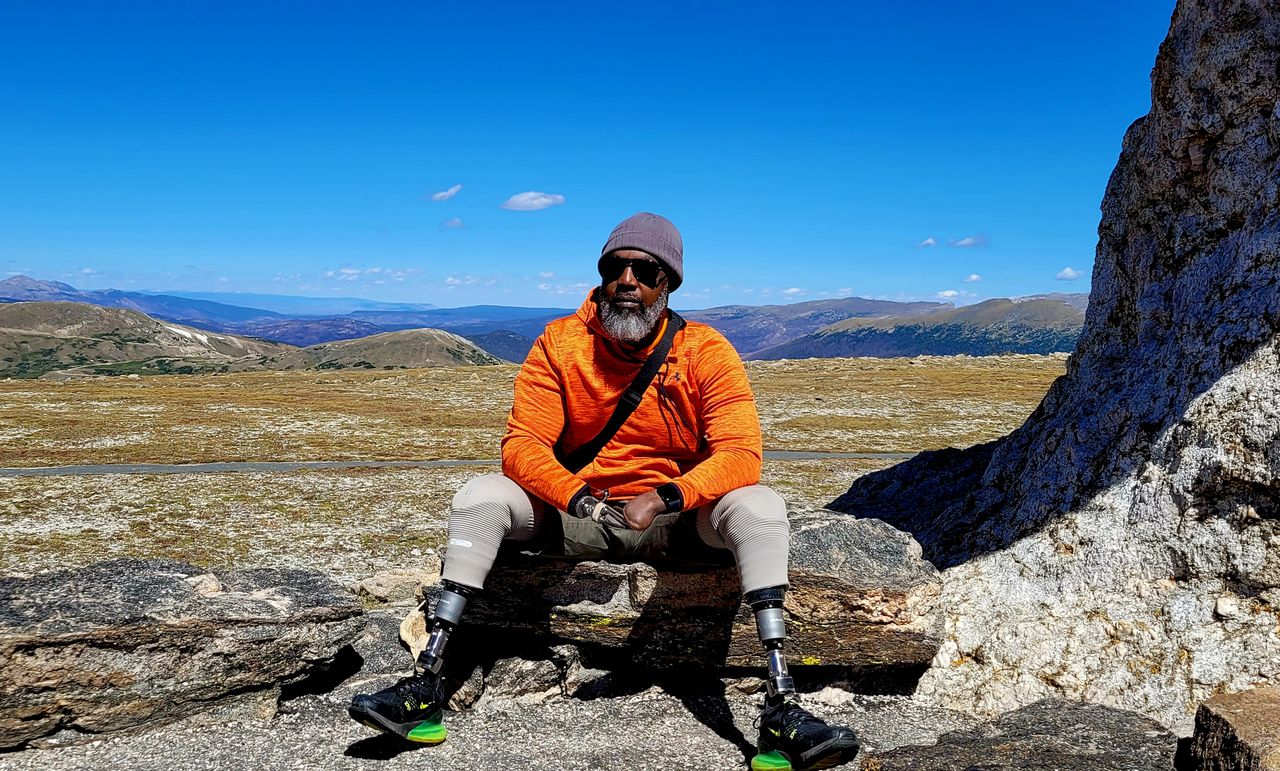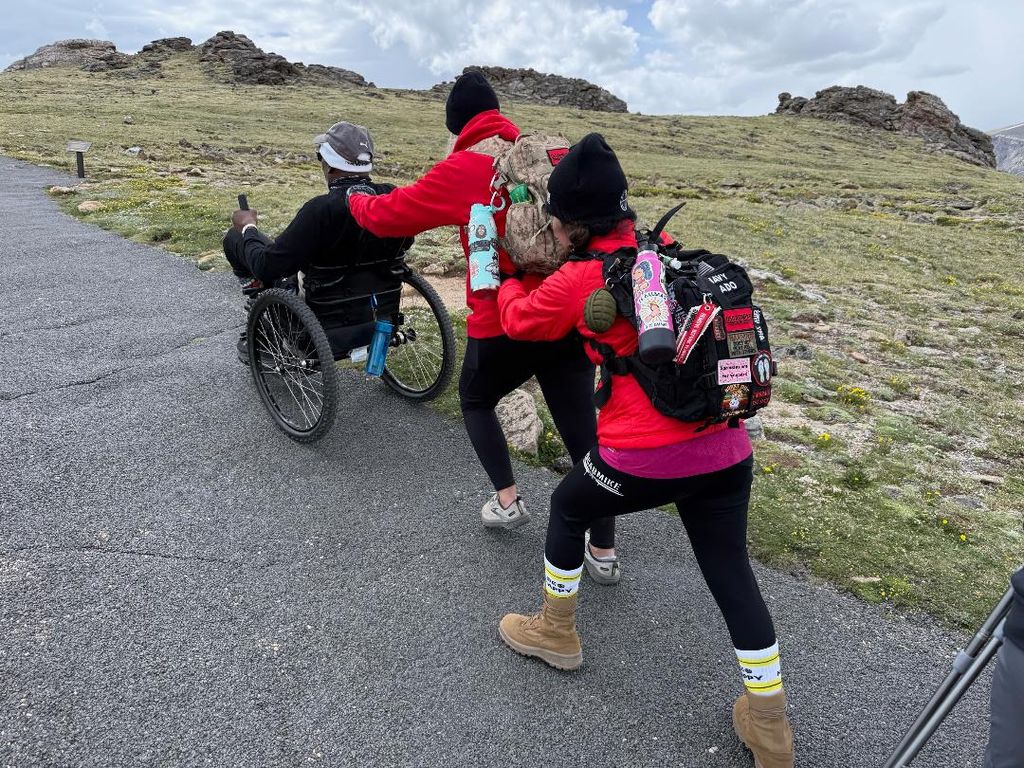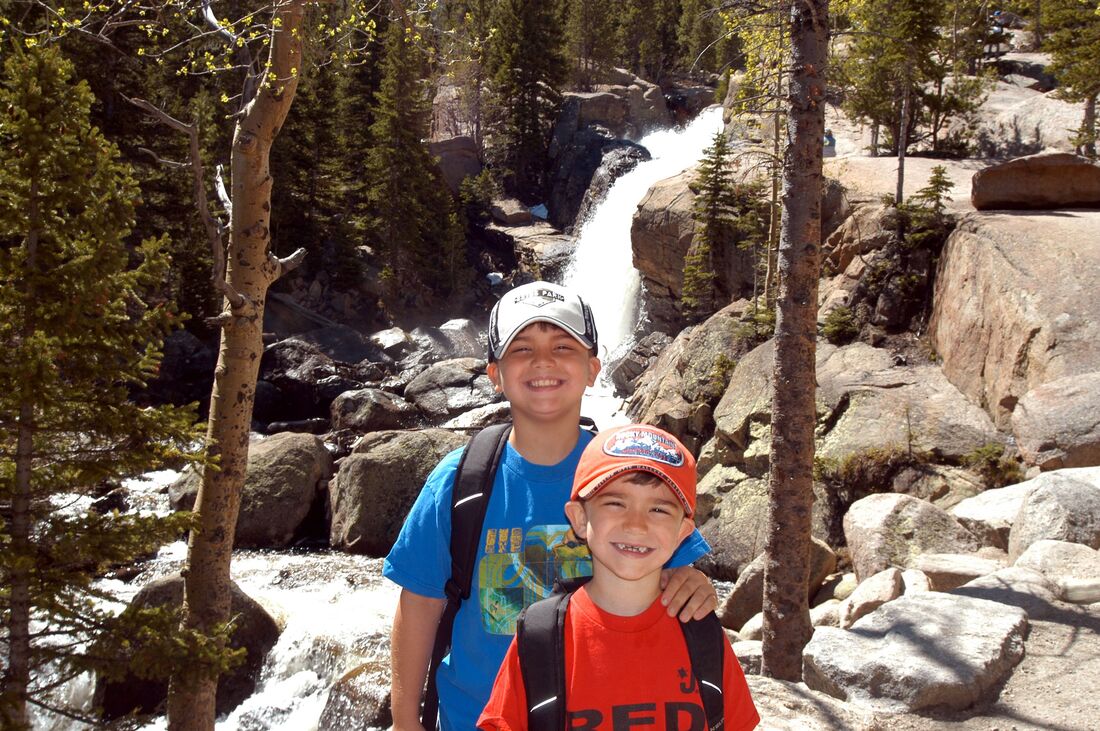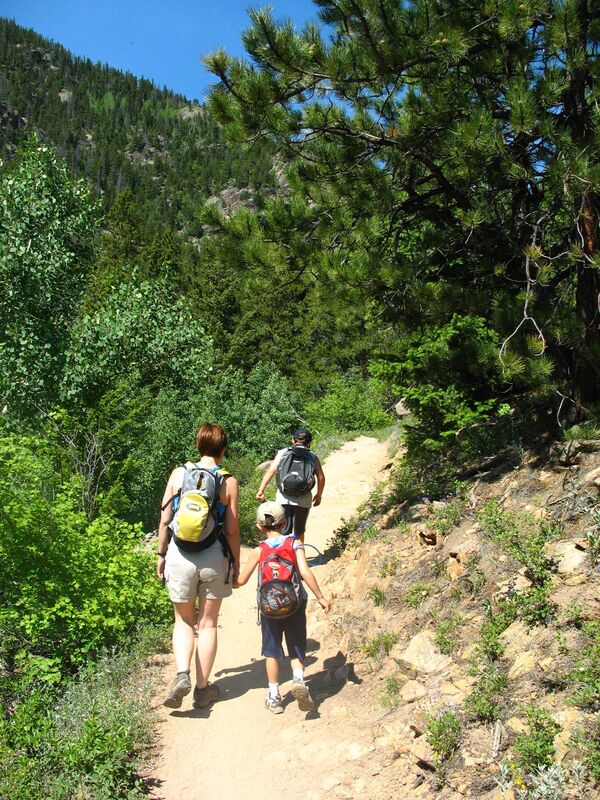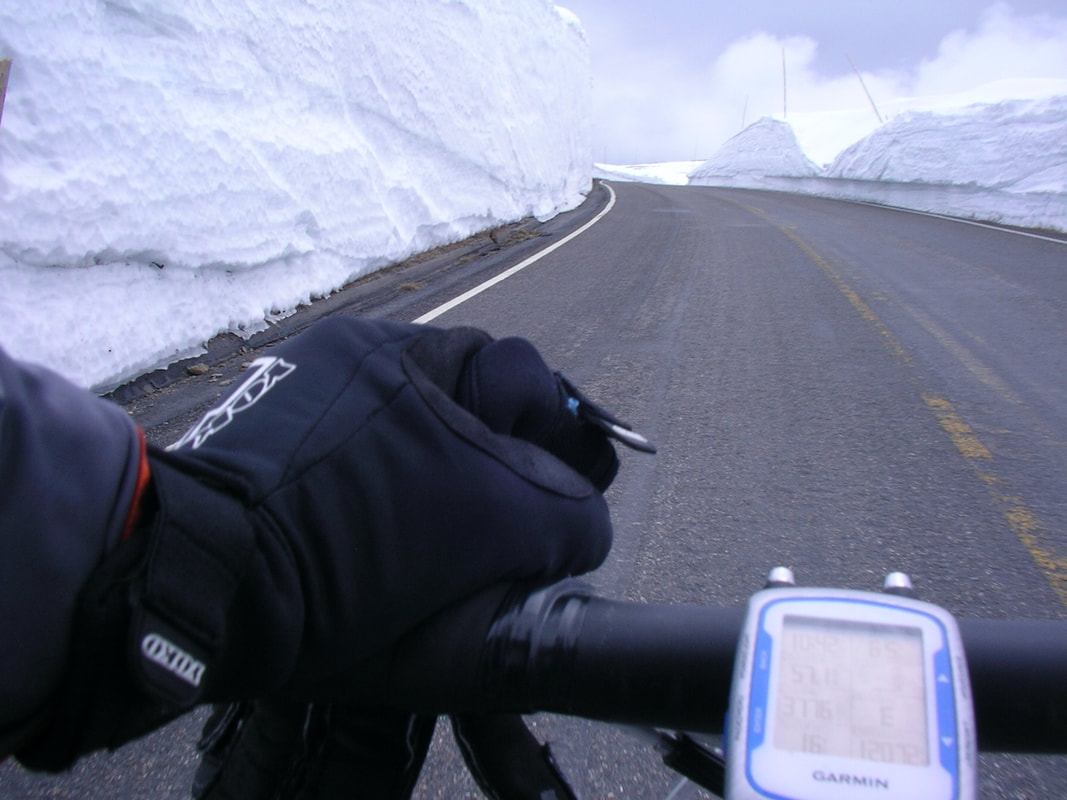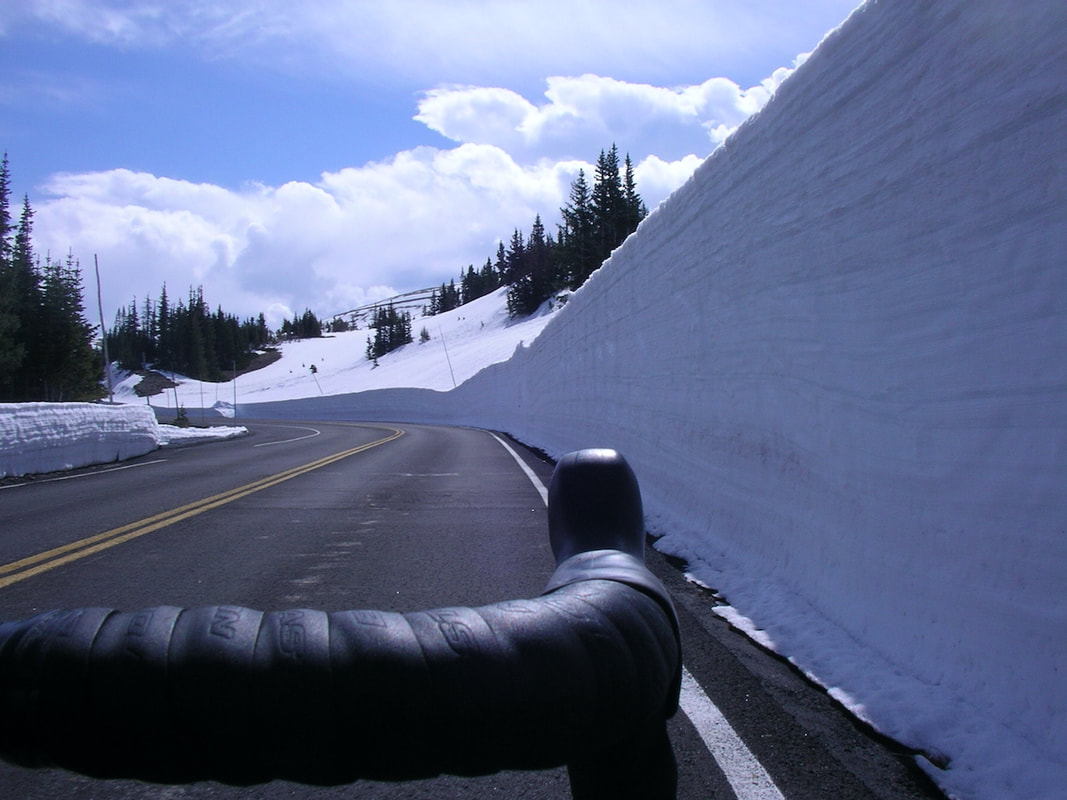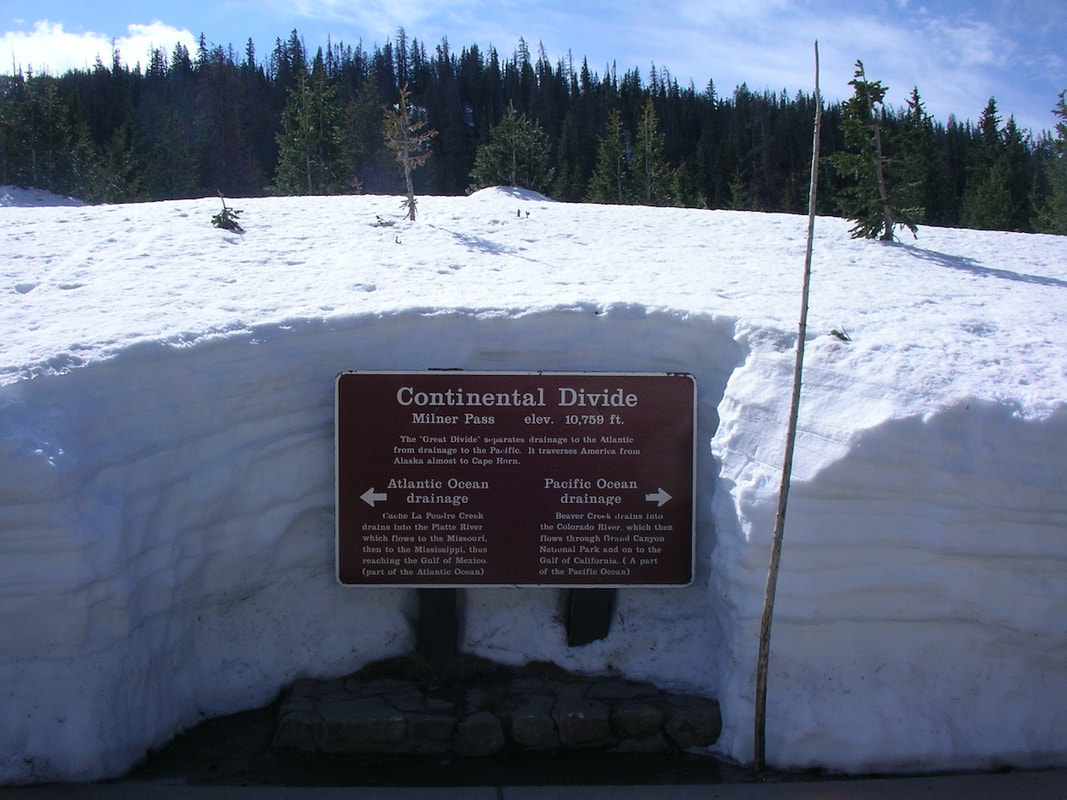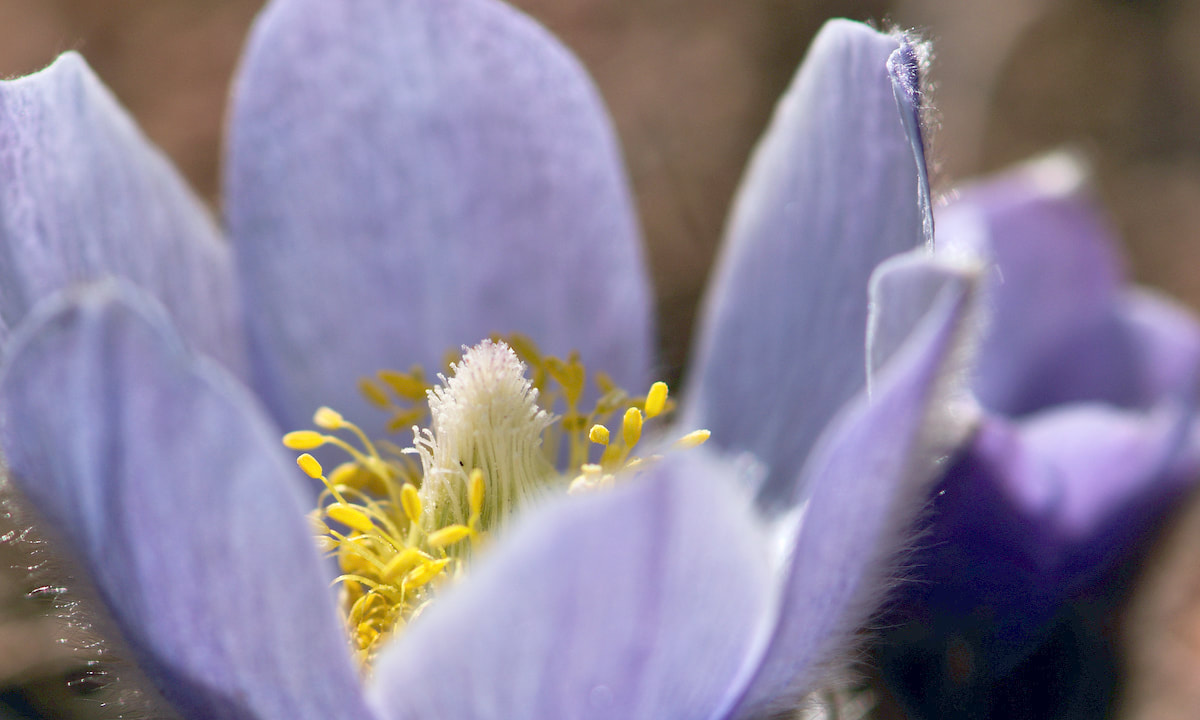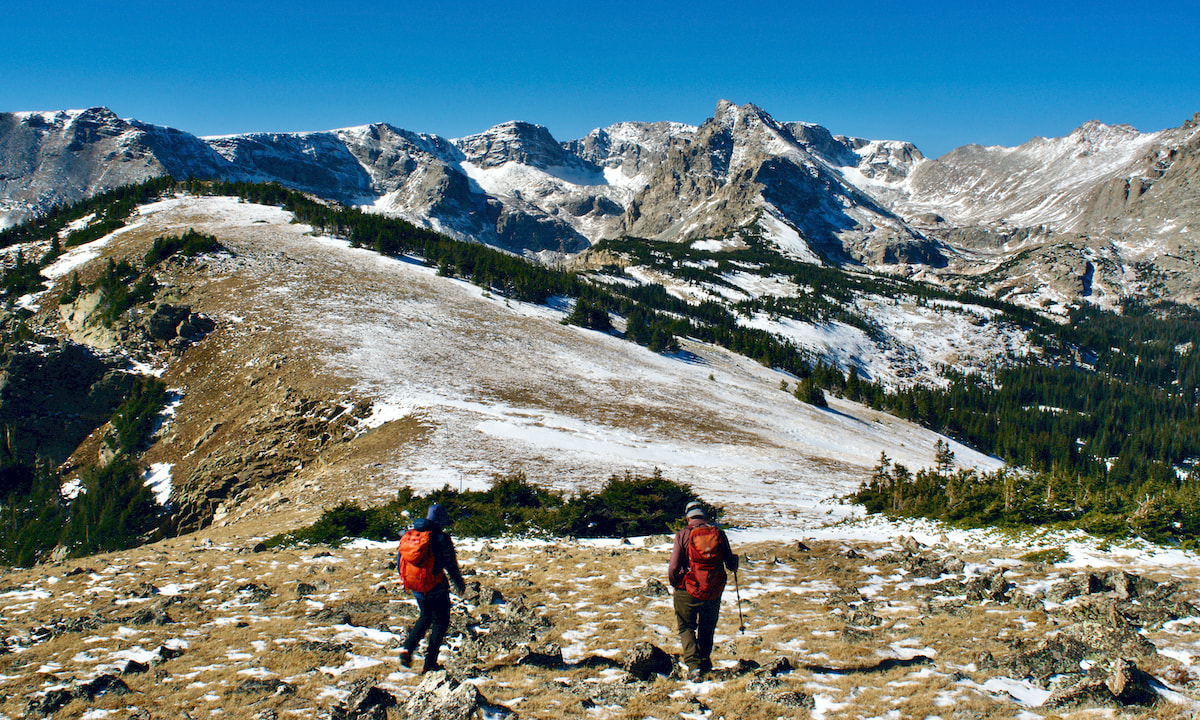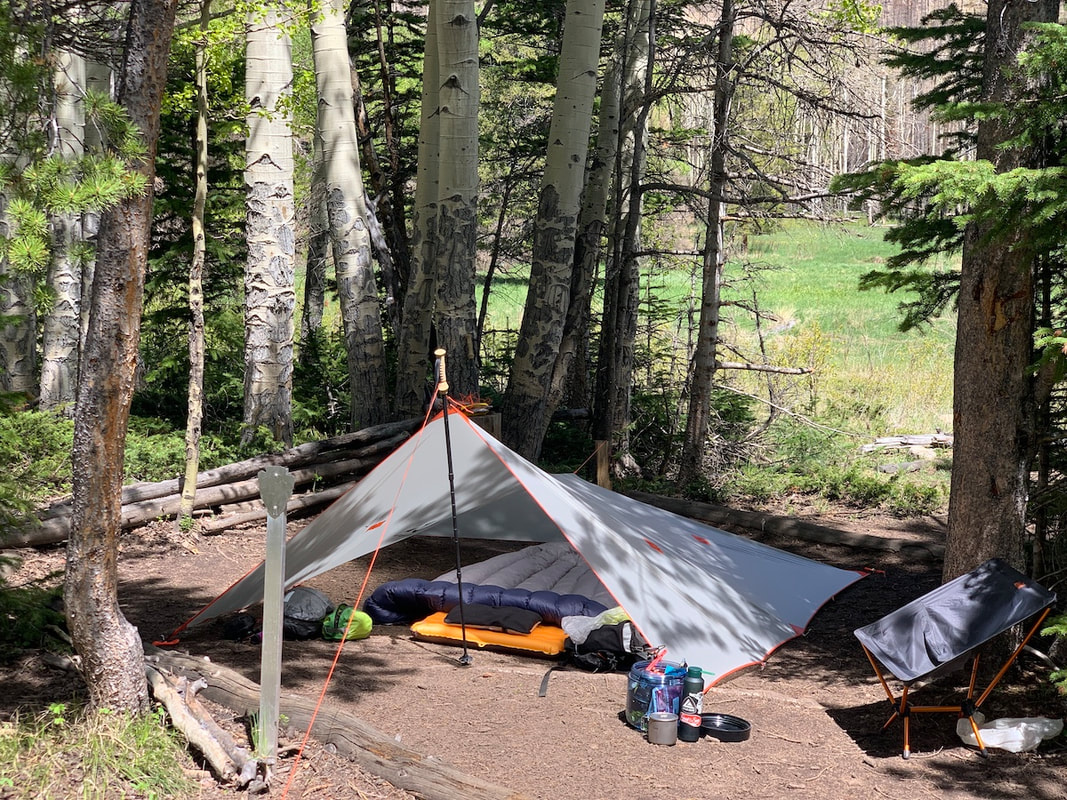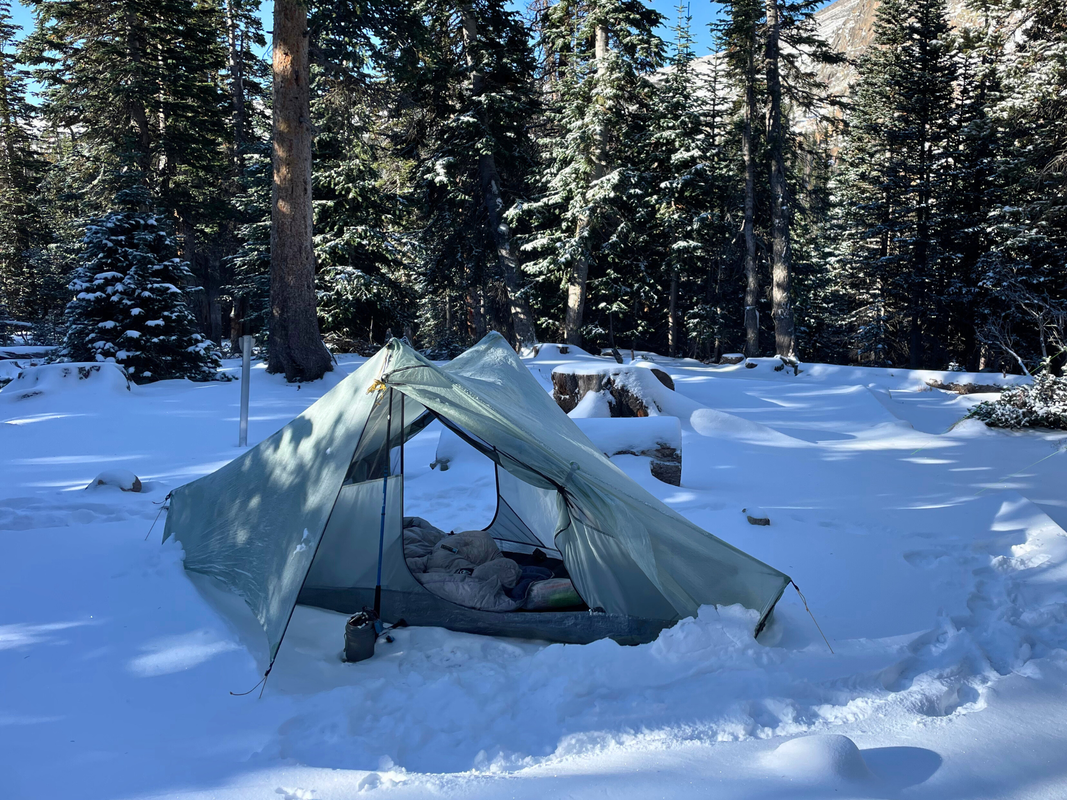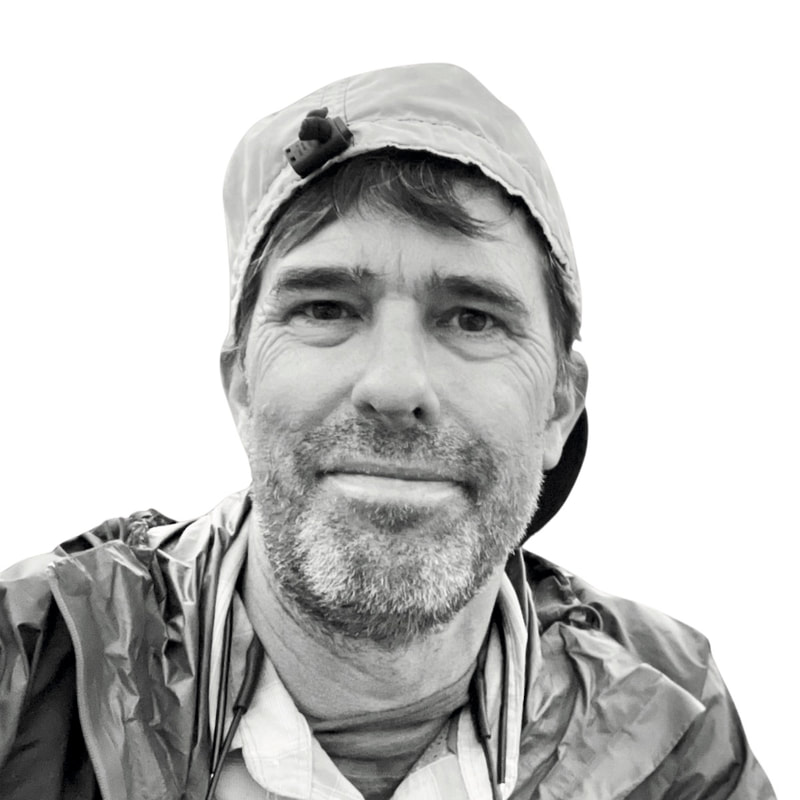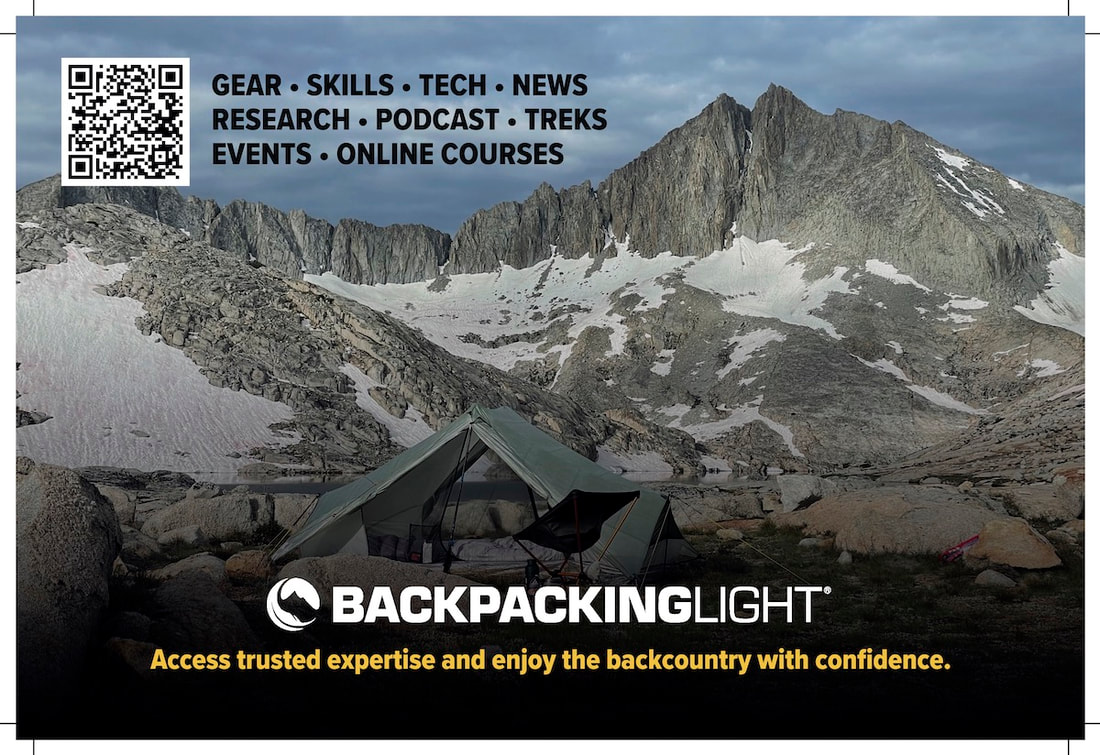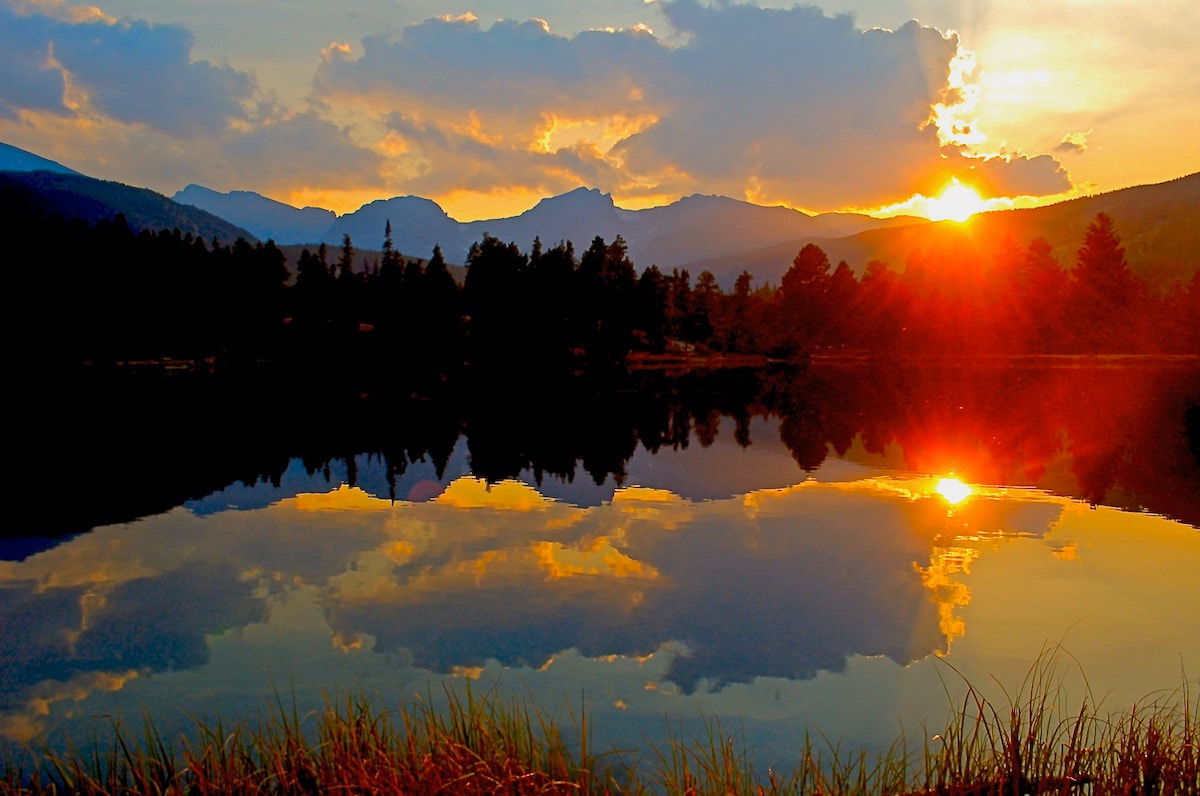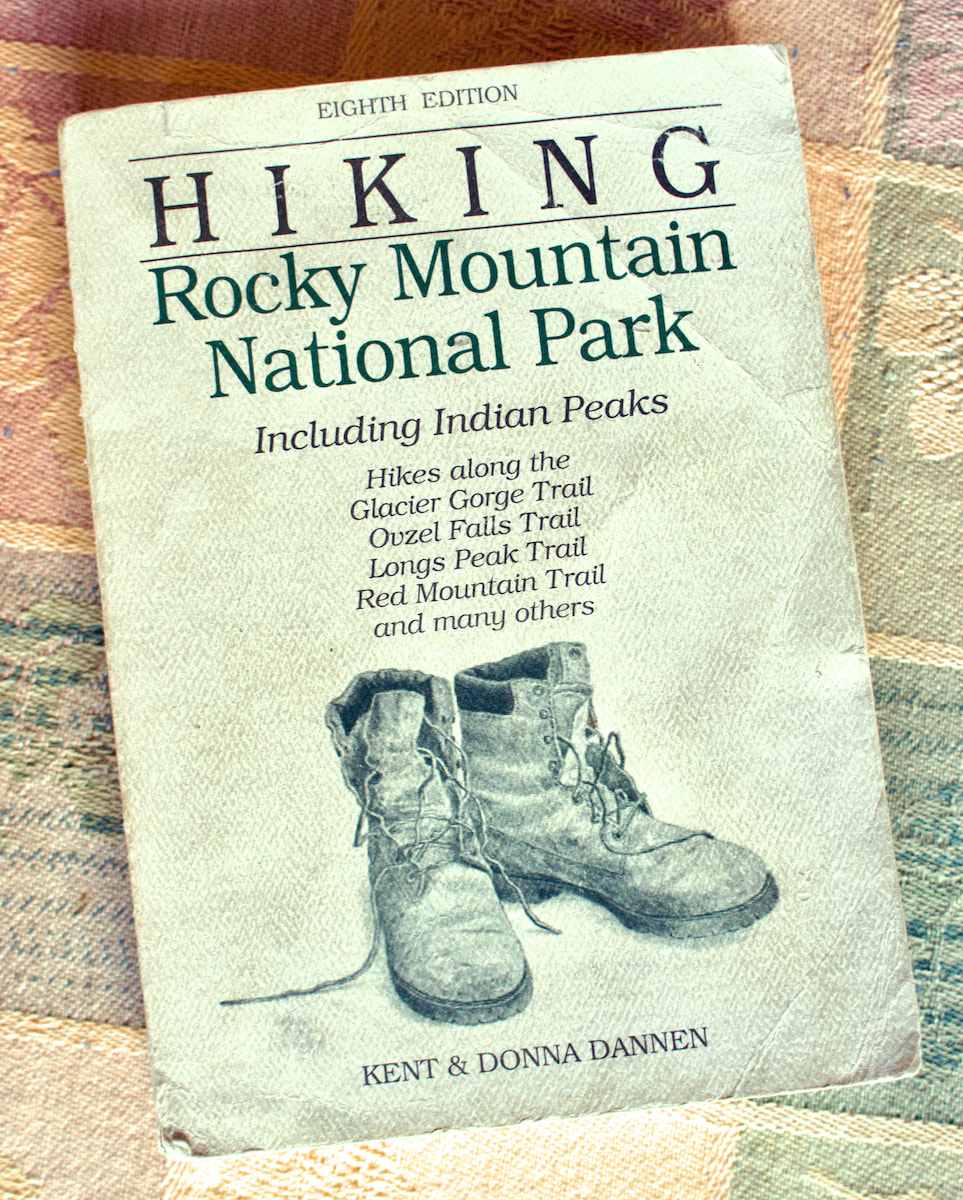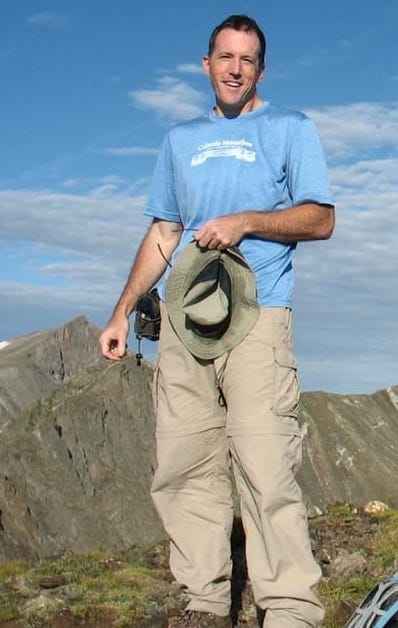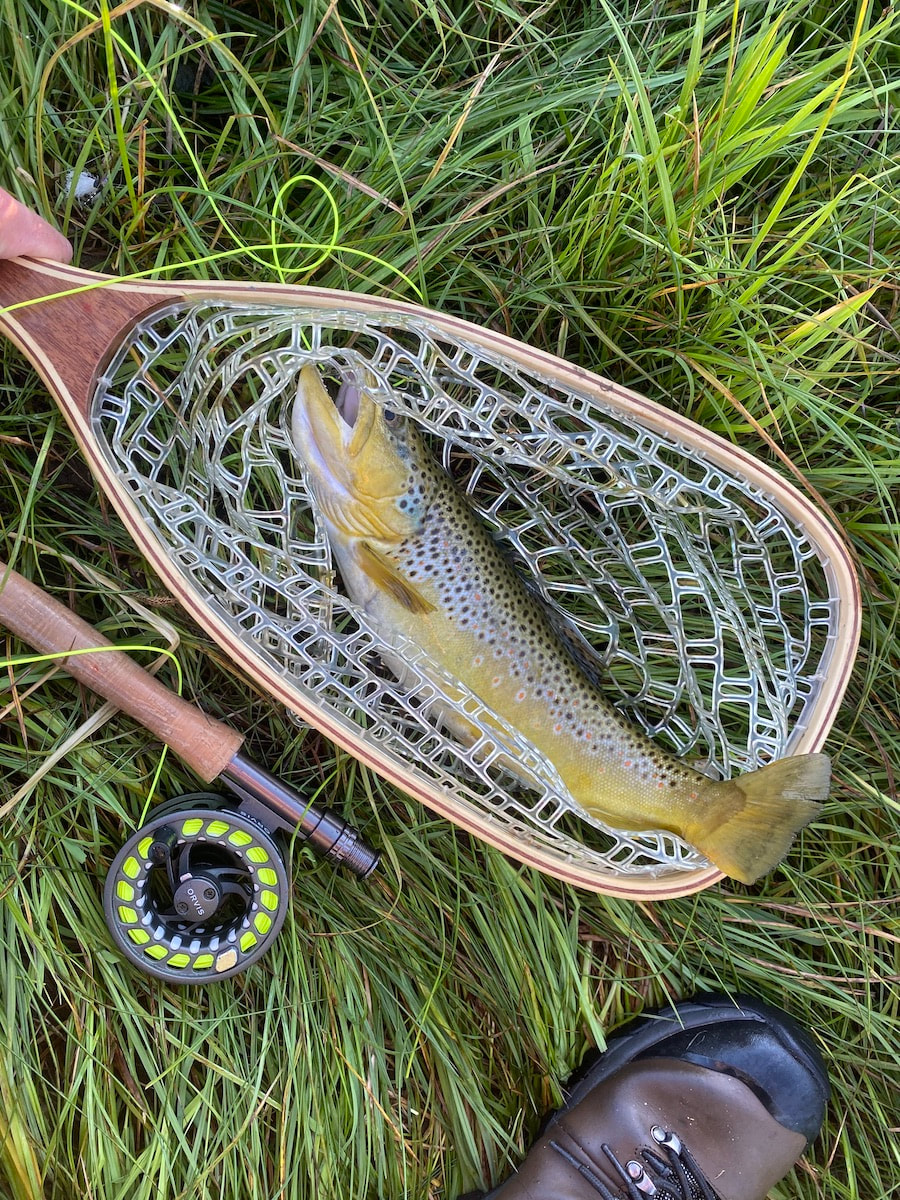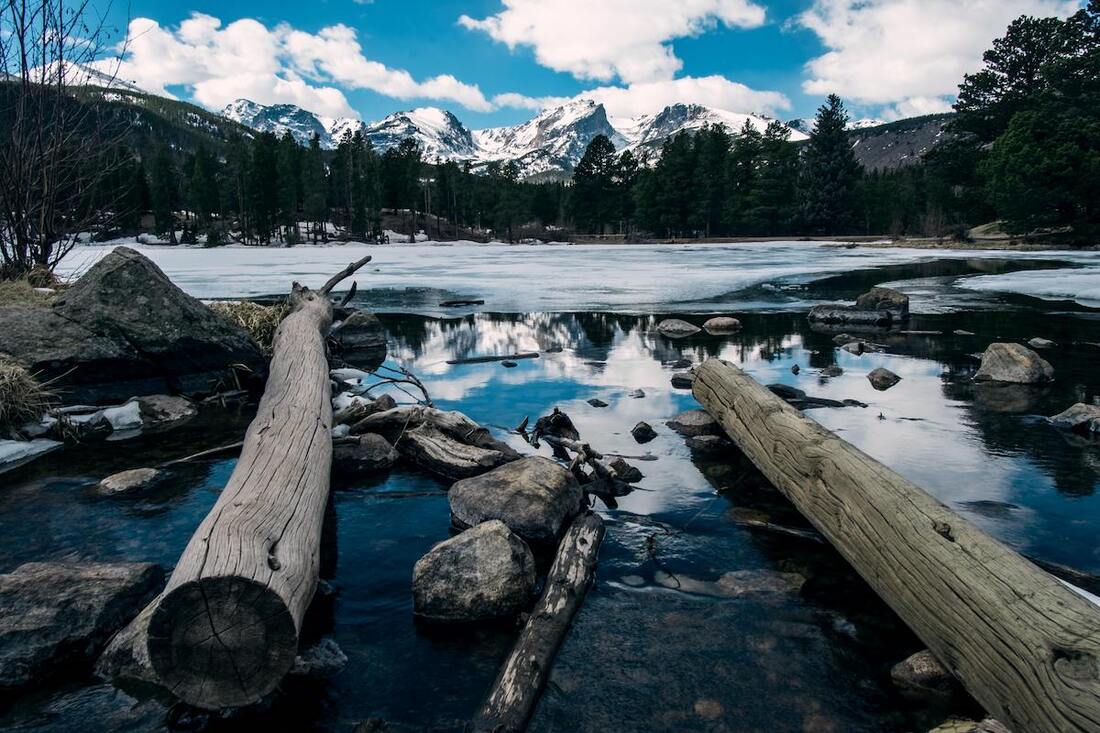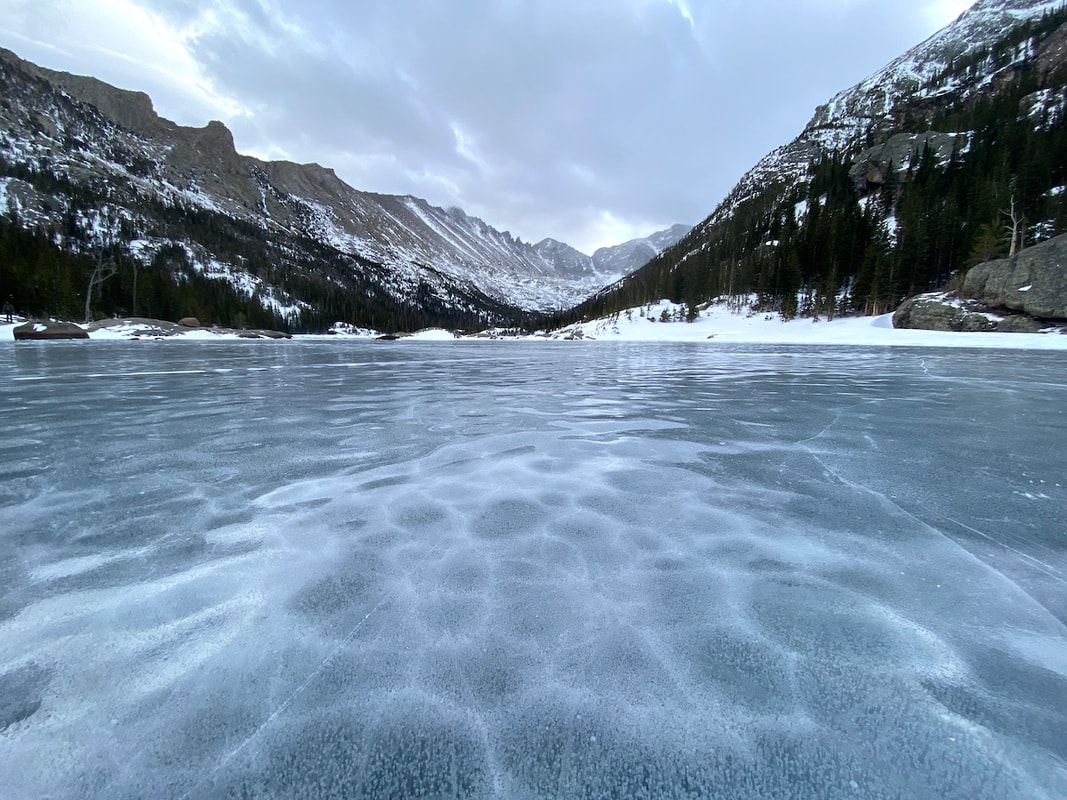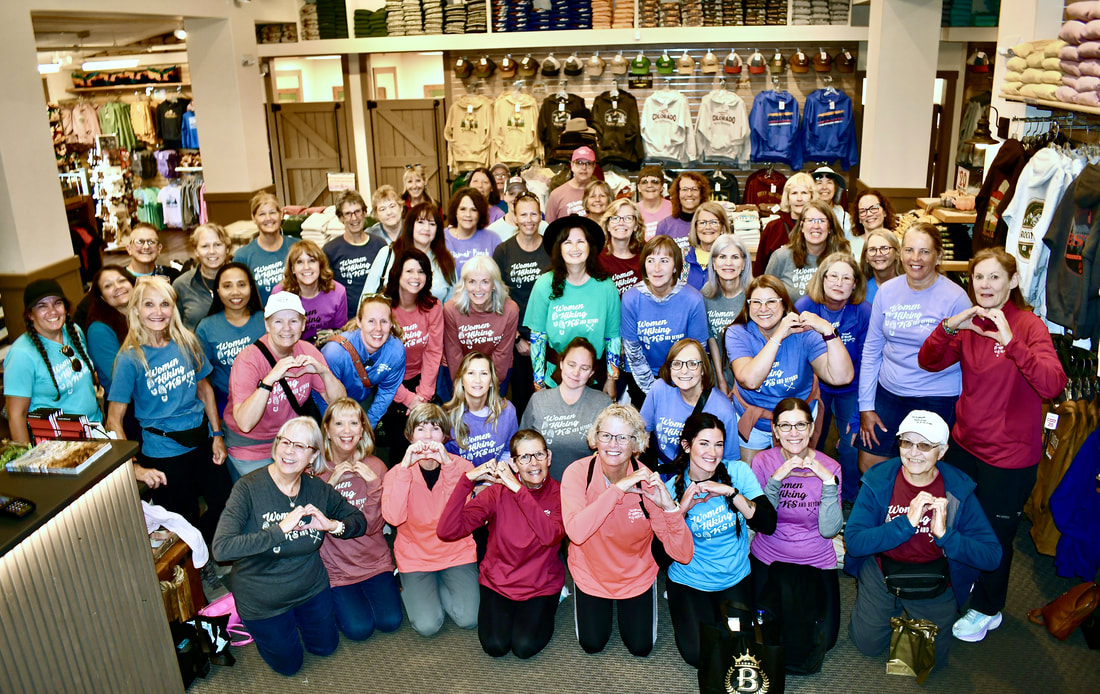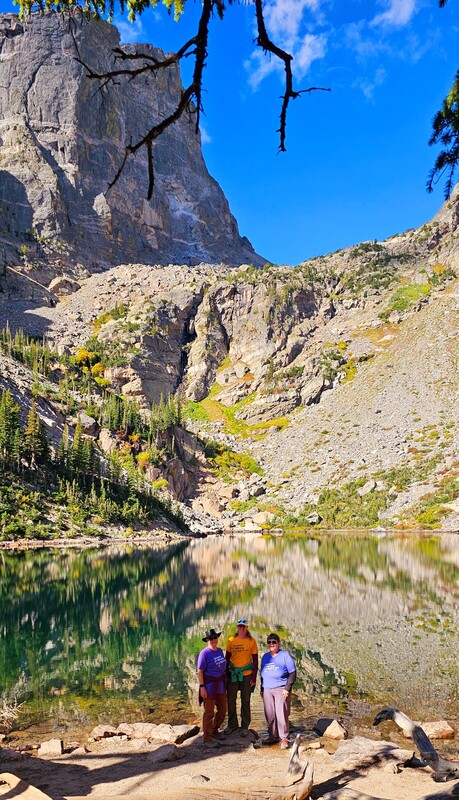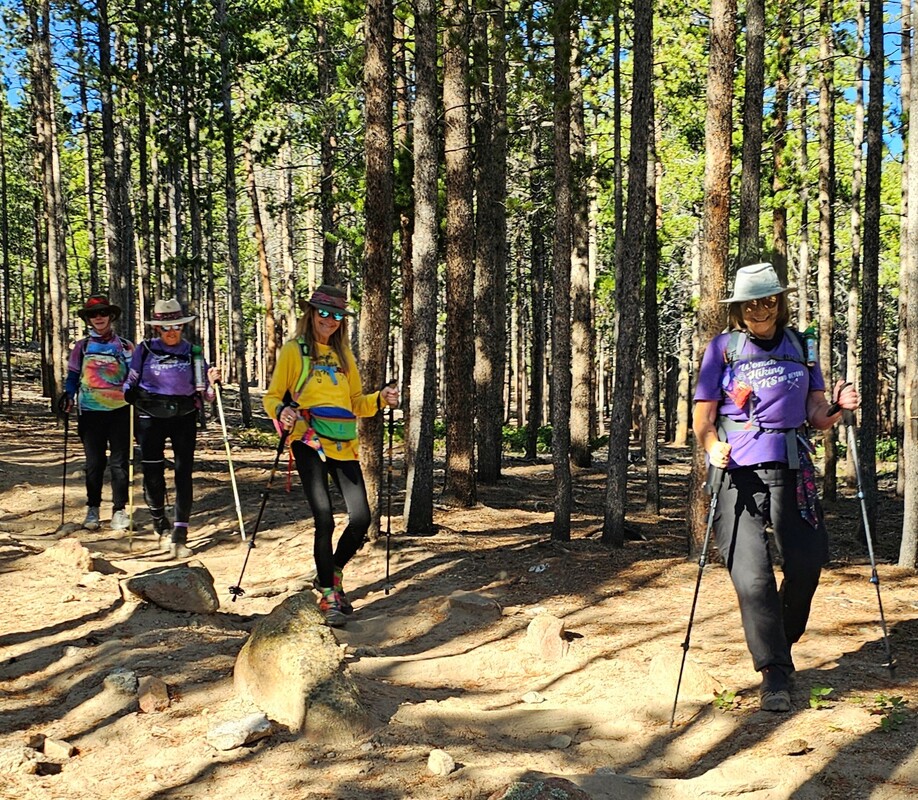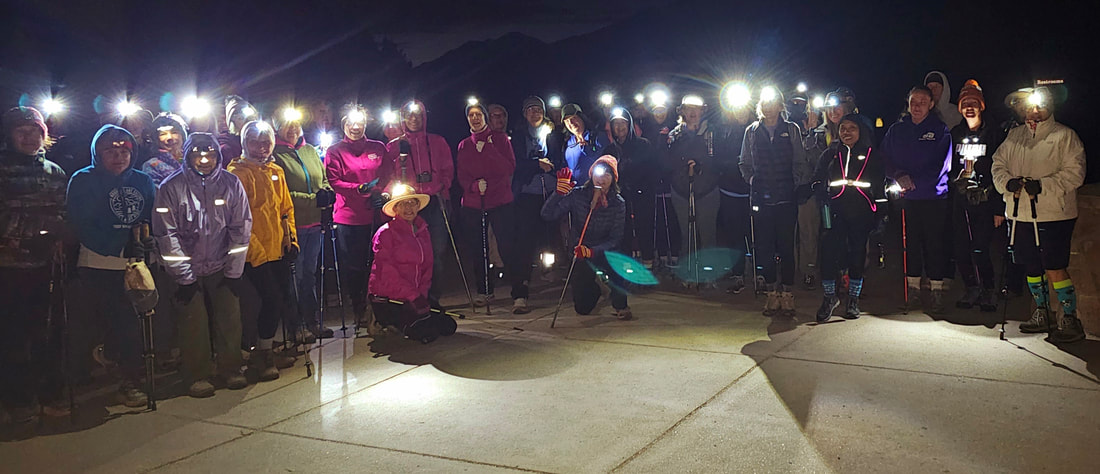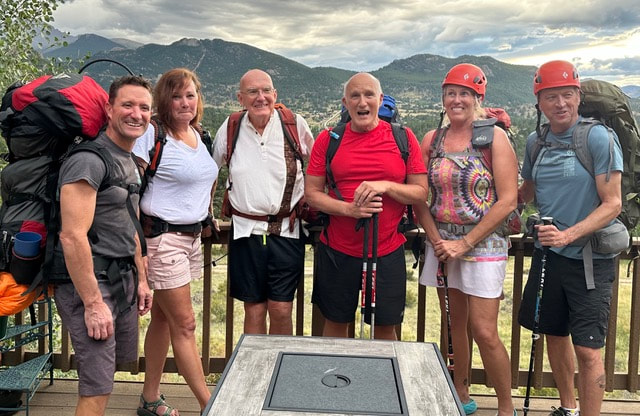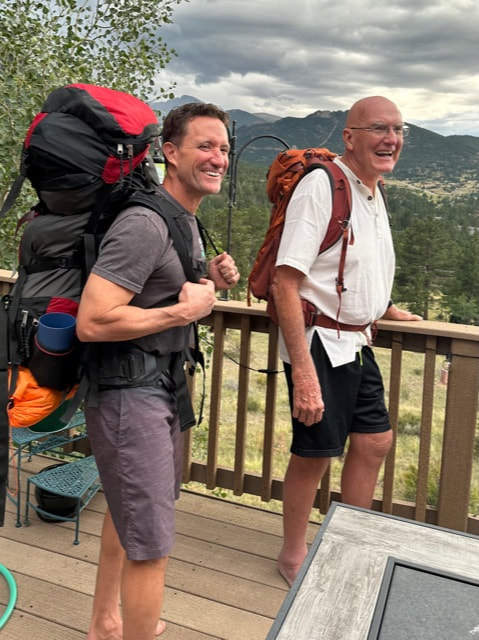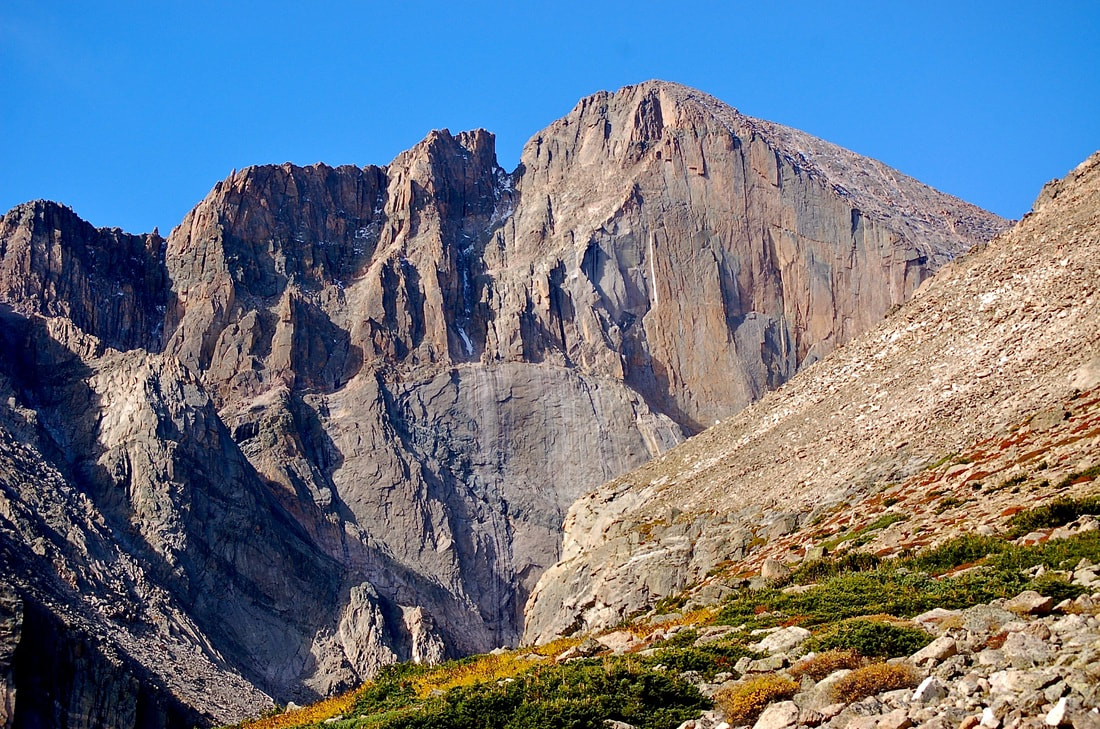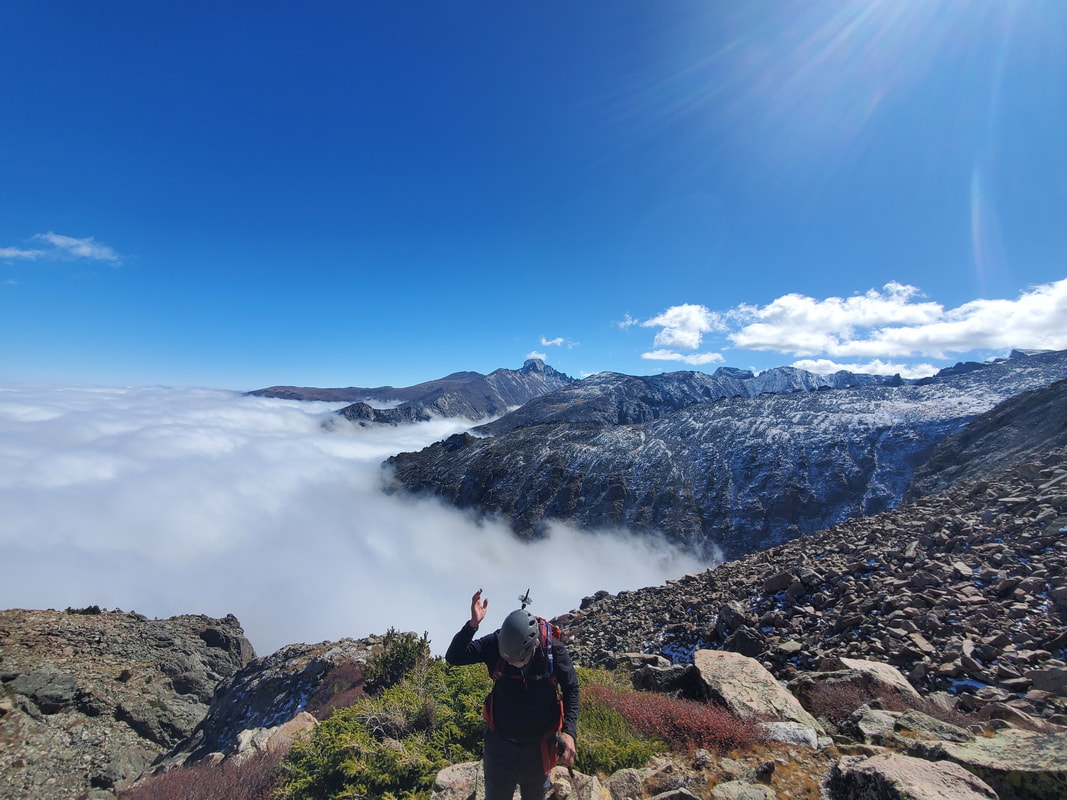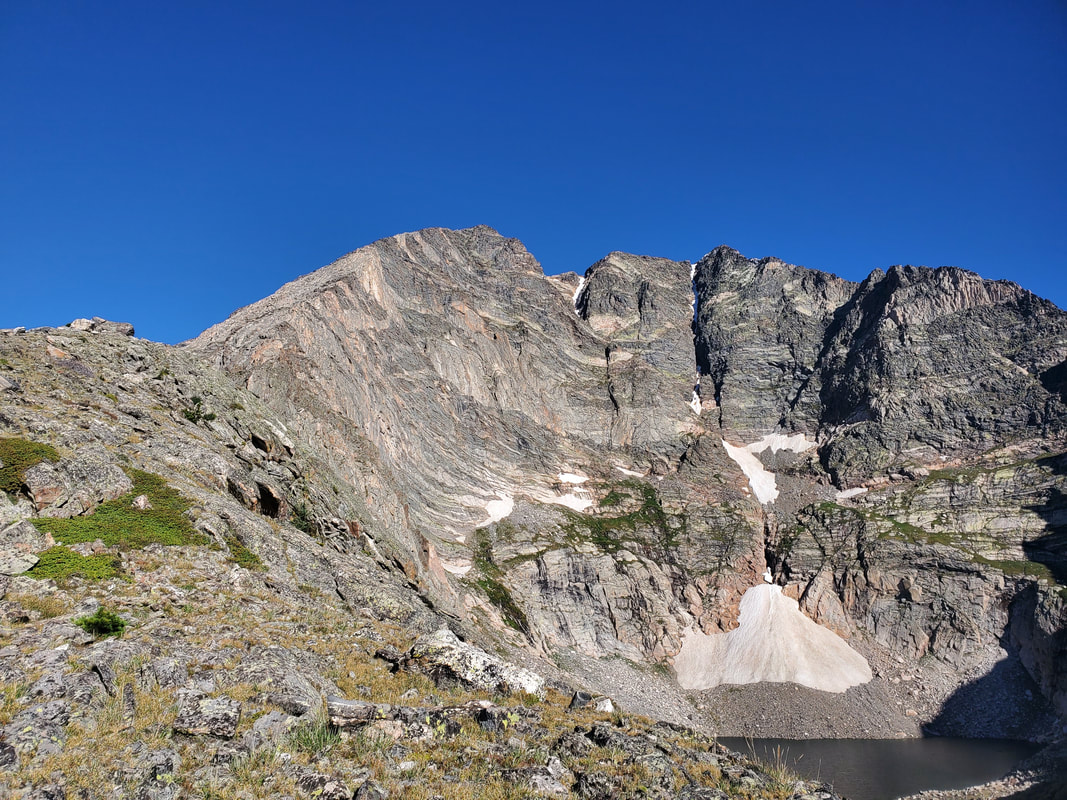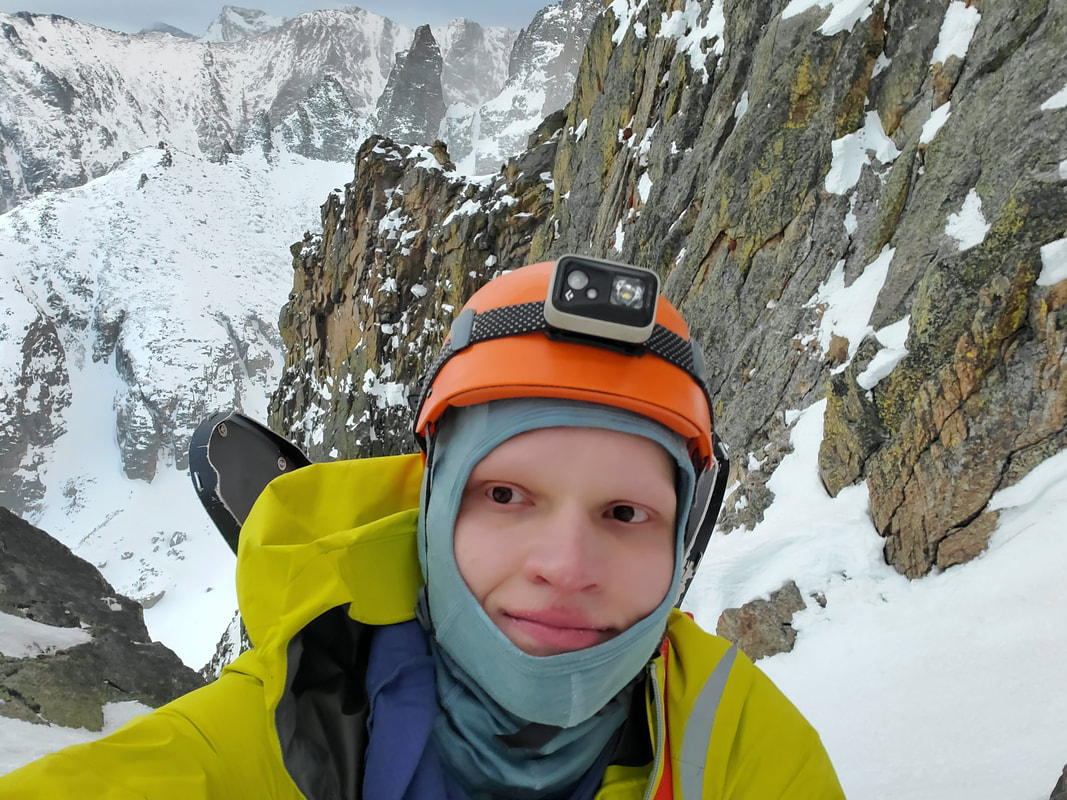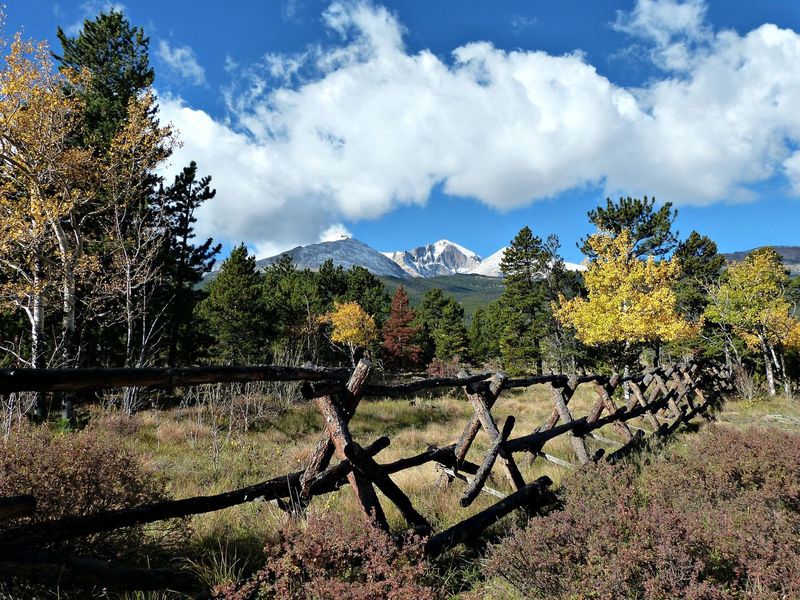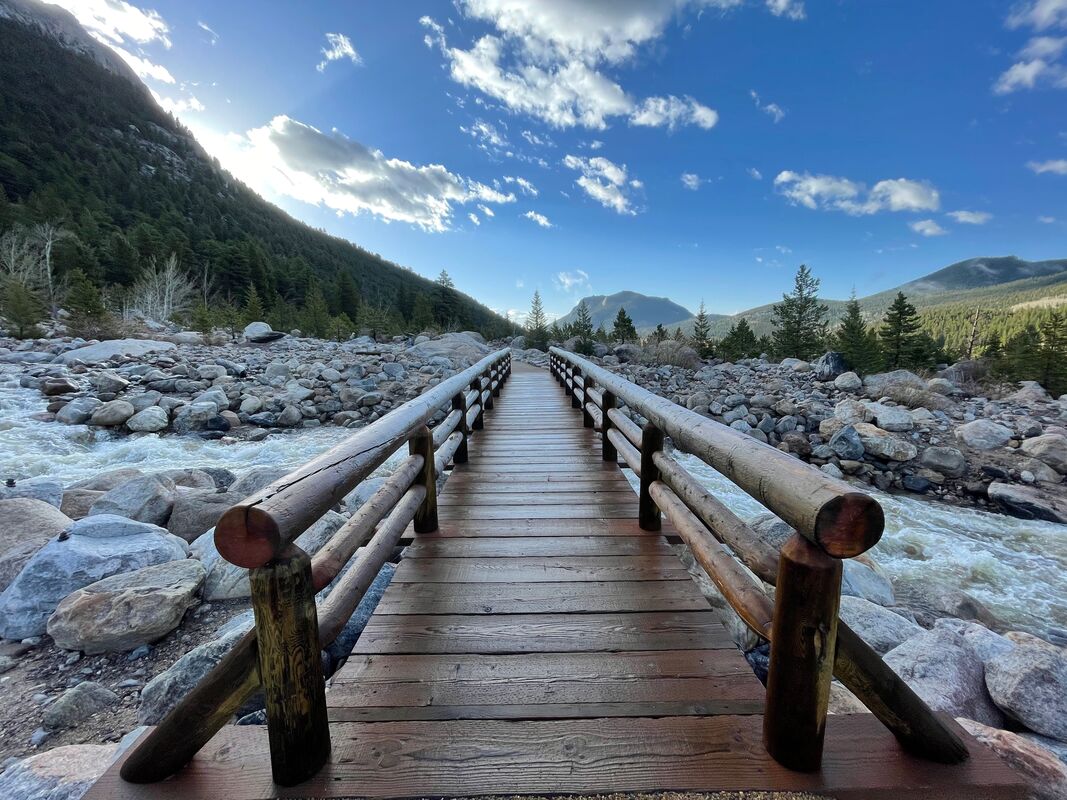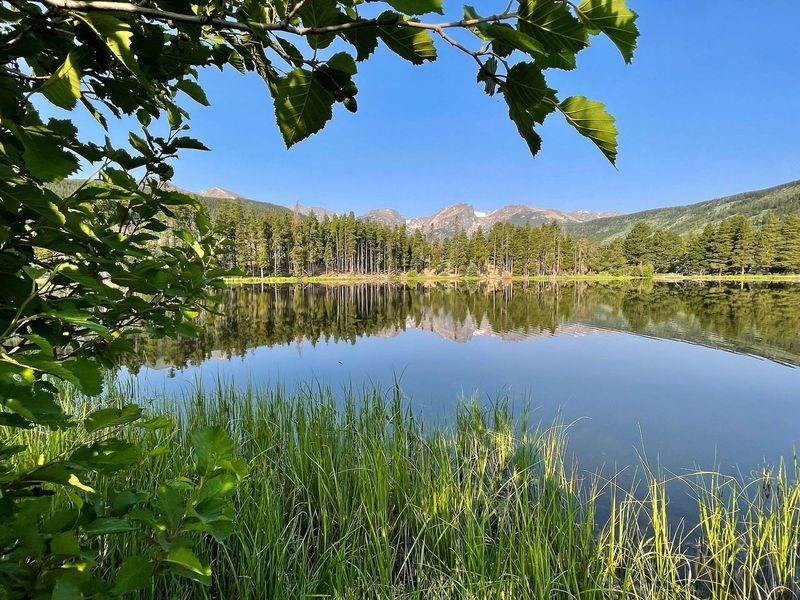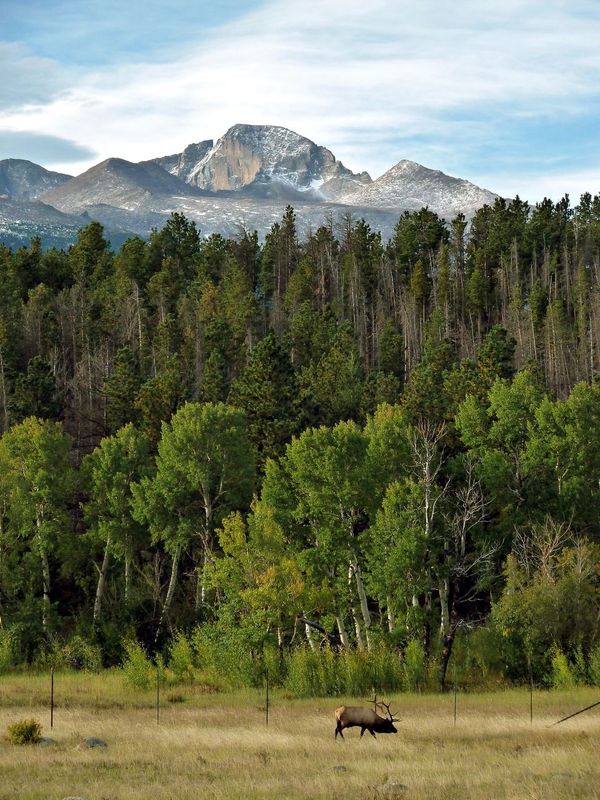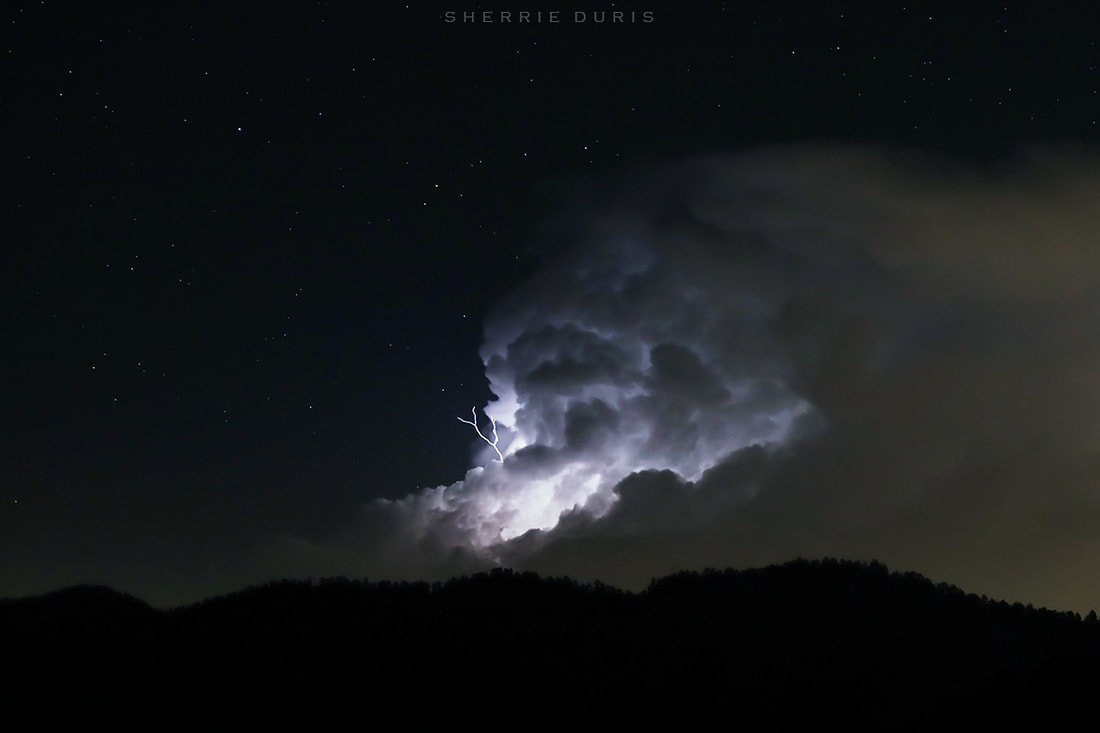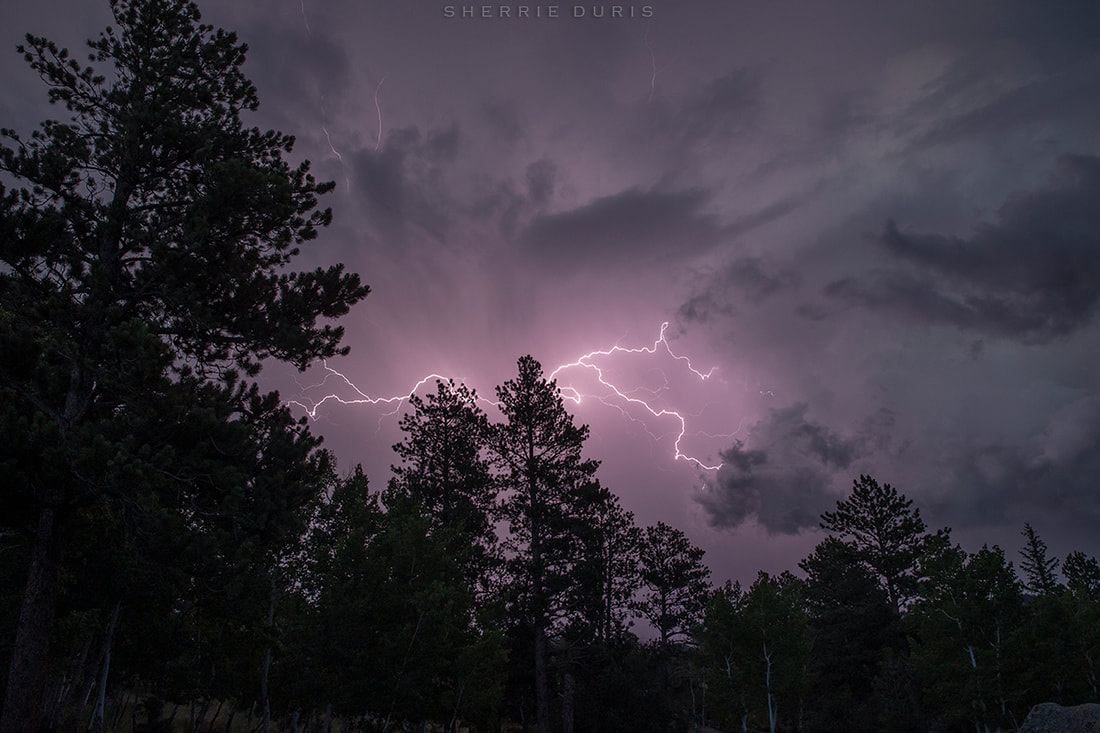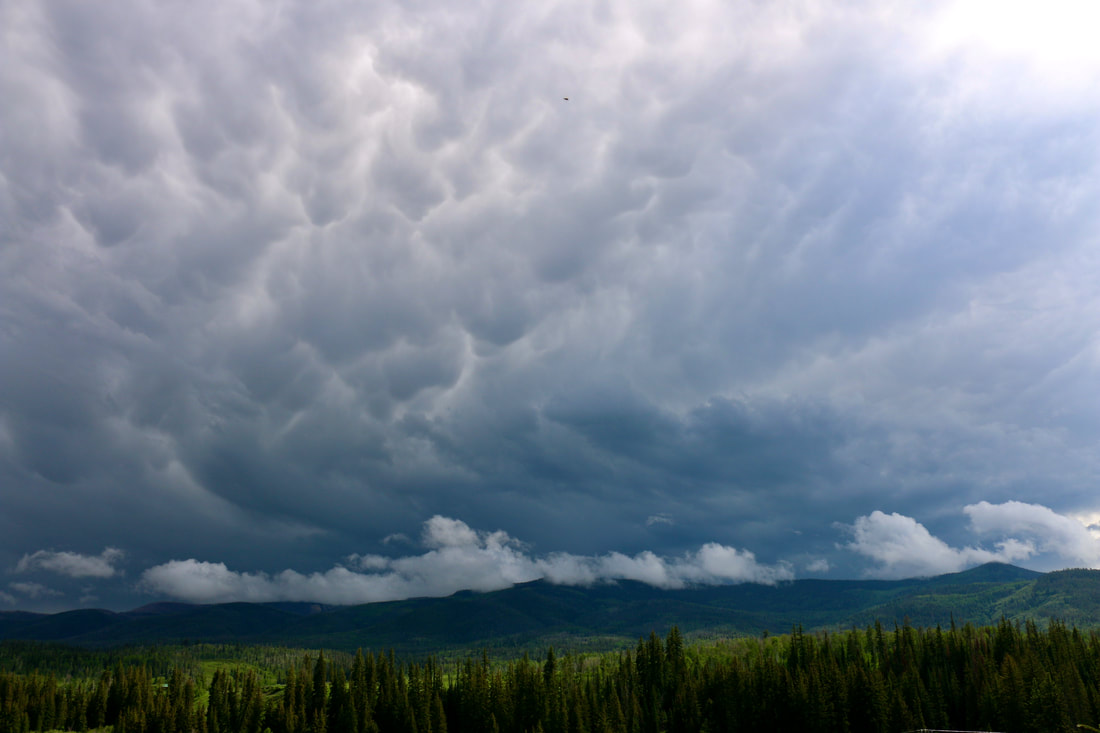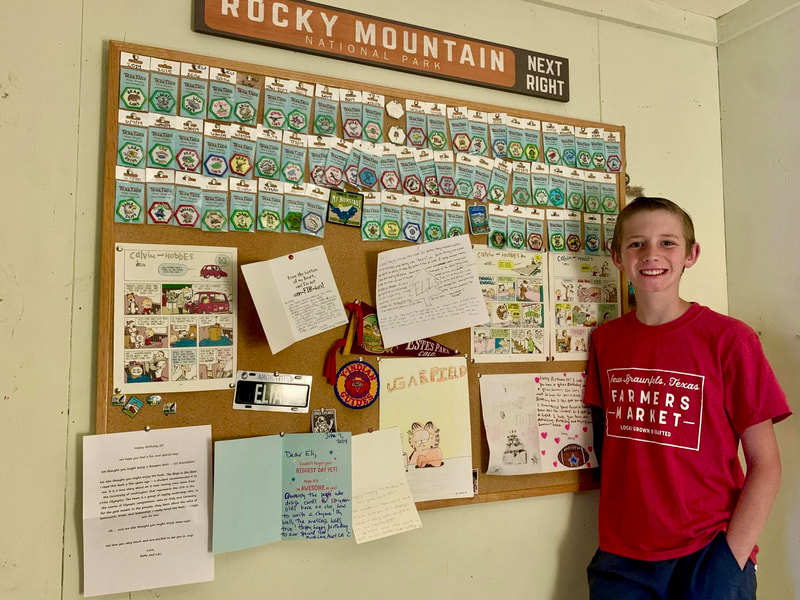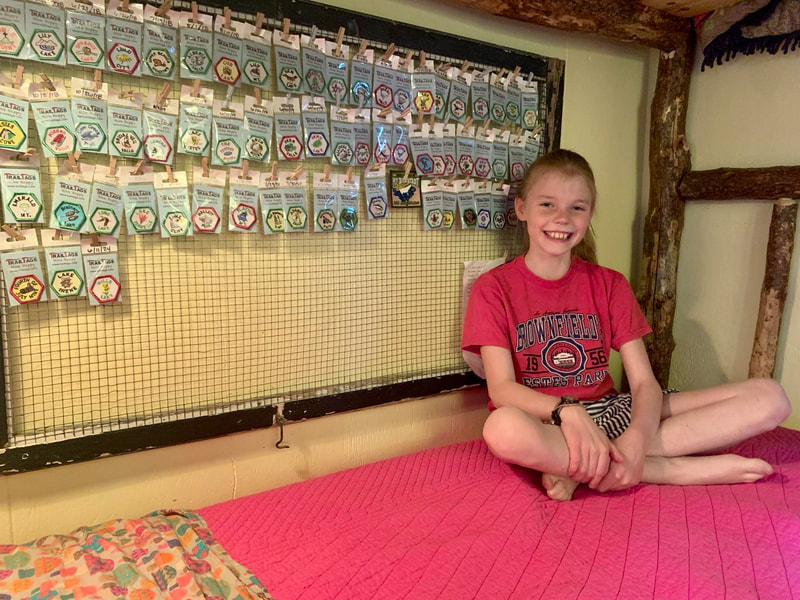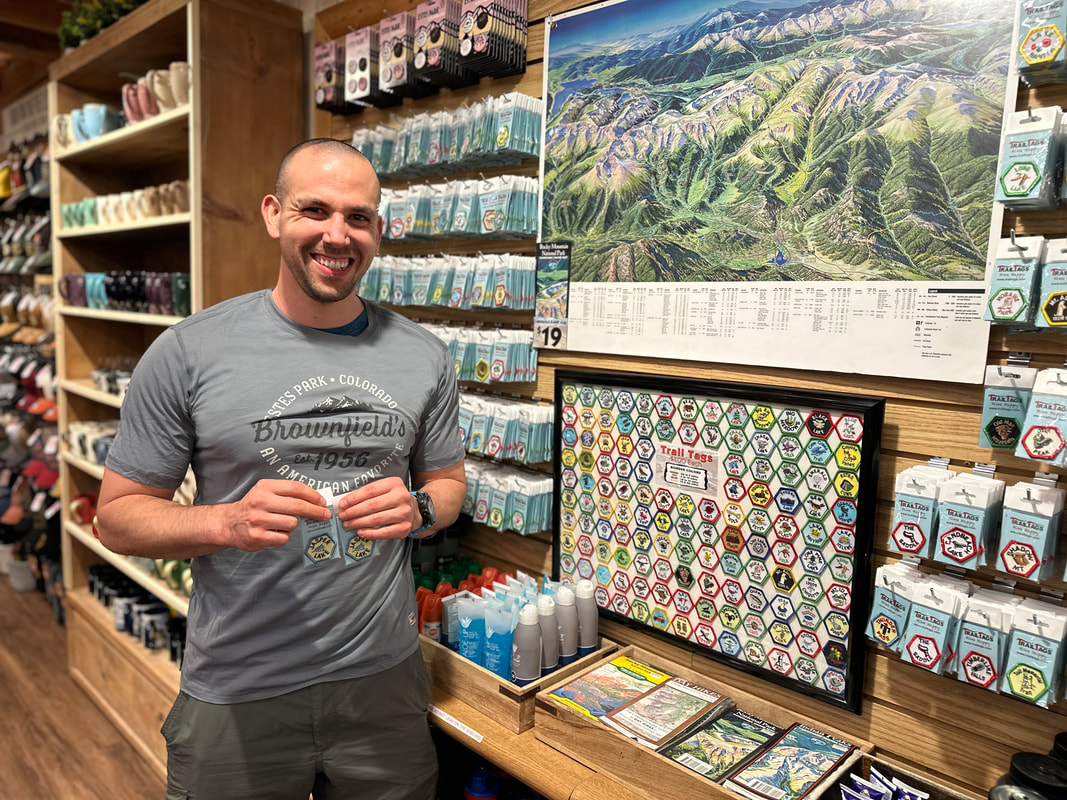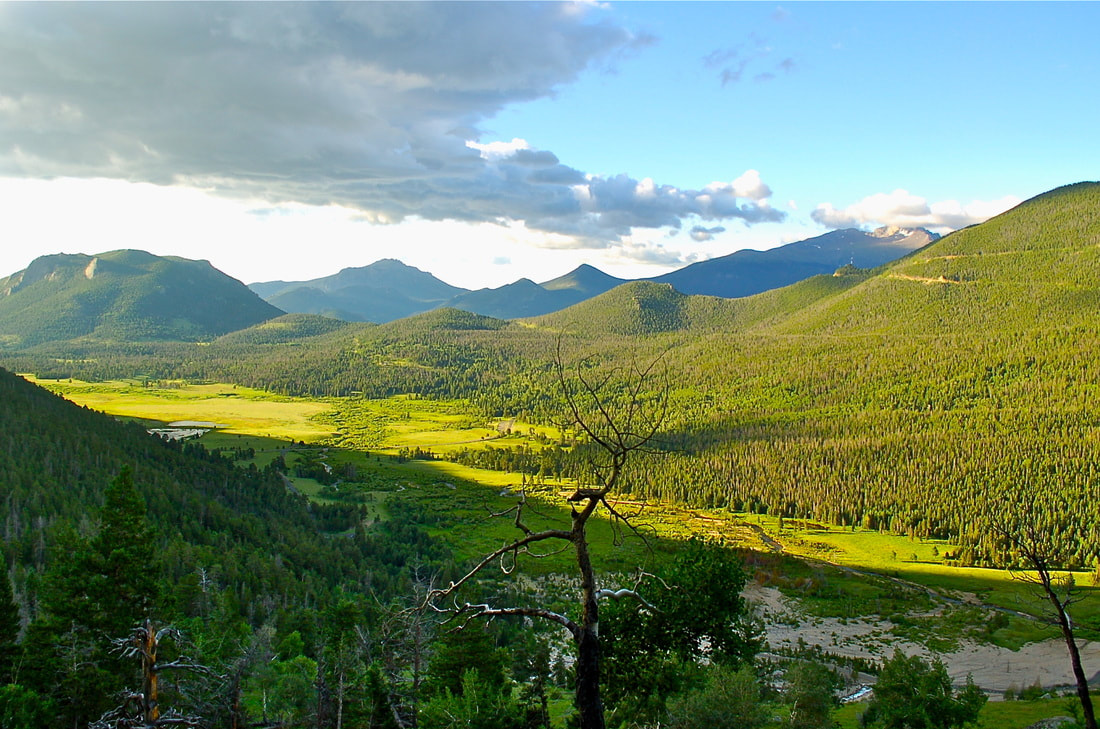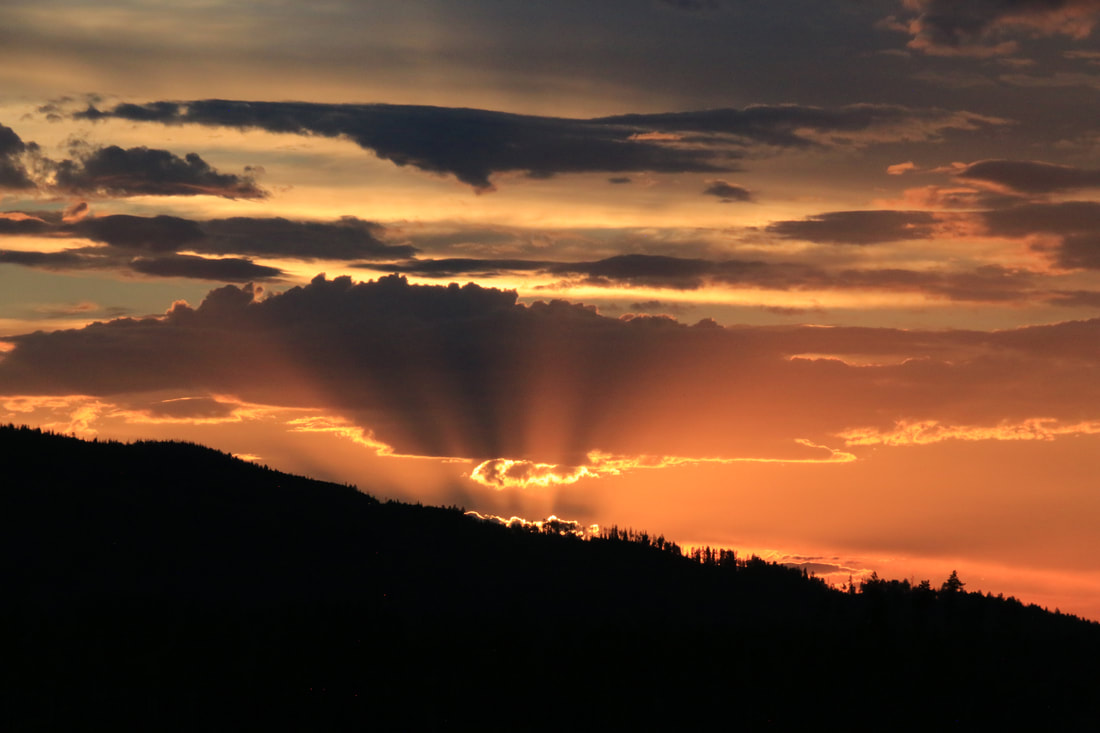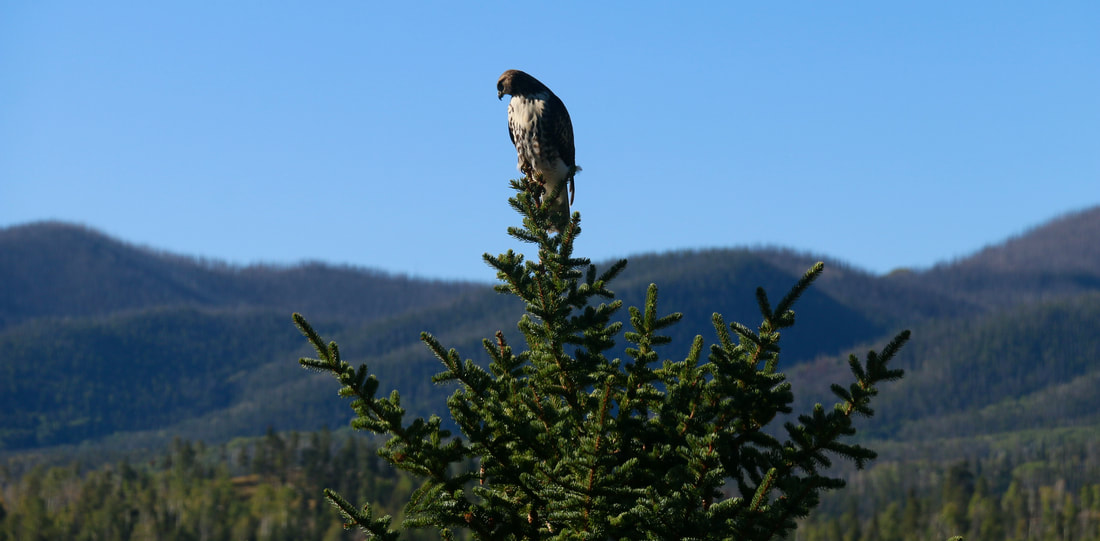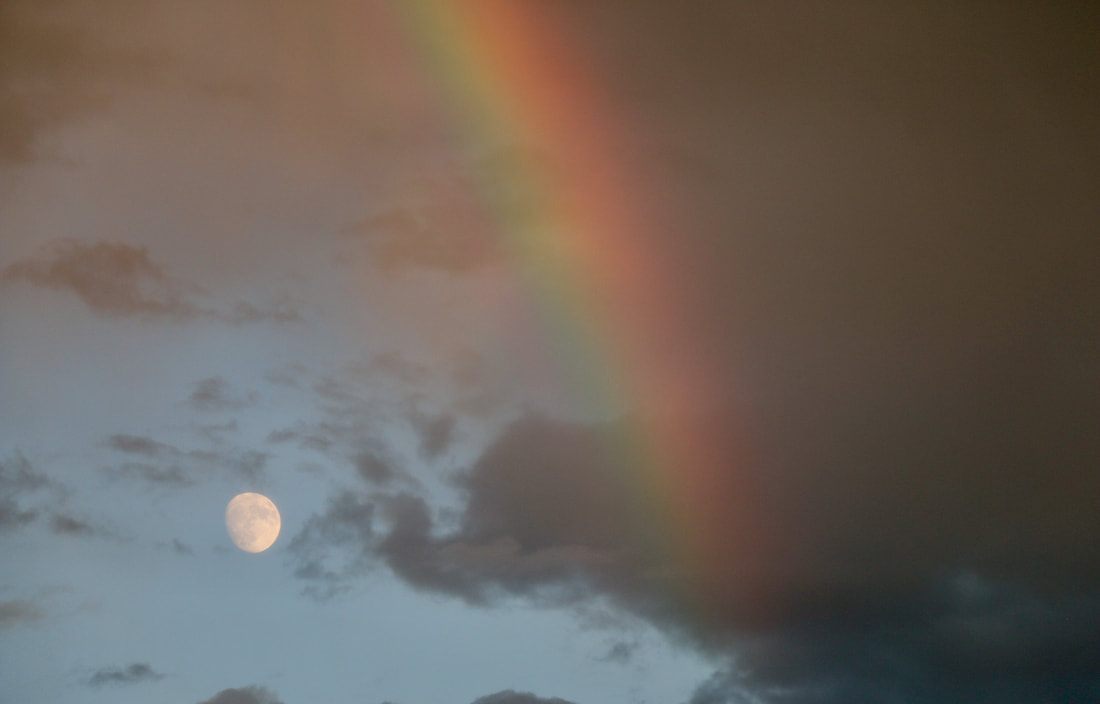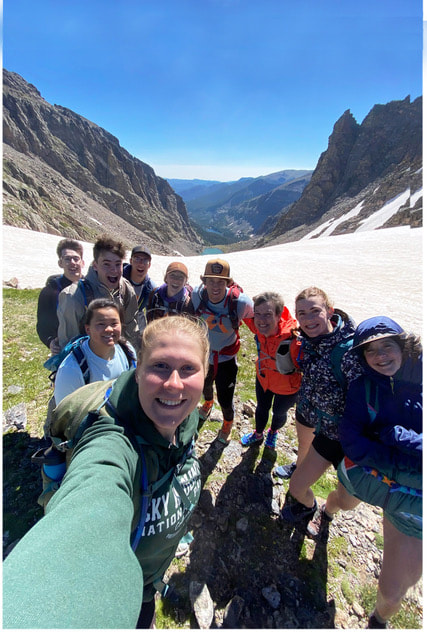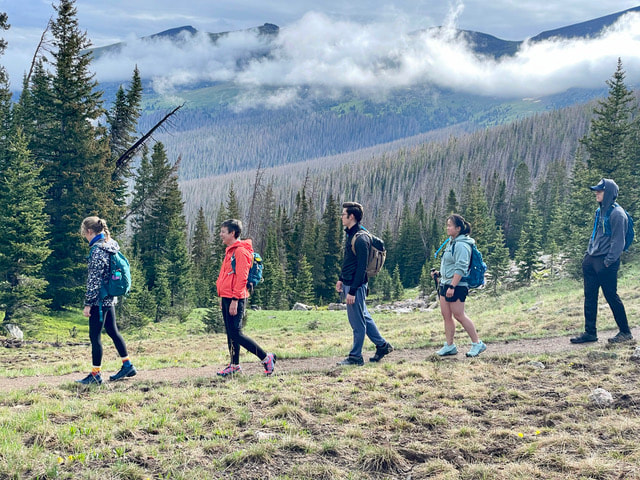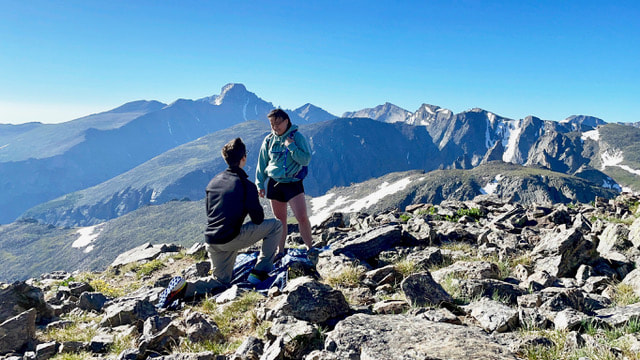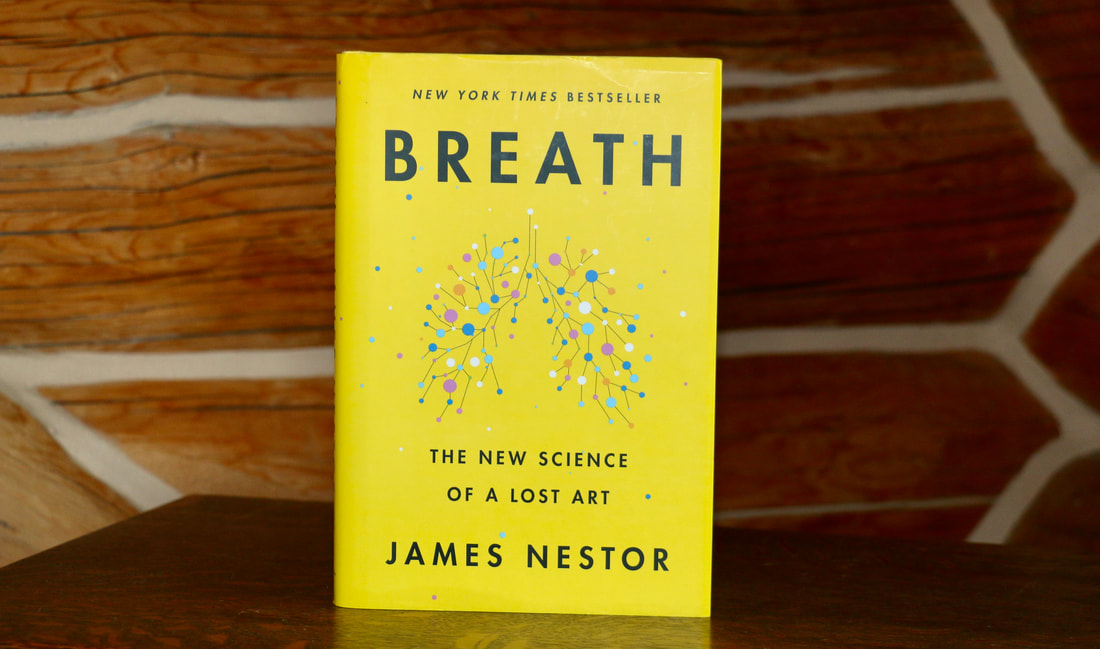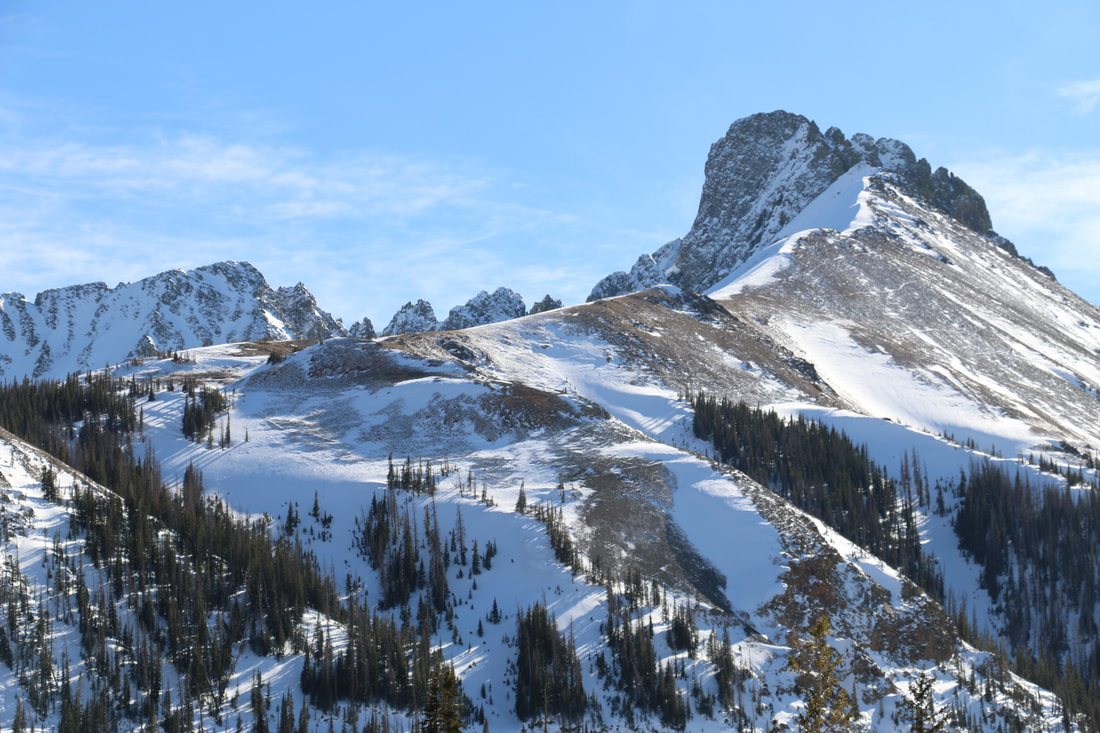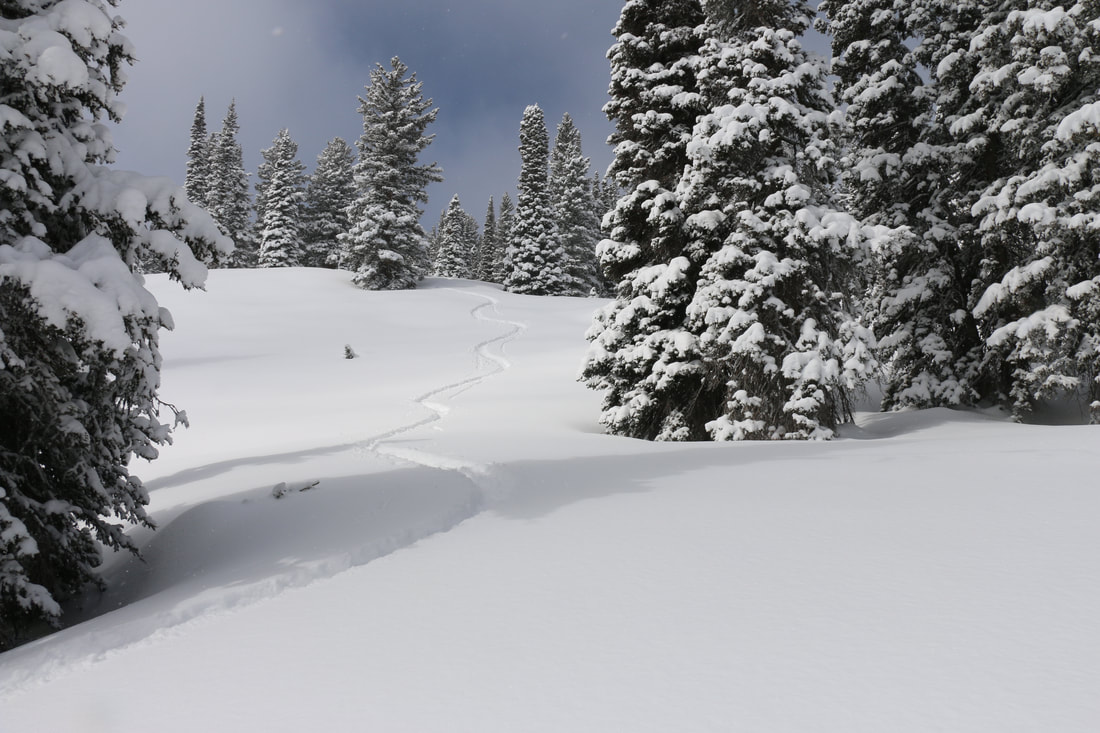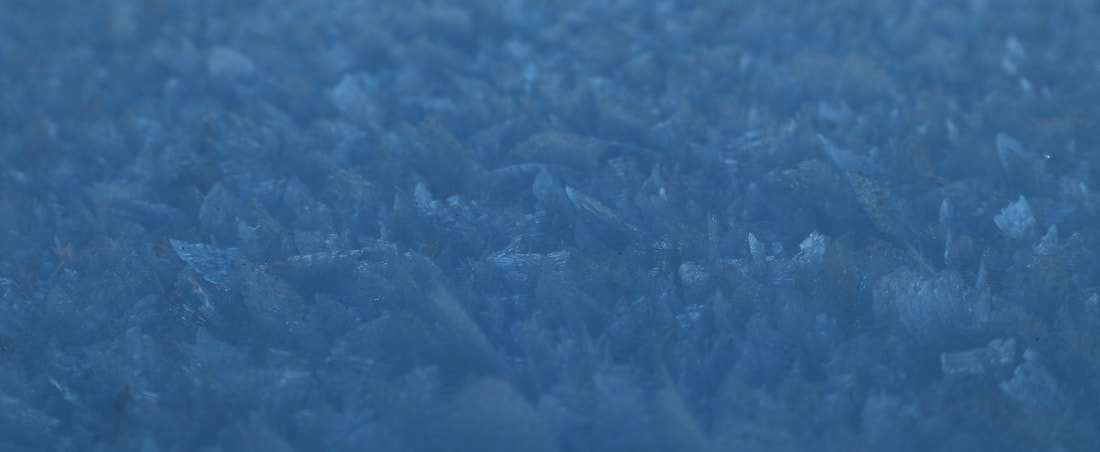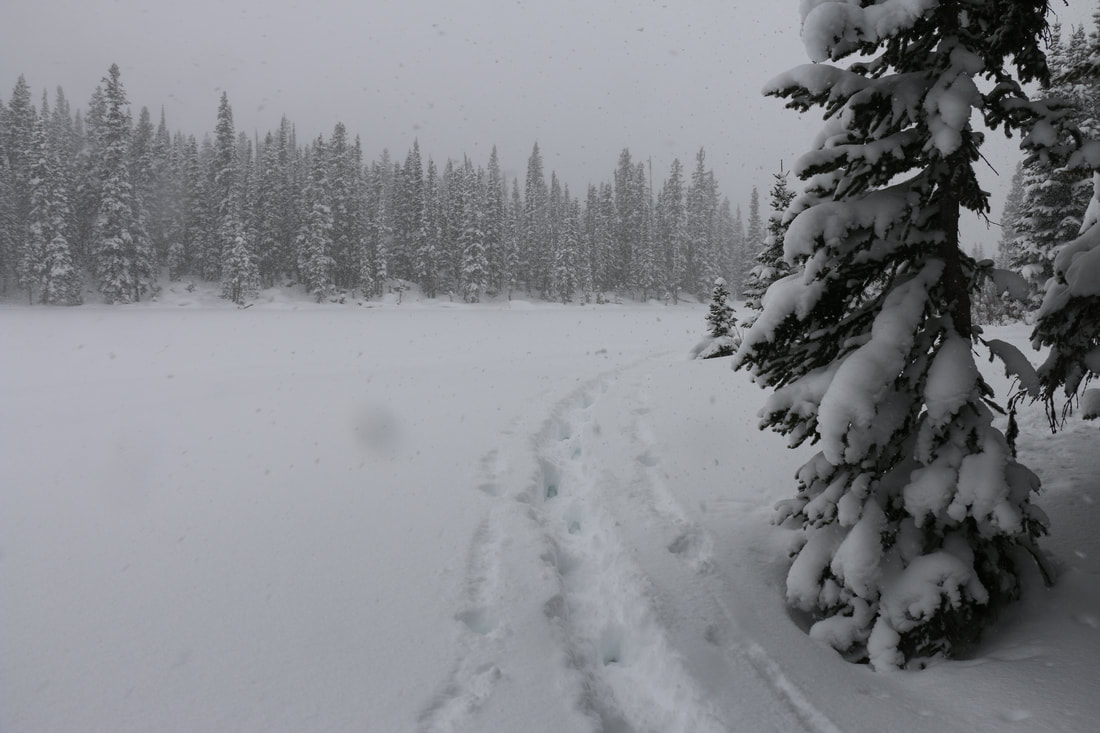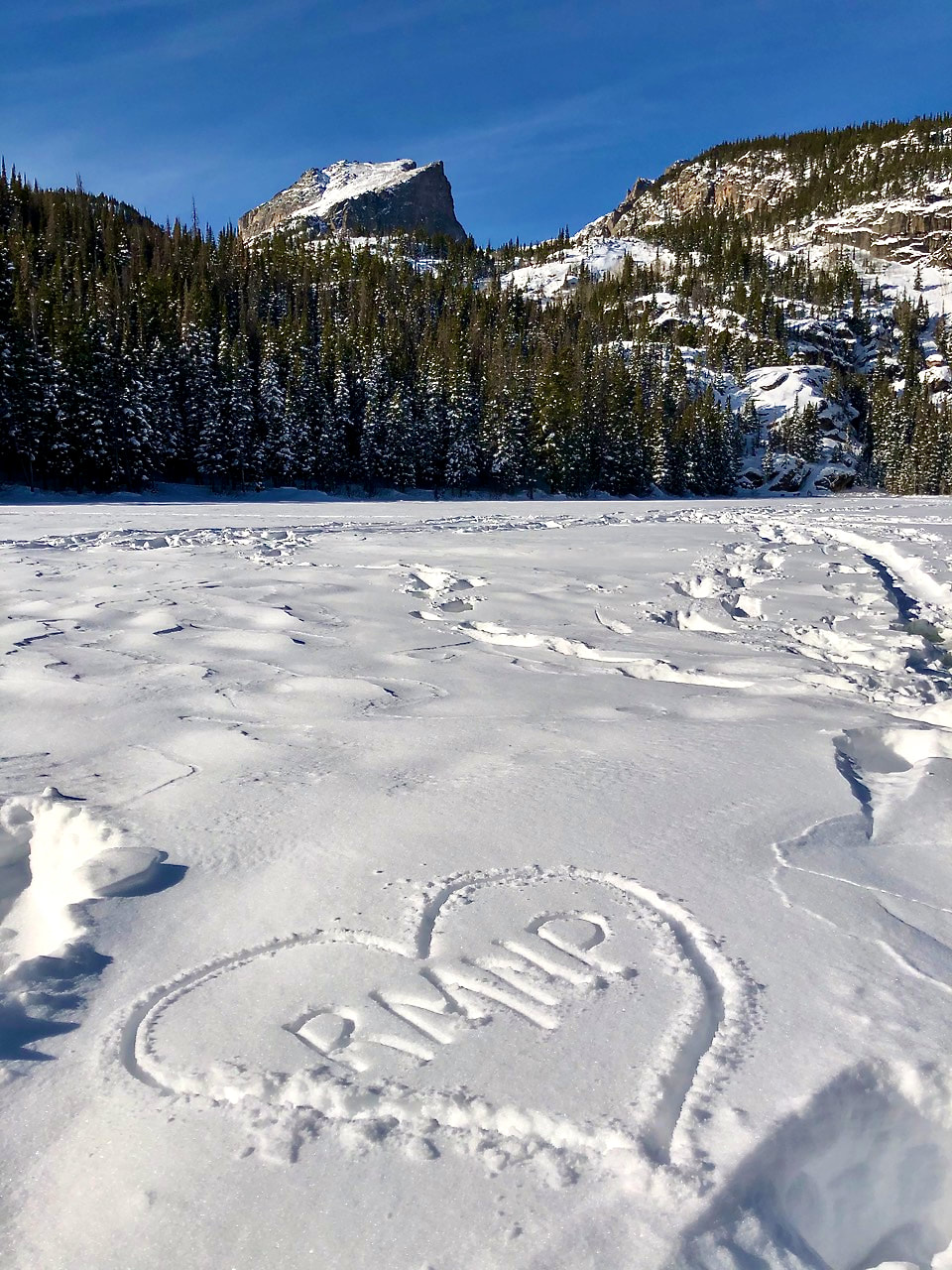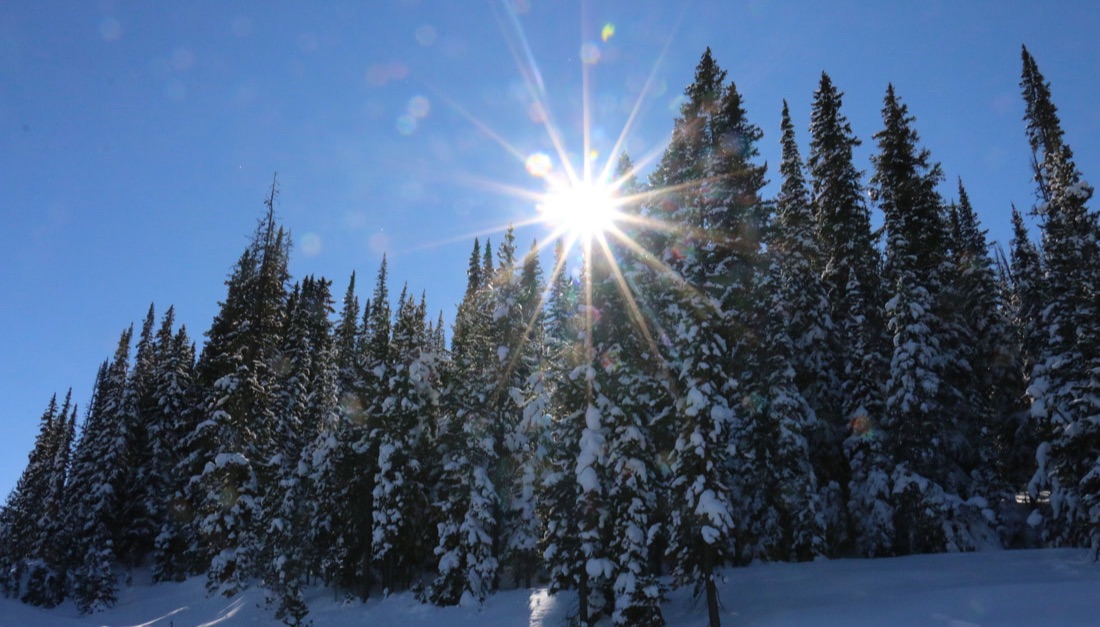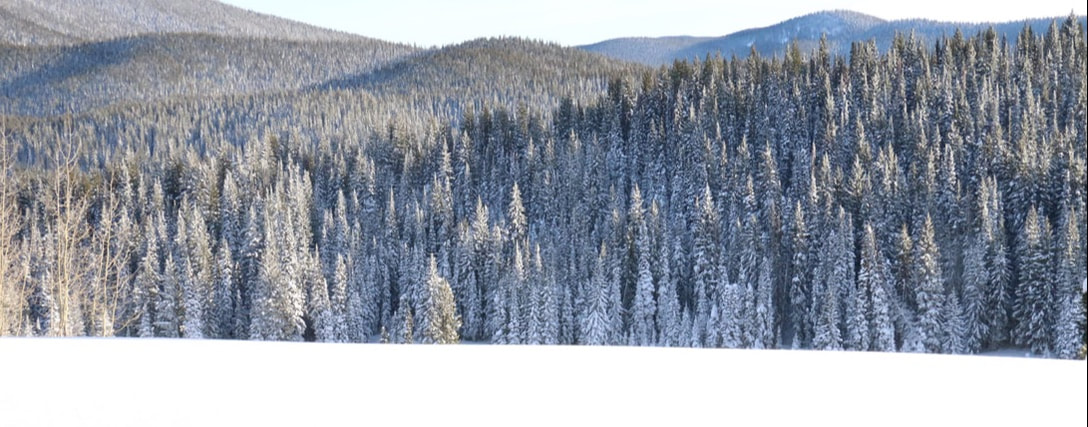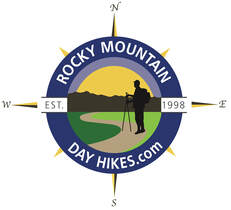|
Notes from the
Trail |
|
Chasing the Light: Best Places for Sunrise and Sunset in RMNP By Jamie Palmesano, Brownfield's The high country of Rocky Mountain National Park is famous for many things—towering peaks, alpine lakes, bugling elk. But for photographers and hikers alike, nothing rivals the drama of sunrise and sunset in these mountains. In those fleeting minutes, light transforms the landscape into glowing golds, fiery reds, and deep purples. Knowing where to stand—and when—makes all the difference. Here’s a guide to some of the best spots in RMNP to capture the park’s daily light show. Sunrise Hotspots Dream Lake (Bear Lake Corridor) Perhaps the park’s most iconic sunrise location, Dream Lake sits framed by Hallett Peak and Flattop Mountain. In early morning, the first light strikes the cliffs directly, while the lake mirrors the glow. It’s a short 1.1-mile hike from Bear Lake Trailhead, making it accessible for early risers willing to start before dawn. Arrive early—this spot is popular with photographers year-round. Sprague Lake For those who prefer less hiking in the dark, Sprague Lake offers a level loop with wide views of the Continental Divide. At sunrise, the still waters often reflect peaks like Taylor and Otis bathed in pink and orange alpenglow. The lake’s eastern exposure means the light arrives fast—have your camera ready. Trail Ridge Road Pullouts Above treeline, the pullouts between Many Parks Curve and Forest Canyon Overlook provide panoramic sunrise views over the Mummy Range. On clear mornings, the entire eastern horizon lights up, while valleys below often fill with fog. The catch: Trail Ridge Road is open seasonally. Chasm Lake For a more adventurous sunrise, consider Chasm Lake beneath Longs Peak. It’s a strenuous 8-mile roundtrip hike, but the reward is watching first light blaze across the Diamond, Longs’ famous east face. Few sights in RMNP are more dramatic. Sunset Showcases Moraine Park Known for its sweeping meadows and abundant elk, Moraine Park is equally renowned for sunsets. The valley floor opens wide views west toward the Continental Divide. Evening light often paints the sky in pinks and purples, while elk herds provide foreground action in September and October. Bear Lake At sunset, Bear Lake itself isn’t the main attraction—but the surrounding ridges catch evening light beautifully. Reflections on the water can glow warm orange just before dusk. For even better views, hike a short distance toward Nymph or Dream Lakes and turn back east as the sun dips. Many Parks Curve (Trail Ridge Road) This overlook is famous for its wide perspective eastward over Estes Valley. As the sun sets behind the Divide, the foreground forests and meadows are washed in soft twilight. On clear evenings, colors linger long after the sun disappears. Lily Lake Just outside the main park entrances, Lily Lake provides an easy access point for sunset photography. The lake sits beneath Twin Sisters Peaks, which catch the last light of the day. A loop trail allows for multiple angles—perfect for experimenting with reflections and silhouettes. Tips for Photographing Sunrise and Sunset in RMNP
Whether it’s the alpenglow igniting Hallett Peak above Dream Lake or the last golden rays washing across Moraine Park, sunrise and sunset in Rocky Mountain National Park are worth chasing. The moments are fleeting, but the memories—and the photographs—linger long after the light fades. So pack your camera, set the alarm, and let the park show you its best colors.
0 Comments
By Aaron Bojan Hike Rating: Hard Distance: 9.3 miles Elevation Gain: 2365 Feet (Editors Note: The destination for this hike in Rocky Mountain National Park is off the main trail and requires some backcountry navigation skills including map reading skills and an awareness of the lay of the land. These are sensitive areas, please travel carefully.) Shelf and Solitude Lakes sit high on a rocky bench above the Mills Lake to Black Lake Trail. Sitting at approximately 11,200 feet, Shelf Lake takes your breath away as you crest the final section of the trail. Solitude rests just above Shelf, nestled alongside the ridge, creating an awe-inspiring view surrounded by tall walls and a deep canyon stretching into the distance. Solitude sits at 11,400 feet. The climb to these two lakes is challenging, with an ascent of roughly 1200 feet starting at the creek and climbing to Shelf Lake. Starting at either the Bear Lake Trail head or the Glacier Gorge Trailhead, the trail passes Alberta Falls, one of the most magnificent falls in RMNP. Continue on the trail traveling beyond Alberta Falls, ascend the rock steps and around Glacier Knobs, Mills Lake, and Jewel Lake. Follow the Mills Lake path once you arrive at the junction of the Mills Lake and Loch Vale trails. Mills Lake is one of my favorite lakes in the park. From Mills Lake, you can discover seven additional lakes. The sweeping views of the drainage include Longs Peaks, Pagoda, Spearhead, and many others. Once you arrive at Mills Lake, take pictures and soak in the dramatic views. Follow the trail and continue past Mills towards Black Lake. You will pass Jewel Lake, which is worth taking a moment to enjoy this serene little lake. Continue towards Black Lake and enjoy the scenery on this winding and wandering trail. The trail that leads to the creek crossing to begin your ascent up the canyon wall to Shelf Lake is hard to find. If you have never taken this trail, having a downloaded map from AllTrails will help you find the exact place to cross the creek. Once you cross the creek, the trail will sometimes be clear, faint, marked with Cairns, and hard to follow. Keeping your phone close with your downloaded map from AllTrails will help keep you on track. The trail crosses downed trees, over rocks, and through rugged terrain; slow and steady is your friend. The challenging climb ascends nearly 1200 feet and ends with a final push to Shelf Lake. Climbing up the final rock steps leads to a much easier winding trail through a patch of Krumholtz over rocks to the Lake’s southeastern edge. The view reveals Shelf Lake, Thatchtop, and the falls flowing into Shelf. Looking to the left of Shelf Lake and the falls in the distance, find the faint trail leading over the outlet and over to the slabs to continue onto Solitude. There are many vantage points to capture unique and gorgeous views. Take the time to explore and wander before descending to the Black Lake trail and heading back to Mills Lake and the trailhead where you began your adventure. Completing this epic hike will bring exhaustion and exhilaration as you return to the Bear Lake Trail Head or the Glacier Gorge Trail Head. Once finished, you have earned a rest and some good food from one of the many great restaurants in Estes. Stop by Brownfields, grab the Shelf and Solitude trail tags, and share your adventure with Aaron, as he may be working the counter, helping guests discover the best hikes RMNP offers.  Aaron is the associate director at Crossroads Ministry in Estes Park. He loves hiking and exploring the lakes and peaks of RMNP. Since moving to Estes Park in 2016, Aaron has been exploring the trails of RMNP, discovering many gorgeous and exhilarating destinations worth the challenging hike. By Dawn Wilson owner DawnWilsonPhotography.com and Creeks and Critters Nature Tours (above photo: Sunrise at Sprague Lake. RMNP. Dawn Wilson) Mornings elude a calmness and beauty not revealed at other times of the day in Rocky Mountain National Park. The meadows may fill with drifting fog. The cool temperatures keep wildlife a little more active. And the sunlight bathes the east facing mountain peaks in pinks and purples. These five trails – from an easy flat trail for any skill level to an arduous trek into the backcountry – will be sure to evoke the serenity sought by those visiting Rocky Mountain National Park. Read through to the end for tips on planning and capturing sunrise images at any destination at sunrise. Sprague Lake Loop Trail One of the easiest yet most rewarding trails in the park, this flat, accessible path is only 0.75 miles long as it loops around Sprague Lake. With views of the peaks on the Continental Divide – Otis, Hallett and Flattop – that face east, picking a location on the east side of the lake will reward hikers with a pretty scene complete with an alpine lake, mountain vistas and verdant green mountainsides. The bonus at this lake is that the sunrise views are just as rewarding from the west side of the lake. Use some of the downed logs for leading lines in a photo or frame the image with a base of grasses showing early signs of fall as you enjoy the rising sun above the pine trees in the eastern sky. Moose, birds and mink frequent this location, making the destination a well-rounded experience of mountains, lake and wildlife in the cool morning air. This trail is located along the Bear Lake Corridor and requires a Timed Entry + reservation between 5 a.m. and 6 p.m. Dream Lake Trail This trail is one of the most popular in the park for good reason. The 1.1-mile trek to the lake introduces visitors to hiking in Rocky Mountain National Park while not being too overwhelming for inexperienced hikers or can be a perfect way to start the day before work. The trail offers stunning views, three lakes and wildflowers in summer. Starting at Bear Lake, the trail climbs about 500 feet from 9,475 feet to 9,905 feet on the eastern end of Dream Lake. Like the Sprague Lake Trail, this alpine destination includes views of Hallett Peak, Flattop Mountain and Otis Peak as well as Longs Peak and Keyboard of the Winds. All catch the morning light as the sun rises behind hikers in the eastern sky. Along the way to Dream Lake, hikers will enjoy views of Longs Peak – Rocky’s highest mountain at 14,259 feet – and see three of RMNP’s many lakes. To catch sunrise, however, head directly to Dream Lake first, and then enjoy the views of Longs Peak on the path down, stopping to enjoy the high mountain through the trees over Tyndall Creek, in the forest openings below Tyndall Creek, then above Nymph Lake and finally at Bear Lake. This trail is located along the Bear Lake Corridor and requires a Timed Entry + reservation between 5 a.m. and 6 p.m. Gem Lake Trail Unlike the previous two hikes, the best location for sunrise along this trail is not at Gem Lake but along the trail looking out over Estes Valley and towards Longs Peak. The trail to Gem Lake is a 3.5-mile out and back trail that climbs nearly 1,100 feet and ends at the small pond tucked in the granite domes of Lumpy Ridge. Gem Lake has no inlet or outlet streams or creeks, collecting all of its water from snowmelt and rain. To enjoy sunrise from the rocky outcroppings of Lumpy Ridge, start at the Gem Lake Trailhead along Devils Gulch Road on the northeast side of the park. The trail splits at the beginning, with the Gem Lake Trail veering off to the right. About a mile up the trail that navigates through ponderosa forest and stands of aspen, venture to the south as the trees open up and reveal wide vistas of the valley below and the peaks of the Continental Divide. Longs Peak will catch the morning light as the town below starts to stir at the beginning of another day. Enjoy the unique rock formations along this moderate trail, including Das Boot, a large granite boulder that resembles a boot with a hole in the sole. Deer Mountain Trail Similar to the Gem Lake Trail, the 6.2-mile moderate, roundtrip trail up to the top of Deer Mountain offers beautiful scenery at sunrise along the trail. Reaching the summit of Deer Mountain, at an elevation of 10,006 also rewards early-morning hikers with wide-open scenes that enjoy morning light and the potential for dramatic skies above the Continental Divide at sunrise. The trail starts near the junction of Trail Ridge Road/U.S. Highway 34 and South Navy Hill Road/U.S. Highway 36, passing through ponderosa forest before reaching an older aspen grove about a mile into the hike. Here the views of the Continental Divide, Longs Peak and Upper Beaver Meadows are reward enough to even make this the morning destination. Sunlight will wrap the peaks in alpenglow across the valley. Visit in early summer to catch the vibrant spring greens on the aspen trees or come in late September to catch the same trees in golden hues of fall. The trail to the top of Deer Mountain is a steady climb for most of the hike and then levels out at 2.4 miles. This is not the summit, however, which requires another short climb before reaching the highest point in another half mile. Chasm Lake Trail Located just below the diamond of Longs Peak, Chasm Lake is a strenuous hike, especially for reaching the lake at sunrise. But the effort reaps the reward of standing below this iconic formation as morning light illuminates the granite in warm tones. Starting at the Longs Peak Trailhead south of Estes Park on Colorado Highway 7, the 8.5-mile roundtrip trail climbs more than 2,500 feet. This trek requires an early morning start of about three to four hours before sunrise, depending on your speed and ability to hike in high elevations, to reach the lake for the first light of the day. If that seems a bit too daunting, shooting for Chasm Meadows at 3.8 miles from the trailhead is another ideal option to enjoy sunrise, where the Diamond of Longs Peak rises above the high alpine meadow. There is also a stunning view of the cirque above Peacock Pool far below the narrow trail and Columbine Falls cascading into the lower lake before reaching Chasm Lake. The final stretch to Chasm Lake includes views of the east face of Longs Peak before reaching the final steep rock scramble up to the lake. Standing on the east edge of the lake rewards hikers with the towering view of the summit of Longs Peak 2,500 feet above the lake. Capturing Sunrise Hiking into the backcountry of Rocky Mountain National Park for a sunrise experience requires some planning and good timing. If hoping to capture photographs of the experience, plan to arrive at the destination about 30 minutes before sunrise. This will allow you to scout for a location and set up camera gear to photograph the best light of sunrise, which happens about ten minutes before to ten minutes after daybreak. Use an app like Sun Surveyor to determine the time of sunrise and then check another app like Clear Outside or Windy for weather conditions during the hike and at sunrise. Ideally you want clear skies to the east and some clouds above the mountains for the most dramatic and colorful photos. For the best photographs, avoid blue sky days, which do not add a lot of interest to a sunrise image. For hikes like Chasm Lake that venture above tree line, plan to be below tree line on the way down before noon to avoid afternoon thunderstorms that can cause dangerous lighting for exposed hikers. Hiking through the park in the dark also requires good navigational skills and a headlamp with charged batteries. Plan on wearing layers of clothes as the day starts about 10-20 degrees cooler than the hike back to the trailhead. Bring a GPS navigational device to avoid getting lost in the dark, and always tell someone where you are going and when you will return in case a mishap does happen along the trail.
She has served as the president of the North American Nature Photography Association, was recognized as a Top Ten Female Nature Photographer to watch and is a member of Girls Who Click to help open the world of photography to aspiring young female photographers. To see more of her work and to inquire about tours, visit DawnWilsonPhotography.com or ccnaturetours.com. by Sharon Saternus Founder/CEO, Femme Trek: www.femmetrekltd.com Photo: Changing weather near Lake of the Clouds. RMNP. M. Selleck It can happen faster than you think. You miss a turn, lose the trail, or get caught in a sudden storm. Your phone has no signal, and the sun is dropping behind the ridge. In the backcountry, survival isn’t just about gear, it’s about mindset. As the owner of a guiding company in Rocky Mountain National Park, I’ve spent over 20 years exploring trails around the world in places like China, Tajikistan, Arizona, the Appalachians, California, and the Rockies. I know how quickly a hike can turn into something else entirely. That’s why I believe preparation isn’t just helpful; it’s essential, and it can make the difference between life and death. Survival Is Psychology First The first skill you need in a survival situation is keeping your mind calm. Your Positive Mental Attitude (PMA) is your most powerful survival tool. Survival psychology experts say that about 95% of people who die from psychological trauma in survival situations do so within the first three days. That’s also when most search and rescue efforts are successful. If you can hold on mentally, your odds of making it out alive are very good. That means resisting the urge to panic, act without thinking, or walk aimlessly just to stay warm. Those reactions burn energy, cloud judgment, and can lead you farther from help. STOP Before You Spiral The best tool you can use when things start to go sideways is a simple mental checklist: STOP. S: Stop. Sit down. Take a breath. Panic will only speed up the spiral. The first move is no move at all. T: Think. Ask yourself: What do I know for sure about my location, the time of day, and my physical state? When did I last remember being on the trail? What do I not know? O: Observe. Look and listen to your surroundings. Can you hear water? See landmarks? Hear people? P: Plan. Choose your next steps with intention. Will you stay put and signal? Turn back toward the last known trail marker? Move toward water or shelter? The most common mistake is to keep walking, either out of anxiety or just to stay warm. But that burns calories, breaks down your body, and increases disorientation. It’s surprisingly common for people to get turned around and unknowingly walk in circles. If you’re cold, build a shelter and stay visible. Even if you change your strategy later, having a plan puts your mind back in control. The Rule of 3s: Your Survival Priorities The Rule of 3s can help you prioritize your actions when your mind is racing and may be the difference between life and death. You can survive:
Even Basic Survival Knowledge Can Save Your Life Carrying key essential items like a knife, bivy or space blanket, paracord, water purification, a compass and map, a signal mirror, and a light can be a huge help in an emergency. But even hikers with limited gear have survived backcountry emergencies with the right knowledge, basic skills, and a clear mindset. A 2018 report by the Wilderness Medical Society concluded that most backcountry fatalities, even among seasoned hikers, were linked to inadequate preparation and limited survival knowledge. These findings emphasize that many of these tragedies could have been prevented with just a few foundational survival skills. Did you know that exposure is one of the fastest and most underestimated killers outdoors? In the Rockies, even summer temperatures can dip into the 40s or 50s. A drop of just two degrees in core body temperature can trigger hypothermia. Once you begin to shiver uncontrollably, your coordination falters and mental clarity fades creating a dangerous situation when you need to think clearly and act with intention. That’s why it’s important to know when and how to build a shelter, insulate your body, conserve energy, and signal. Take a course, practice key skills, and make sure you’re carrying the 10 Essentials, and just as importantly, that you know how to use them. Knowledge and skills are what buy you time. Being Found: Signaling If you’re lost, your number one goal is not just to survive, it’s to be found. The best signal you can leave behind is telling someone where you’re going, when you’ll be back, when they should start to worry, and who to contact if you don’t return. This simple step can dramatically shorten search time and may be the reason rescuers know to come looking in the first place. SOS beacons can be life-saving, but in many backcountry areas, it may still take hours or even days for help to arrive. That means staying alive, visible, and ready while you wait. Audible signals like whistles are helpful but considered secondary, since sound doesn’t travel far through dense forests or across ridgelines. If you’re using a whistle, remember the international distress signal: three blasts, followed by a pause, then repeat. For visual signals, your best bets are signal mirrors, bright-colored gear, reflective materials, movement, or signal fires. During the day, smoke is most effective. At night, use fire or headlamp strobes. If building fires, arrange three in a triangle or line the universal signal for distress. To increase your visibility, find an open area and spread out your gear. Create contrast against the environment with color and movement. Anything that flashes, flickers, or shifts catches attention, especially from the air. These are just a few of the strategies you can use. In a real emergency, knowing how to implement them calmly and effectively can mean the difference between staying lost and being found. What You Know Can Save You Survival knowledge isn’t about being a doomsday prepper or wilderness expert. Survival is a life-or-death situation that’s about keeping yourself alive in a backcountry emergency and knowing what to do to get rescued or get yourself out. The more you understand how to respond, the calmer you’ll stay, and the better your chances of getting home.
By Jamie Palmesano, Brownfield's all photos by OscarMike.org On any given summer morning, you might find a group of veterans rolling down the trail in Rocky Mountain National Park, fishing rods secured to the sides of adaptive chairs, laughter echoing off granite walls, and a sense of quiet determination in the alpine air. These are the Oscar Mike expeditionaries—injured veterans who have discovered that the wilderness doesn’t just heal; it frees. Oscar Mike, which means “On the Move” in military radio speak, is a non-profit founded by injured veterans for injured veterans. Their vision is a world without barriers, clearing a path for people living with disabilities by building adaptive facilities, expanding adaptive programs, and creating a library of content to help people learn to adapt everything—whether that’s a fishing technique, a workout, or a trail route. And every other week during the summer, Estes Park becomes part of that vision. Through adaptive camping, fly-fishing, hiking, and guided interpretive tours, Oscar Mike’s Unplugged Experiences in Estes Park and Rocky Mountain National Park offer veterans the chance to make memories they didn’t think possible. Teamwork is at the heart of these custom mountain expeditions, providing fun, challenge, and healing while focusing on building psychological and physical independence. One of the best parts of Oscar Mike expedition weeks is the solitude of sleeping in nature. Using accessible backcountry campsites, these veterans experience the hush of the Rockies under a star-filled sky, a space of quiet dignity where barriers fall away, even if only for a few precious days. At Brownfield’s, we connected with the Oscar Mike team through Trail Tags, which the expedition leaders purchase for each participant to mark the trails they conquer during their time in town. We’ve had the privilege of meeting Patrick, Arthur, and Kim, three of the leaders who guide these transformative journeys. Their passion for Oscar Mike’s mission and for the injured warriors they serve shines through in every conversation. Patrick Tocco, the Program Manager said, “Our Veterans share a deep connection with the life up on the Tundra. "Resilient yet fragile." Resilient enough to survive the harsh environment around it, yet they can take up to a decade or longer to recover from trauma. Handing them that trail tag after trekking Toll Memorial is just a small reminder of just how great and capable these men and women still are.” We are deeply grateful that Oscar Mike is bringing people from across the country to Estes Park, giving them the chance to unplug, unwind, and discover the magic of these mountains. Here, amidst the pines and peaks, they find refreshment for their souls—and so do we, simply by witnessing their courage. If you get a chance, visit oscarmike.org to learn more about this impactful organization, the veterans they serve, and how you can support a world where a wheelchair or prosthetic is never a reason to miss the breathtaking views of the Rockies.
By Jamie Palmesano, Brownfield’s all photos by Jamie Palmesano There’s nothing quite like introducing kids to the beauty and wonder of the Rocky Mountains. Whether it’s the roar of a waterfall, spotting a marmot sunning on a rock, or seeing a perfect reflection in an alpine lake, Rocky Mountain National Park (RMNP) is full of moments that ignite curiosity and joy. June is a perfect time to bring the whole family out on the trail—just as the snow melts and wildflowers begin to bloom. If you're looking for short, rewarding, and scenic hikes that are manageable for children (and enjoyable for adults), here are five tried-and-true favorites inside RMNP. 1. Alberta Falls (1.6 miles round trip) Trailhead: Glacier Gorge This crowd-pleaser is great for families wanting a big reward for minimal effort. The well-marked trail winds through aspen groves and pine forests as it opens up to a spectacular 30-foot waterfall tumbling into a rocky gorge. Kids love the sound and spray of the falls, and there are plenty of safe boulders nearby for a snack break. Pro Tip: The Glacier Gorge lot fills up quickly. Hop on the free shuttle at the Park & Ride to be dropped off at the Trailhead. 2. Adams Falls (0.6 miles round trip) Trailhead: East Inlet (near Grand Lake) Short, dramatic, and ideal for younger hikers, this trail leads to a stunning cascade in under 10 minutes. The thunder of the falls is exhilarating, and the surrounding aspen groves offer a beautiful contrast to the alpine forests elsewhere in the park. This hike is on RMNP’s quieter west side, offering a peaceful experience in early summer. Nearby Tip: Spend some time in Grand Lake afterward—a fun and family-friendly mountain town. Stop at the various pull-offs along Trail Ridge Road and enjoy America’s highest continuously paved road. 3. Dream Lake (2.2 miles round trip) Trailhead: Bear Lake This iconic alpine lake is accessible by a trail that climbs gently past Nymph Lake and offers striking views of Hallett Peak and Flattop Mountain. Dream Lake lives up to its name, especially when the water is still and reflects the peaks above. Snow can linger into June, so bring traction devices if it's been a snowy spring. Why Kids Love It: Wildlife sightings are common—chipmunks, trout, ducks, and even the occasional elk at lower elevations! 4. The Pool (3.4 miles round trip) Trailhead: Fern Lake (via Moraine Park) A little longer but relatively flat, the trail to The Pool follows the Big Thompson River and crosses meadows where elk and turkeys roam. At the destination, kids can explore the large swirling eddy where Fern Creek meets the river. It’s a great spot for skipping stones, putting your hands in the water, resting, or simply enjoying the river’s music. Bonus: Along the way, stop by Arch Rocks—massive boulders that look like nature’s playground. 5. Cub Lake (4.6 miles round trip)
Trailhead: Moraine Park For families with slightly older kids who can handle a longer trek, the hike to Cub Lake is a fantastic adventure. The trail weaves through meadows, wetlands, and woodlands before arriving at a lily-pad-covered lake surrounded by rock walls. Wildlife is abundant, especially in June, with elk, ducks, moose, and beavers making appearances. Adventure Angle: Turn this into a “junior naturalist” hike—have kids look for animal tracks, identify wildflowers, or sketch the scenery. by Murray Selleck There is a small window of opportunity to bike Rocky Mountain National Park’s (RMNP) Trail Ridge Road with virtually no motor vehicles. This brief time frame is after the huge snowblowers have cut their way through the massive snowdrifts across the top but before the gates on the Estes Park and Grand Lake sides of the park have opened. There is a trick to accomplishing this ride and, of course, it’s called timing. Each year RMNP opens Trail Ridge Road to all comers around Memorial Day. Passenger cars, Sprinter vans, huge motor homes, trucks with tow-behind trailers, and all manner of vehicles will soon be driving up and over this beautiful road. Once the gates are open to motor vehicles riding a bike on Trail Ridge is a gamble at best. Distracted drivers, narrow lanes, minimal shoulders, not many guard rails, steep drop-offs, and if you happen to have the bad-luck timing of one car passing you with another car oncoming this three-way-squeeze is harrowing at best! Weather has everything to do with timing this ride. Ideally, the road is completely plowed all the way across from Grand Lake to Estes Park before starting up. This gives you more options as far as how much elevation to climb and how far across you may want to ride. So once the road is cleared the next thing to do is watch the weather reports. When your weather window of opportunity appears don’t delay. You may not get another chance. One year a late May snow storm rolled over RMNP dumping and drifting a couple feet of fresh snow across Trail Ridge Road. By the time the road crew had cleared the road a second time it was already past Memorial Day. The gates opened and I missed my (mostly) vehicle-free chance to ride. (Note: You may encounter a handful of official RMNP vehicles on the road as they prepare to open Trail Ridge). In years past when the stars aligned and I’ve ridden Trail Ridge the ride has always been a highlight of my biking season. I look forward to it every year. The best way to describe biking Trail Ridge Road is it’s always an adventure. Each time is different and offers an opportunity to experience the subtle nuances and dramatic power of RMNP. The one given is to be prepared for everything. Bring plenty of warm/breathable layers for the climb up. Pack windproof shells for the ride across and descent. Have plenty of water, some energy snacks, gloves, a thin thermal hat to fit under your bike helmet, front and rear safety lights, and tuck in a measure of endurance. You’ll need all of this gear and plenty of resolve, as well. From either side of the park you’re looking at a minimum of 4,000 feet of lung sucking climbing to get to the top. The higher you climb the colder it will become. As you leave treeline behind count on the wind to pick up. They will swirl and gust from all directions and try their best to blow you off your bike. I have experienced winds so strong I’ve been blown from one side of the road to the other. As morning turns to early afternoon watch for the clouds to build blocking any warm sunshine and perhaps containing snow and thunder and disappointment as you see your idyllic day turn potentially hazardous. Make a few mental notes of where running rivulets of water from melting snow are crossing the road. On your way back down what was once water may have returned to ice. Check your speed because road bike tires on black ice is a prime spot to send you sliding. I’ve ridden up there leaning my bike into stout crosswinds struggling to keep myself upright only to have the wind suddenly let up causing me to swerve into empty air and just as quickly crosswinds from the opposite side hit me accelerating that swerve to the edge of the road and a drop off. Unnerving to say the least! I’ve also ridden in cold sunshine with snowflakes flying and my fingers so numb I couldn’t feel my brake levers. And then there are the rides on Trail Ridge with endless blue skies and warm chinook breezes and horizon to horizon beauty that makes me want to ride Trail Ridge again and again. I’ve climbed up the numbered switchbacks, over Milner Pass and the Continental Divide, pedaled 180 degrees around Medicine Bow Curve while catching my breath and checking my motivation seeing all the climbing and elevation gain yet to come, paused for a weather check at the Gore Range Overlook, felt great at Tundra Curves and Iceberg Pass, free-wheeled through the impressive Rock Cuts, and then begin the turn around calculation. How much farther across should I ride before I have too much climbing to do to get back up?
Wish us all weather luck when biking Trail Ridge this year. If I see you up there wave as we pass pedaling at 12,000 feet elevation - practically motor vehicle free. That’s pretty darn close to heaven. Side Notes: Here is the link to RMNP’s website page on biking the park: https://www.nps.gov/romo/planyourvisit/biking.htm Also, Yellowstone National Park and Glacier National Park offer similar biking opportunities on their iconic roads. Make a road trip out of it and ride all three this spring. Yellowstone NP: https://www.nps.gov/yell/planyourvisit/bicycling.htm Glacier NP: https://www.nps.gov/glac/planyourvisit/bicycling.htm by Dave Rusk
Upon seeing the Pasque flowers in the lower elevations of Rocky Mountain National Park, I often feel an emergence of my own, my inner hiker, longing for the trails of summer; even though they are still reporting 53” of snow at Bear Lake, with hopefully more spring snow on the way, I know it won’t be long. Will I be ready when the trails open up? Those early spring flowers are a reminder to prepare; I need to check my gear list, as well as my physical well being. But overall, I have seldom needed to concern myself with my physical ability to get out and hike. Until last fall. At the end of some of our longer hike days, I noticed a pang in the bottom of my right foot. Oddly, the pain grew worse after returning home and resting for a bit. I would often limp off for the kitchen, barely able to make it for a coffee cup refill. However, within a day or two the pain subsided and once again I felt ready for the next hike. After a few more weeks of fall hiking, the pain started coming earlier in the hike day until one day in late October, I was hiking all day with the dull pain. And then it stopped going away! It was time to give my foot a rest.
What surprised me was that the solution to the pain in the bottom of my foot was 8 inches away in my calf muscles. Searching, I first found an exercise where all I had to do was roll a frozen golf ball under my foot, but I experienced no change from doing that. A further search lead me to an article by Hiker Guy.com. That article included a 10 year old video on Self Massage for Plantar Fasciitis made by Bruce Mandelbaum. He recommended cross fiber friction, massaging across the calf muscles with the thumbs to break up the fibers. That worked great! Right away I noticed the pain starting to subside. Wanting to go further, I went for a visit with Patrick Martchink at the Estes Park Physical Therapy. He showed me, among other techniques, how to stand with my feet on a slightly angled up board stretching the calf muscles. Wow! That felt really good too. I had no idea how good it felt to massage and stretch my calf muscles. I had not recognized the tightness going on with those muscles. But now I stand daily on my slanted board, if only for a few moments, getting a little stretch on my calf muscles while I look out my window, waiting for my coffee water to heat up. I wondered what other stretches I might do for other hiking muscles. I had been noticing a little tightness on the top front portion of my legs, the quadriceps, and in particular the rectus femoris I think, especially when hiking on snow and ice or going downhill. Searching again, I found a video showing the Standing Quad Stretch as demonstrated by Workoutaholic. Standing on one foot, I bring the other foot back and grab it with my hand. Though not necessary, I bring my free arm straight out to my side. Here I get to practice some balance and grace while also keeping those quads loose. Others might feel the biceps femoris needing some stretching. I found a number of common stretching technics for working this muscle, but I liked a video showing how to Stretch Your Biceps Femoris made by Upright Health, whose motto is "Pain Sucks, Life Shouldn’t." No argument on that. A stretching routine I have used on occasion over the years is the Sun Salutation yoga exercise, so beautifully demonstrated in a video by Prabhuji. This is a series of forward and backward bending and breathing exercises that is to be done while facing the morning sun. I have done this most often when I have felt my back is out of whack and this routine was very effective for realigning things. If you are looking for a vitalizing morning warm-up, it is a wonderful whole body experience. If you want to prepare yourself for a summer of marvelous day hiking, now would be a good time to try to work any one of these four stretches into your daily habits.
By Ryan Jordan Backpacking is fundamentally simple:
But beneath this simplicity lies a journey toward mastery—a pursuit that has fueled my passion for backcountry travel for decades. Living in Estes Park, with Rocky Mountain National Park as my backyard, has given me an incredible landscape to refine my skills, test gear, and push the boundaries of what’s possible in the backcountry. The Path to Mastery I've approached backpacking as an artisan approaches a craft: with curiosity, discipline, and a desire to improve. Over the years, this mindset has allowed me to explore deeper, venture farther, and travel more comfortably in all seasons and environments. Here’s how I keep my passion alive: 1. Embrace Simplicity At its core, backpacking is about movement, rhythm, and freedom. Some of my most memorable nights in Rocky Mountain National Park weren’t on ambitious multi-day treks but rather on quiet solo trips—like the one where I bivvied under a clear winter sky in the remote northeast corner of the Park, frost forming on my quilt, the distant bugle of elk my only company. Traveling light allows me to be more present in these moments, focusing on the experience rather than the burden of my pack. 2. Understand Gear Performance A deep understanding of gear is essential. Knowing why certain materials perform well in specific conditions has helped me make informed choices. I recall a late fall trip to Long Lake when an unexpected snowstorm rolled in. My tent selection—a Dyneema single-wall shelter—struggled with condensation, reinforcing the importance of ventilation strategies. Every outing is a learning opportunity. 3. Optimize Gear Systems No single piece of gear exists in isolation. Each trip teaches me how different systems interact—how my quilt choice impacts my sleeping pad needs, how my layering system affects my shelter strategy. After years of refinement, I’ve built systems that work harmoniously, allowing me to adapt quickly to changing conditions. 4. Study Materials & Technology Learning about emerging technologies has shaped my evolution as a backpacker. I test everything from mesh base layers to open-knit high-loft fleece during my day hikes and runs in the Park. Ultralight tents and stoves and quilts and pads find their way into my overnight packs, where I test them in the shadows of Longs Peak or the Mummy Range. Staying on top of new developments helps me refine my approach and make smarter investments in gear. 5. Advance Your Wilderness Skills Gear alone doesn’t make a great backpacker. Skills do. Mastering navigation, weather awareness, campsite selection, and risk assessment has given me the confidence to explore remote areas safely. Whether it’s micro-adjusting my route based on avalanche risk in the winter or understanding how katabatic winds impact campsite warmth, every skill I learn allows me to travel with greater confidence. Rocky Mountain National Park isn't just my playground, it's my gear laboratory and proving ground, where I can push gear to its limits and test new skills. Mastery is a Process Backpacking isn’t about reaching an endpoint of expertise—it’s about continuous growth. That’s what drives me as an outdoor educator, and motivates me to share what I've learned to help others explore the majesty of Rocky Mountain National Park - and beyond - with comfort, safety, and confidence.
By Dan England Back before the Internet, hikers only had one tool to explore Rocky Mountain National Park. They simply called it the Dannen book. Even experts, the guides who led hikes at the YMCA of the Rockies, for instance, had a mantra: What Would Dannen Do? The book Kent Dannen wrote with Donna, his wife at the time, simply titled “Hiking Rocky Mountain National Park,” was the first comprehensive guide for traversing the national park when it was released in 1978. “It was the Bible for hiking for many years,” said Lily Melton, who along with Jack acted as the museum curators and historians for the YMCA of the Rockies. It seems hard to imagine today, when a google search for, say, “Lake of Glass” will give you dozens of hits on how to hike there. But the Dannen book made the vast world of the national park accessible to anyone with an urge to explore. “There were places Jack and I wanted to go, and we weren’t sure how to get to them,” Melton said. “There just wasn’t good trail information up until that point. But once it came out, there were people who came from all over the world who wanted to hike. It was THE book.” It seems sadly ironic, then, that Kent Dannen’s body was discovered Jan. 23 a half-mile from his home near Allenspark, on his 26-acre plot of land, after an extensive three-day search. Family members requested the welfare check after they hadn’t heard from him since Jan. 16. The Boulder County Sheriff’s Office does not believe his death was suspicious, unless the Coroner’s Office finds something unusual.
“We kept trying to encourage him to downsize, but he would say, ‘I’m out here with nature,’” Lanham said. “He was happy where he was. He loved it.” Lanham called him unique, even quirky, a description Dannen himself embraced, making note of it in one of his many books on hiking in the park. But he was hardly a recluse who holed up in the mountains. He loved giving presentations on the park for groups and the library, worked as a hikemaster himself for the YMCA and sang in his church, the Presbyterian Community Church of the Rockies in Estes Park. He helped develop a meditation trail for the church, a way to help people connect nature with God. “He was that kind of guy who liked to share knowledge, and he was huge into learning,” Lanham said. “Those were a joy for him.” The Dannens grew up in St. Joseph, Mo., not exactly a mountainous state, but Kent probably was inspired to write the book based on the many family vacations his parents, Dwight and Mary, took to the YMCA of the Rockies. They went so often that they admitted they felt bad about not showing their kids the whole U.S. and suggested a trip to California, Lanham said, until the kids, including Kent, insisted that they wanted to go to the YMCA again. The Dannens embraced their second home after that and became huge figures for the YMCA. Their father served as president of the board for many years, and so did Kent’s brother, Doug. Lanham’s husband, Curt, now serves.
“At the time, it was everything,” said Sybil Barnes, who worked as a local historian for the Estes Valley Library for 14 years in downtown Estes Park and had the Dannens give frequent presentations. “They were among the first of my generation who really got people to realize that there was a lot going on here if you just looked around a little bit and didn’t stay inside.” In his later years, Dannen raised Samoyed dogs for sled teams and enjoyed showing them as well, winning awards for both. He continued to update his seminal hiking guide: After the Flood of 2013, he told Lanham he needed to release a new edition to reflect the changes the angry water made on the landscape. He still had three dogs up until his last hike. It’s hard to speculate on what happened. Lanham said the cause of death was hypothermia, and he was found with a bump on his head. He may have slipped on an icy patch. She is sad her brother is gone, as are the rest of their family. “But we said to each other, ‘Can you see Kent in a nursing home? Absolutely not.’,” Lanham said. “Not that we want him gone, but he lived the life he loved until the end.” by Trenton Ming Elevation Peak Marketing Imagine casting a line into the crystal-clear waters of a mountain lake, surrounded by towering peaks. This is the magic of fly fishing in Rocky Mountain National Park. Home to a diverse array of trout species, including the iconic Greenback Cutthroat Trout, a species once thought to be extinct, has made a remarkable comeback thanks to dedicated conservation efforts. These vibrant fish, with their signature red markings, are a testament to the resilience of nature and the success of conservation initiatives. Sharing the waters of Rocky include other species like the Colorado River Cutthroat Trout, Rainbow Trout, Brook Trout and Brown Trout. Rocky offers anglers unparalleled opportunities. My own fly fishing journey began unexpectedly when I was given a fly rod by my grandparents when I was 14. It gathered dust for several years until an upcoming family vacation to Rocky ignited my interest. I spent months practicing my casting at my grandparents' pond in Kansas, eager to try my luck in the park's waters. Kansas didn’t offer many opportunities for pristine rivers and lakes filled with crystal clear water and trout so I made due with what was available to me. When vacation finally came that fall, my first attempt at fishing in Rocky was at Sprague Lake, and was surprisingly successful. I was instantly hooked. Since that day, I’ve spent countless hours on the water in Rocky and surrounding areas. One of my favorite fishing memories happened last summer. It was a Friday in early August and my wife, Hannah and I had taken a day off to spend in the park. We tossed around some ideas and landed on Fern Lake as a destination. I was bringing my fly rod and she was bringing a book and it was about to be an incredible summer day in Rocky. We positioned ourselves on a rock a few feet out into the water, perfect for me to cast and her to sit and read. I was having one of my most successful days on the water, it felt like every other cast I was landing a fish. We had about a 20-minute interruption in the middle of our day by a young bull moose who decided to see what all the fun was about. We had to leave our spot on the rock to give him some space to pass through. He eventually got in the lake and swam directly across to the other side. Thankfully the break in the action didn’t hurt my success. The fish were unphased by the giant intruder who churned up their otherwise calm water. Perhaps the best part about that day was that my wife, Hannah, after seeing first hand the fun that fly fishing can bring, decided she wants to now try her hand at fly fishing! Today, I'm not only an avid angler but also an aspiring fly-tyer, tying my own flies for future adventure just adds to my love of fly fishing. This summer, we plan to take several backpacking trips within the park, combining our love for hiking with the excitement of fly fishing in remote locations. If you are thinking of giving fly fishing a try I recommend going with a guide your first or maybe several times. This will help accelerate the learning curve of the technicalities such as casting, tying on flies, and even knowing what fly to use. At the end of the day, whether you catch anything or not, nothing beats experiencing the beauty of Rocky. Fly fishing is an incredible way to experience the park. It forces you to slow down and truly focus on your surroundings, noticing details you might otherwise miss. Spending more than a few minutes at a lake or stream reveals a world of wildlife you never knew existed, or otherwise would have missed. The experience of watching that young bull moose never would have happened had we not been spending extended time at Fern Lake. The sheer amount of life thriving in these waters is astonishing – something I never would have fully appreciated without taking up fly fishing. The tranquility and the solitude of spending time in a single location is incredibly rewarding. Some of my favorite fishing spots in the park include: ● Fern Lake: A moderate 7.6-mile round trip hike from the Fern Lake Trailhead. (Learn more about the trail HERE) ●Lake Haiyaha: A moderate 4.2-mile round trip hike from the Bear Lake Trailhead. (Learn more about the trail HERE) ●Moraine Park: Easily accessible from Bear Lake Road, offering convenient fishing opportunities for those seeking a shorter excursion. I typically do not begin my fly fishing season in the park until late May or June. Spring run-off will be very high at that time of year and personally, I prefer to stick to the lakes during early season fishing. In the meantime, many enjoy casting a line in Lake Estes or in the Big Thompson Canyon as there is almost always open water in these areas, even through the winter. Remember to practice LEAVE NO TRACE principles while exploring Rocky, especially when engaging in activities like fly fishing. Always consult the official Rocky Mountain National Park website HERE for current fishing regulations and closures. Fly fishing in Rocky Mountain National Park offers a unique way to connect with the park's natural beauty and appreciate the intricate ecosystem of life within its waters. by Edrian Norris From the rugged mountain environments to wildlife and alpine lakes, Rocky Mountain National Park has something for everyone. In the winter, camping enthusiasts will also enjoy the park's Aspenglen Campground. Most recently, the Park announced it would host snowshoe and ski tours starting in January and through Late March, taking place at various locations inside the park near Grand Lake. The 2-hour guided snowshoe tours will have park rangers sharing their knowledge about plants and wildlife in the area as participants walk through hilly, snow-covered meadows. Meanwhile, cross-country ski tours are set to begin on January 18 and will continue through March 15. Of course, experienced hikers and campers who prefer having their own itinerary are also welcome to do so. However, ensuring you're taking care of your eye health in the Park's high altitudes is important for a more comfortable and enjoyable hiking experience. In this post, we'll be sharing some high-altitude eye care tips for hiking in Rocky Mountain National Park: Wear sunglasses While sunglasses are typically associated with sunny summer days, eye health experts have long insisted on the importance of wearing sunglasses even when it's cloudy or dim outdoors. This is because clouds don't block UV rays, leaving you vulnerable to UV overexposure even when it isn't sunny. In our post reviewing winter gear, we highlighted the Julbo Aero sunglasses, which feature photochromic lenses in a semi-shield shape, helping protect the wearer's face from cold winds at high altitudes. If you already wear glasses or contacts for corrective purposes, you don't have to ditch them in favor of shades. In this case, you can opt for prescription sunglasses which are easily available in physical stores and via online retailers. Sunglass Hut offers a wide range of prescription shades from different brands, including sports and activity brands like Oakley and Costa. Aside from prescription lenses, you can also go for lens upgrades or coatings like polarized lenses to eliminate snow glare and harsh reflections, as well as semi-shield silhouettes to provide more coverage from the high altitude weather. Consider goggles If you're especially sensitive to the cold or the winds, you may want to consider goggles. When hiking or camping at high altitudes, the cold and harsh winds can cause problems for your eyes, including dryness, irritation, and possible particles getting in your eyes. In this case, goggles offer more airtight protection, ensuring outdoor elements don't hit you in the eye and parts of your face. Goggles also tend to offer a wider field of view, which can be crucial for navigating complex terrains. Nowadays, there are different kinds of goggles you can find depending on your needs and preferences. A collaboration between visual artist Shantell Martin and Anon in 2023 introduced an innovative magnetic face mask called the Sync Goggle. These goggles used Anon's M-Fusion magnetic latch system to secure lenses and remain lightweight. If you're worried about strong winds at high altitudes, this magnetic technology can be good for your peace of mind. However, goggles do have a problem of occasionally misting depending on the weather. As such, you may still want to keep a pair of sunglasses handy. Pack water and snacks Finally, one of the best ways to protect your eyes when hiking in high-altitude areas like Rocky Mountain National Park is to ensure your body is well-equipped for the weather conditions, especially in the winter. While packing adequate water and snacks is certainly necessary, you should also pay attention to hydrating snacks like fruits or dried fruits to ensure you have enough liquids. For other snacks, you'll want to focus on foods with lots of protein and carbs, such as crackers or bars. Meanwhile, experts recommend packing at least a liter of water per person every two hours of hiking. Most trails and itineraries for hiking Rocky Mountain National Park average between three and four hours, so you should pack accordingly. by Trenton Ming Owner of Elevation Peak Marketing Rocky Mountain National Park, a breathtaking natural wonder of Colorado, offers endless beauty and adventure. Its majestic peaks, serene lakes, and diverse wildlife draw millions of visitors each year. With as many visitors that make their way here each year, there are just as many unique perspectives and experiences within the wilderness of Rocky. As we immerse ourselves in its beauty, it's crucial to remember the importance of giving, and not just taking. The park provides us with countless gifts: opportunities for adventure, breathtaking scenery, the chance to connect with nature, wildlife viewing, and community and connection just to name a few. Even though we may not always think in terms of Rocky giving to us, it is important to take the time and reflect with this mindset. We can reciprocate this generosity in various ways, which is truly the least we can do for the park that we all love so dearly. Volunteering: By volunteering through organizations such as the Rocky Mountain Conservancy, we can directly contribute to the park's preservation. Whether it's trail maintenance, wildlife monitoring, or visitor education, volunteering allows us to give back and ensure the park's continued health. Practicing Leave No Trace: Adhering to Leave No Trace principles is essential for minimizing our impact on the environment. By packing out what we pack in, respecting wildlife, and following rules and regulations, we can help protect the park's delicate ecosystem. Appreciating Nature: Taking the time to truly appreciate the park's beauty, whether it's marveling at a stunning sunset or learning about the local flora and fauna, can deepen our connection to nature. By understanding and respecting the park's ecosystems, we can become better stewards of the land. There is something special about taking the time to learn Supporting Conservation Efforts: Donating to organizations like the Rocky Mountain Conservancy helps fund vital conservation projects, such as trail restoration, habitat restoration, and scientific research. These initiatives ensure the park's long-term health and sustainability. Sharing the Experience: By sharing our experiences and knowledge of the park with others, we can inspire future generations to appreciate and protect this natural treasure. Whether it's through social media, personal stories, or educational outreach, spreading the word about the park's importance can have a significant impact. Learning About the Park's History and Culture: By learning about the history and culture of the park, we can gain a deeper appreciation for its significance. This knowledge can help us to be more mindful visitors and better stewards of the land.  About the author: Trenton Ming is an avid hiker and fly fisherman. He has hiked thousands of miles in RMNP, often to remote destinations. He grew up in a small town in Kansas and now calls Estes Park home, owning local marketing agency Elevation Peak Marketing. Trenton is our newest contributor to Rocky Mountain Day Hikes and Hike Rocky Magazine. We're excited to read what adventures he writes about next! What began as a few friends who love hiking together in Kansas has now grown into a group of 70+ women who love to hike in Rocky Mountain National Park! How did this community of women come together and what is it they gain by hiking together? Rocky Mountain Day Hikes asked a few questions to Jeri Brungardt and Cindy Coughenour, the founders of Women Hiking Kansas and Beyond (WHKSAB), to find out how this love of hiking brought scores of women together from the lower elevation undulating terrain of Kansas to the steep and high altitude trails of Rocky Mountain National Park. RMDH: Where in Kansas is Women Hiking Kansas and Beyond based? Jeri & Cindy: We are based out of Wichita and Salina, Kansas. Cindy lives in Wichita, and I live in Salina. We started the group when both of us lived in Wichita but since we are a Facebook group the specific location we are in is not a big detriment. RMDH: How did you come up with the idea and what need are you trying to fulfill? Jeri & Cindy: Cindy and I met through a work experience. We became friends and started hiking with each other and a few other friends. We would post our adventures on Facebook and had so many of our friends asking to go along with us. We would try to remember who asked to go along with us but then the list got too long. So we brainstormed this idea of having a real hiking group and see how many might really be interested. We truly had no idea how fast and how well the concept would take off and grow. The need we are trying to fulfill is to provide females with a positive and comfortable hiking experience. We hope they all are, or become, appreciative of the outdoors. RMDH: How many participants did you start with and how many members do you have currently? Jeri & Cindy: We had 12 ladies show up for our first hike. Currently we have 10,898 Facebook followers. We started our group in late 1999. The largest hike we have ever had was 175 participants. It was a local in-town hike in Wichita. The average number for most hikes is 50-70 ladies. Our last hike was in October at Pomona State Park in Kansas. We had 70 ladies at that hike. RMDH: Is this a woman’s only hiking group or are all welcome? Jeri & Cindy: We are a female only hiking group for ages 12 and up. We have had girls as young as 12 years old and ladies as old as upper 80s. One of our most active hikers is a 77 year old. RMDH: Are your members mostly local folks or do they come from several different Kansas towns? And do you enjoy hiking in all seasons or is winter a no go? Jeri & Cindy: We have an organized hike each month. Most are "local" as in the Wichita area, but our hikers are mainly from Kansas. We have a few regulars from Oklahoma and Missouri. The specific location within the state of Kansas plays into the number that attend each hike. Since most of our hikers are from the Wichita area the distance from Wichita plays into the number that attend. We do gain quite a few hikers from other areas of the state depending on where the monthly hike will be held. We hike 12 months of each year. There are times when we must reschedule our hike if there is bad weather, flooding, icy conditions, etc. RMDH: Do you actively promote your hiking group to find new hikers to join? Jeri & Cindy: Yes, we have an active Facebook page (titled "Women Hiking KS and Beyond"). We have also been involved in many other media interviews. We have been on local TV several times, we have been on podcasts, we have been in newspaper interviews, we spoke at a Wichita agency on aging seminar, we had a large article in "The Active Age" newspaper, we spoke at Wichita State University and Butler Country Community College, and many local newspapers from our state-wide hikes have written stories about our group and interviewed us. We even had a reporter show up at a hike location two hours away from Wichita with his big camera and followed us into the hike for a couple miles and back to the trailhead. This is the most rugged trail in Kansas with many big ups and downs and some climbing on smaller rocks and through cracks. He did a great job carrying the large camera and not falling down! RMDH: Is the trip to Rocky Mountain National Park an annual trip? Do you always come to Estes Park? Jeri & Cindy: Yes, we have made it an annual trip in September of each year, and yes, our Colorado trip has always been to Estes Park. RMDH: How many years have you made this trip to Estes Park and RMNP? Jeri & Cindy: Five years with the WHKSAB group. Cindy and I traveled to Estes Park and RMNP in prior years dating back to 2015. Each year Cindy and I also do research for our trips and make an additional trip to Estes Park to determine which hikes we will take the ladies on and procure other information about things that are needed for the group trip. RMDH: How do you manage to get 70+ hikers to Colorado at the same time? Logistics must be complicated! Jeri & Cindy: To keep it simple for Cindy and myself, every hiker makes their own lodging and transportation arrangements. We assist them finding a roommate or a travel-mate, but they pay for their own lodging and transportation fees. We utilize Facebook for information distribution. We also have an in-person meeting about six months prior to the group trip to explain the trip details and explain many things to them such as timed entry, national park pass, lodging, hikes, what to take along, etc. The amount of time planning and answering questions can depend on how many are newcomers to our group and to Estes Park and/or RMNP that will be on the trip. RMDH: Do you stay in a number of hotels/lodges when you’re in Estes or is everyone centrally located? And if you are spread out all over town that must make logistics even harder? Jeri & Cindy: We have utilized the YMCA the last three years as our main place for lodging. Everyone is allowed to stay wherever they would like. We use the YMCA as our daily starting/meeting location for our hikes as well as any evening meetings that we hold. Most of our ladies stay at the YMCA, but a few do stay elsewhere. Prior to the staying at the YMCA three years ago we stayed at a local lodge (hotel) and found the YMCA was closer to the park entrances. The YMCA also has areas for meetings and a place to park extra cars. There are great YMCA trails to utilize also. RMDH: Do you hike as a single group or do you split up into smaller groups depending on athleticism, conditioning, age? Jeri & Cindy: Age has no relevance on how or who anyone hikes with, and it is mostly defined by hiking speed and distance any one person would like to hike. Some ladies have a group they go to Colorado with and that is who they hike with for the most part. We do hike in smaller groups. We will take a big group picture of those hiking on any given day and/or trail and then it just naturally thins out into smaller groups when the hike starts. Also, many ladies have found their equal athletic ability hikers and stick with that group as much as possible. Some ladies like lakes, some like waterfalls, some want more flat terrain vs a great amount of elevation, so these all play into where someone may hike. We try to find trailheads that have more than one item to see, and they can choose which trail best suits them. We instruct our ladies to never hike alone and always have a hiker buddy. RMDH: What do you hope to accomplish with this hiking group? Is it simply to enjoy nature or do you have other benefits/goals in mind for the members? Jeri & Cindy: We like to offer enjoyment of the outdoors and the beauty of hiking. We like to offer challenging hikes, as well as a couple hikes each year that are flatter and easier for all hikers. Many do hikes they never thought they could. We like to help women get out of their comfort zone. The camaraderie of fellow women hikers has shown to be a huge positive for so many of our ladies. Some women come to our local hikes and find many new friends. Then the next month they come with their new friends. We have experienced hikers and women who have never hiked before. We like to show them hiking is something than anyone can do. We do not do rock climbing but will have challenging hikes for those that want to do them. We have shorter and easier hikes on up to longer and more challenging hikes. Overall our hikes include many differences of distance and elevation. RMDH: Do you have favorite trails in RMNP you like to hike are do your groups like to explore? Jeri & Cindy: Yes, we have favorite trails in RMNP, but we like to take our ladies on different trails each year and try not to do the same hike two years in a row. There are so many trails to choose from that this is easy to do. Cindy and I personally do research and hike all the trails we provide information on for the group. We have knowledge of many of the trails and provide trail experiences for every lady. We did a headlamp hike around Bear Lake this year. This was our second time to do this type of hike. It is an early morning headlamp hike in the dark which then allows the hikers to also watch the sunrise. Our ladies also like to do things in the Estes Park like the mountain coaster, shopping, eating, jeep tours, Trail Ridge Road, Fall River Road, drive to Grand Lake, etc. They truly enjoy the entire experience of Estes Park and RMNP! RMDH: Since this is Thanksgiving time… what are you most grateful for when it comes to your hiking group and Rocky Mountain National Park? Jeri & Cindy:Friends - old and new, hiking, mountains, the smell of mountain air, the views, the autumn colors, the sounds of a waterfall... We really appreciate all the volunteers and employees that keep the park clean and provide information with a smile. We also love the friendly locals on the trails. They have great suggestions and information for us. We are grateful for the local businesses, too. We have made many good friends and developed relationships with employees and owners of businesses. RMDH: What would you like to include that any of our questions haven't covered? Jeri & Cindy: If any lady reading this information is ever in Kansas look us up on Facebook. We would love to have Estes Park ladies on our hikes with us! We would also love to have Estes Park ladies join us in RMNP and hike with us while we are there. Any woman is welcome to register and join us for our hiking event to Estes Park. RMDH Closing Note: We know Rocky Mountain National Park attracts hikers from all over the United States and the world. It's heartening to know how the love for RMNP spans all nationalities, ages, cultures, genders, and race. RMNP is common ground... where the love of nature and mountains, grand vistas and open space, solitude and friendship can all be found with the knowledge that this land belongs to all of us. During this Thanksgiving season we are grateful for these protected places that create connections with people and the land. by Karen McPherson Editor’s Note: This is the story of Gene Kiernan and his attempt to climb Longs Peak at the age of 87. It is a story of how experience, preparation, physical conditioning, and planning are the keys to creating a successful backcountry trip… and it still may not be enough. Our thanks goes out to the Kieran family for sharing their story with writer Karen McPherson. ------------------------ The Oldest Man to Climb Longs Peak: Col. Butler’s 1926 Record Challenged by Gene Kiernan Reverend William “Col. Billy” Butler climbed Longs Peak on his 85th birthday, September 2, 1926. Billy climbed with two friends, Mr. and Mrs. Bob Leonard of Longmont. Coincidentally, Mr. Leonard was also celebrating his birthday, albeit only 30 years of age. At the time of his climb, Col. Billy was commander of his local post of the Grand Arm of the Republic, a fraternal organization for Union veterans who served in the American Civil War. He became a minister after completing his service (hence, “Reverend”). Col. Billy’s climb occurred during the summer climbing season, which typically runs from mid-July through early September. This is the most “approachable” time to climb Longs Peak, the tallest mountain in Rocky Mountain National Park standing at 14,259 feet above sea level. Col. Billy and his friends left from Longmont, camped the first night at the base of Longs Peak, and climbed up and back home in just under 46 hours. Col. Billy’s enduring record, having lasted–so far–for 98 years, is a testament to his feat of sportsmanship. Col. Billy felt, “fit as a fiddle.” Nearly 100 years later, so did Gene Kiernan. One can assume Kiernan is not the only octogenarian to challenge Col. Billy’s record, but his story is available and should be told to the advantage of others in pursuit of this formidable mountain. Gene Kiernan climbed Longs for the first time at 65 years of age. He is a self-described “compulsive goal-setter.” He ran his own company as an architect and builder. He is a road bike warrior: biking from Canada to the Gulf, throughout France, and across 28 of the United States. He is no stranger to training, preparation, and determination. He attempted a solo climb of Longs Peak last summer at 86 years of age but was turned away at Granite Pass by an electrical storm. Determined to try again, a RMNP ranger at the trailhead gave him tips and encouraged him to assemble a team. Learning of Col Billy’s 98-year-old record motivated him to call in his A-team. This A-team included his friend Steve O’Conner, an iron-man athlete who had climbed to the base of Everest, completed the Annapurna circuit, and submitted five 14’ers; O’Conners wife, Carol, self-described “sherpa”; and friend Charlie Scarlett, Gene’s road biking comrade for 20 years and whose resume includes hiking Kilimanjaro. “Team Geno” also included his two children: Steve, an elite triathlete, and his daughter, Kelly, who regularly climbs 13ers near her home in Pagosa Springs, CO, and the youngest of the group at 50 years of age. A fit and qualified team. Gene was the captain of the ship. He had arranged and shopped for a week’s worth of meals, made sure everyone arrived in time to acclimate and led a practice hike to Chasm Lake and Granite Pass. Team Geno may have signed up with mixed sentiments of obligation and adventure, but they were unanimously inspired to physically and emotionally support Gene’s admirable quest. His children especially wanted to be part of their father’s achievement. On the day of the hike, Steve and Gene set off at 7 am, allowing Gene to “take his time.” Kelly, Charlie, and the O’Conners left about an hour and a half later, knowing they could travel faster and set up camp. Gene was to carry an abnormally light pack of water, snacks, and rain gear. The rest of the team carried their own gear, shared supplies for the group, and absorbed the rest of Gene’s gear. They all carried approximately 30 pounds, except for Steve, who had the largest and heaviest pack. Rain was predicted and everything could be wet. They planned to camp at the Boulderfield, six miles from the trailhead and at an elevation of 12,760 feet. Once they went up through the Keyhole and around the Narrows, they could determine if the back side was frozen. If so, they would head back. A difficult decision, but not a hard one. If not, they planned to summit by 11 am and get back down before afternoon thunderstorms. All they needed was good weather. Unfortunately, Team Geno had the grave misfortune of a sideways hail storm in the Boulder Field. To compound the matter, they found themselves without the right gear and no food to speak of. Ultimately, it was Steve and Kelly who risked their lives to save a man who, despite his inexhaustible leadership, packed neither pants nor a cold-weather sleeping bag. Two steps forward, one steps back. Members of the group peeled off throughout the climb for various reasons. Charlie was driven, in part, by his own desire to climb Longs Peak at the age of 72, but found it a relentless challenge, especially with a 30-pound pack. Despite his will to continue, altitude sickness caused occasional staggering and unsure footing. He fell farther and farther behind and, at one point, almost fell over backward. In hindsight, he had forgotten his fleece jacket — a frigid mistake for a sleepover in the Boulderfield. He made the wise decision to turn back. Unfortunately, he had the group’s stove in his pack. Kelly played the mountain goat, arriving first to ensure the group had safe campsites and filtered water. Unfortunately, by the time Gene reached the Boulder Field, there wasn’t time to set up his tent before the wind, rain, and sleet started. Kelly huddled with Gene in her tent while waiting out the first squall. The furious weather that night took its toll on Gene, even though Steve and Kelly offered him their clothes, a tent, body warmth, and a sleeping bag. He was dehydrated and presented signs of hypothermia. Meanwhile, the O’Conners couldn’t leave their tent in fear of freezing. They were cold and wet; they had one pair of dry socks and wet boots. They focused on surviving horrendous weather after a slow ascent, a late-in-the-day arrival to the Boulder Field, and no stove to make warm food. Steve O’Conner reflects, “We were all put at risk by poor decisions and oversight. It threatened my ability to summit and I very much feared Gene was going to perish that night. I was prepared to lift a body off the mountain. At one point, Kelly asked me to poke him with a stick to be sure he was still alive.” In the end, the group endured 6 dark hours of serious storms and no sleep as they shifted between frustration and fear. The decision to summit (or not). By morning, Steve reports, “Only three of the 15 people camping decided to summit. Our group was drained. We agreed no one would be shamed for deciding not to summit. Otherwise, we were making a risky climb even more dangerous. My respect for my dad increased when he agreed, showing he knew his limits. Since the decision was quick and unanimous, for me it went immediately from a team to a personal goal.” Steve decided to continue solo to the top. Some accountability for the unnecessary challenges presented in this climb lay with the five members of the A-team. There was no “buddy check” to ensure appropriate gear, or “plan B” for food. Someone did reason with Gene to rent walking sticks, though. So there’s that. The Benefit of Trying Together Team Geno experienced a mixture of relief, vulnerability, and letting go. The group celebrated the week spent together and felt the camaraderie and the shared mission were more rewarding than beating any record. Kelly holds an invaluable memory of hiking ten hours up the mountain with her father, chuckling about what they had gotten themselves into. The solitude and gratitude offered by such a vast, beautiful space have inspired her to plan her next backpacking trip. Charlie was pained that he had failed himself and Gene. He realized, though, that Gene’s goals were not his goals. He demonstrated how important it is to reshuffle priorities on the fly and, “make decisions that are better for me (at my age) and my family.” However, he was left with a nagging thought that if they had attempted to climb Longs Peak in one day with light packs, they just might have made it… Steve summited Longs. He walked away with a keen sense of individual achievement and confidence in his willpower. Gene was grateful, uncharacteristically tearful even, once the group was back together safely. His career in architecture allowed him to work in teams and build great things, “but that was all brick and mortar. This is feelings and admiration.” As Gene trekked up and down the mountain, climbers asked, “Are you the one attempting to break the record?” They recognized and celebrated his perseverance. Way to go! Gene’s tenacity to produce a team in pursuit of his goal and his training alone (walking 15 miles a day for a year) was no small feat and can not be overlooked. And what were most other 87-year-olds doing on August 19th? Gene should be proud of his vim and vigor. May we all set goals way-up-high-in-the-sky. Longs Peak Trivia
Things to consider:
https://en.wikipedia.org/wiki/Abner_E._Sprague https://www.coloradohistoricnewspapers.org/?a=d&d=TDT19260903-01.1.1&e=01-06-1926-31-12-1926--en-20--1--img-txIN%7ctxCO%7ctxTA-%22william+butler%22-------2-Boulder----- https://www.nytimes.com/1926/10/03/archives/aged-veteran-scales-a-peak-william-butler-at-85-has-a-strenuous.html https://en.wikipedia.org/wiki/Longs_Peak by Ally Anderson Physiology and Medical Sciences UA Franke Honors College University of Arizona “The mountains are calling and I must go." This is a popular quote by John Muir that rang true for a young college student named Ely Bordt. His first experience traveling to the Rocky Mountains pulled him in and never let him go. The Rockies challenged him and changed him, teaching him what his mind and body are truly capable of with enough grit and enthusiasm. It all started the summer of 2017 when Ely participated in a Colorado Ecosystem Field Studies program. The field study website describes this experience as ”An opportunity to study the Colorado Rockies and apply your classroom and textbook learning while immersed in an incredible mountain ecosystem setting.” After that first taste of living and working in the mountains, Ely's life trajectory shifted as he felt a strong pull towards the mountains postgrad. As a wide-eyed college graduate, Ely jumped at the opportunity to trade the flat lands of Indiana for the Colorado Rockies. Flashforward to February of 2021, Ely got a job in Longmont, Colorado and made a point to be on a trail whenever he wasn't working. Having no prior experience hiking or climbing, Ely would often hit the trials with the sole motivation of good views and impressive photos. This all changed when a year later he met his mentor, Kevin Rusk, a seasoned mountain climber with a big heart to show Ely the joy of pushing his body to new heights in the Rockies. Kevin taught Ely how to use his gear to climb in different terrains and instilled in him the importance of precautionary measures like bringing a rope even if you don't think you’ll need it. Ely followed Kevin's footsteps all winter, learning to climb glaciers, starting at their first climb together up Tyndall Glacier. When that winter was over, they climbed rocks together through the summer. “(Kevin) thought, let's get you off a trail and into some ropes, and since then... It erupted and now I'm snow climbing, rock climbing, and scrambling and don't so much stick with trails anymore, I aim to get off the trails.” -Ely As mileage started to increase and he started to fall more and more in love with the mountains, Ely went from a novice climber to someone whose mind revolved around getting back into the challenging terrain of the mountains. Rocky Mountain National Park and the Indian Peaks south of the park became his favorite spots in his early years of serious climbing. He worked tirelessly to condition his body to handle even the most advanced terrain alongside his mentor Kevin. How is it that in only a few short years, Ely has managed to completely shift his lifestyle from somewhat sedentary to extremely athletic? What are the physiological implications that come along with the ability to sustain endurance and strength while clinging to the side of a mountain? How does Ely fuel and train his body to perform at such a capacity? Shift in Lifestyle and Mental Headspace Ely has not always been able to casually climb Longs Peak. Longs is a challenging 14er that requires great deals of mental and physical toughness and is a great achievement for those who complete it. Ely has joyfully completed this climb multiple times and has plans to climb it again! This kind of ambition and ability to take on such challenges illustrates the dramatic shift from how he held himself in his childhood. He explains his early years as a period of time when he was overweight and lacking motivation to keep a consistent exercise regime due to a lack of excitement towards most types of physical activity. ”Prior to hiking, I was a gamer. I spent a lot of time online. There's a lot of toxicity online. I didn’t get out much. Hiking allows me to clear my mind.” - Ely He was an uninspired kid, most often seen indoors playing video games, lacking the desire for exploration or challenging physical feats. Fast forward to the present day, Ely is calmer and more mellow, feeding off of the serine mountain landscape he surrounds himself with. He's a social young adult, full of ambition and he credits this dramatic shift into a more positive headspace to the mountains. “I was entirely unathletic prior to that (moving to Colorado), it was a big change. The views drive me to get out but more so, if I go too long without the mountains, I'm thinking, I need to get a workout in. I need to get active.” -Ely “The mountains are something I get hungry for if I go too long without” -Ely Ely explained how he's tried weightlifting and cycling, but the mountains are the first and only thing that he's seen dramatically motivate him to get active. He has gone from an unmotivated child to a driven athlete looking forward to the next adventure, overall more enthusiastic and motivated about life as a whole. Why Does Exercise Improve My Headspace? As Ely experienced firsthand, there is a link between a lifestyle that prioritizes physical activity and improved mental headspace. The moment someone participates in physical activity, there are neurochemical changes that start taking place. There are hormones directly correlated to stress, which are reduced upon an exercise induced increase in heart rate. As these stress hormones are reduced, chemicals in the brain called endorphins are increased. Endorphins act on the body to brighten a person’s mood and alleviate stress. These chemical changes happen every time a person is physically active and even more consistently in someone who has a habit of increasing their heart rate through exercise. This explains why Ely’s attitude and outlook seemed to transform completely as he became more active. He began to alter his brain chemistry as a whole! Building Cardiovascular Stamina On top of building mental endurance, Ely has also been on a journey of building cardiovascular stamina. This is the ability of the heart and lungs to endure longer and harder through difficult exercise. Coming from an inactive lifestyle in Indiana, Ely describes this as a significant challenge. He started training on lower elevation trails in the Boulder Colorado area and built up to the challenging elevations of the Rocky Mountain National Park. Ely noticed improvements in his cardiovascular capacity when he got out into the mountains as much as possible getting as high as possible! He would celebrate each landmark climb at a higher elevation, constantly pushing himself to get higher and on more challenging trials. Training at Altitude A very common strategy among athletes is training at higher altitudes to develop stronger cardiovascular endurance because of the cardiovascular challenge of being in low-oxygen environments. Something special happens to the body’s ability to carry oxygen when someone puts themselves in a high-altitude environment where the oxygen is thin and less abundant. The low amounts of oxygen trigger a hormone called EPO (erythropoietin), which stimulates the production of red blood cells. The red blood cells begin to grow larger and increase in number to maximize the amount of oxygen they can hold and transport throughout the body. Ely, being an elite athlete who spends the majority of his time exercising at high elevation, has red blood cells that look differently than those of an athlete at sea level who has an abundance of oxygen in the air around them! If Ely were to go down to sea level, theoretically, he would find that his cardiovascular endurance would be even better. He has such a high number of red blood cells at a greater volume ready to make the most of little amounts of oxygen but finding that at sea level there is more oxygen to use than normal. It is very common for athletes to train at high altitudes to change their red blood cell composition and come back down to sea level with an advantage. Fueling the Body to Endure the Mountains Once Ely became more acclimated to the high elevation of the Colorado Rockies he was able to withstand more difficult trails mentally and cardiovascularly. He started to push the limits of what his body was able to achieve and to do so, he needed the right fuel. This meant taking nutrition to a whole new level. Ely describes his diet as high protein and high carb to have energy to perform at challenging levels, restore muscle, and maintain strength. Ely has a specific diet the day before a big hike. He prioritizes water, drinking four liters throughout the day before his planned day in the mountains. He also prioritizes eating as many calories as he can: chips, queso, whole pizzas, you name it. Ely expressed that the biggest component of waking up with energy is drinking substantial amounts of water the day before. While he’s out on the trail, Ely focuses on his sugar intake: fruit snacks, Honey Stingers, and salt tablets with and without caffeine. Ely is slightly anemic, meaning he has a blood disorder that reduces the effectiveness of the blood stream's ability to carry oxygen. To combat this, the morning of a big day in the mountains he will eat two servings of dry Cheerios. This cereal contains 70% of his daily iron intake. Consuming great amounts of iron translates to an increased amount of hemoglobin and an increased amount of oxygen capacity in the mountains. He eats these Cheerios without milk because milk inhibits iron absorption when eaten in conjunction with iron. Importance of Good Nutrition Ely's methods of fueling his body before and during athletic activity are widely used by athletes performing at his level of difficulty. His emphasis on water intake the day before extreme physical exertion is very important, especially on a hot day where perspiration is more likely. Water is important in so many aspects of body functionality including regulation of body temperature, lubrication of the joints, and transportation and digestion of important nutrients. Adequate levels of hydration affect many aspects of athletic performance. Carbohydrates are used by the body as its main fuel source during any kind of energy expenditure. Having a plentiful store of carbohydrates for the body to use will supply more energy and allow it to endure harder and longer. Nutritionists also recommend athletes prioritize snacks throughout the day, as Ely does, to maintain energy and nutrition, keeping the body strong and able to endure. What is Next for Ely Bordt in the Mountains ”My biggest challenge is just bravery” -Ely In past summers, Ely has done a lot of fourth-class scrambling. His goal for this summer is to get into more low fifth-class scrambling. This is the kind of terrain that borders the need for a rope. He aims now to challenge himself on more difficult terrain that is intimidating and more technical. If it is at all possible to be done without a rope, that's the way he wants to get it done. Ely does prioritize his safety, carrying with him what Kevin taught him in the beginning. “When I talk about getting into these technical terrains being my goals next summer, I always go in with what he (Kevin) taught me about having an exit strategy. I'll probably bring a rope and even if I don't use it on the way up, if I get cliffed out and need a way to get out of what I'm on, a rope will always be handy for at least rappelling and getting off.” -Ely Ely wants to get in the right mental space to be able to handle harder terrains such as the north face of Longs Peak. “I can see the goals I had and met, and I'm now wondering what I can do next” -Ely
By Jamie Palmesano Ansel Adams, America’s most famous photographer said, “You don’t take a photograph, you make it.” Making photos is one of the most delightful parts of hiking Rocky Mountain National Park. We live in an age where nearly everyone now carries a camera in their pocket. Whether you have a DSLR or an iPhone, a few tricks of the trade can help you create outstanding photos to commemorate your hiking adventures. These are my favorite five tips for creating powerful scenic images and capturing the grandeur of the Rocky Mountains. With each tip, there is a photograph to demonstrate how that photography rule looks in real life. RULE OF THIRDS The Rule of Thirds can help you compose a well-balanced photograph. Imagine that your image is divided into nine equal parts by two vertical and two horizontal lines. You want to position the most important elements of your image along these lines or at the points where these lines meet. This will create a wonderful balance to your scene and highlight the key features of your image. LINES LEADING TO INTEREST When we look at a photo, our eyes are naturally dawn along lines. It’s how we see. There are lines everywhere around us, whether they are fences or sidewalks or trails or trees. If you place these naturally created lines within your photograph to lead to a point of interest, it will pull the viewer into your image. Leading lines can take you toward a subject or even move you through a scene. POINT OF VIEW The point of view or perspective may be the most influential tool used to create a powerful image. Just like in life, how we see a situation will determine our success or failure. Often, if we simply change our perspective, we see a situation through a totally different lens and find treasures, even in difficult situations. In photography, the point of view has a significant impact on the composition of our photo. It truly determines the message we convey with each image. Rather than just standing there and pointing your camera in front of you and shooting at eye level, change your perspective. Consider laying on the ground, climb a high rock, move to the side, get close up or zoom way out. Play around with different angles. Make your photograph tell a story by showing the object from a different vantage point. FRAMING There are natural frames everywhere we look. Trees, archways, branches, holes in rocks all create natural frames by placing them around the edge of a composition to isolate the subject from the rest of the image. A more focused image will naturally draw your eye to the point of interest. The frame will highlight the main subject in a photograph. This tip works in tandem with point of view because oftentimes you will need to change your position to locate these natural frames. BACKGROUND Our human eyes can seamlessly distinguish between different elements in a scene, but the camera struggles to do this. A camera has a tendency to flatten both the foreground and background, unless you are intentional about preventing this. Look for a background that is unobtrusive, especially if you have people in the picture. Be sure a branch isn’t sticking out from behind someone’s head. If you are photographing flowers, make sure there aren’t limbs or weeds distracting from the flower. Always be sure to consciously check your background before clicking the photo. Another trick is to blur the background by either changing the depth of field or using portrait mode on your camera. Blurring the background isolates the main subject and allows it to fully encapsulate the frame. When photographing wildlife, it is tempting to zoom in as close as you can and only frame the animal. But, oftentimes, if you look carefully at the background, you can use the animal to tell a bigger story. By utilizing these five techniques, you will be able to create photographs that capture the essence of Rocky Mountain National Park. We often forget that the word photography inherently puts you, the photographer, as the author and creator of an image. The Greek root words, “photo” meaning light and “graph” meaning to write, give us the very definition of the word, photography. Photography means “to write with light.” The next time you lace up your hiking boots and sling your backpack over your shoulder, remember that an adventure awaits where you can write with light and make photographs that will last a lifetime. By Murray Selleck There’s not much you can do when you’re inside a thunderstorm cloud with lightning flashing and thunder pounding simultaneously. The crack and flash of lightning hurt our eyes so harshly that even with them closed the light penetrated through eyelids squeezed closed tight. Being inside the belly of a timpani drum while the drummer pounds out a rhythm might give you an idea of the ear punishing thunder but it wouldn’t describe the anxiety of being caught out and exposed in such a mountain storm. That was our luck camped way above timberline on a snowfield up in the North Cascades. We were a group of climbers on a month’s long mountaineering course with the National Outdoor Leadership School and we were just about as exposed as a person could be. The day had been overcast, not unusual for the North Cascades. Across a deep valley from us was Mount Johannesburg with a strange lenticular cloud silently smothering its summit. The sun was setting and an eerie orange, green and yellowish glow was coloring the clouds. It was such an unusual color it created a feeling of unease in all of us. And what felt like a heartbeat, the cloud shifted and moved onto us and let loose its maelstrom. We did what we could taking all our ice axes and planting them in a cluster above camp to create a lightning rod. Or so we hoped. We grabbed a couple tents and raced down the snowy slope loosing as much elevation as possible before rain, thunder, and lightning told us far enough. We crammed as many of us that would fit into a few two person tents and waited it out, each of us silent with our own thoughts of adrenalin enhanced doom. Never again is the take away lesson of that experience. One hopes to never again be so susceptible to good or bad luck or whims of a mythological Zeus. But for those of us who love the mountains, love being among the highest peaks, we take precautions, plan, pack, minimize the risks as much as possible and return again and again. There are about 25 million lightning strikes pre year in the United States according to the Lightning Safety Council. Each one has the potential to cause damage or even kill. Colorado ranks 19th in the USA among the 50 states in the number of lightning strikes. On average we receive about 500,000 lightning flashes a year. Lightning can travel up towards 25 miles away from a storm cloud. “Out of the blue” is not unrealistic when it comes to lightning. There’s a saying “when thunder roars go indoors.” What is the best thing to do when even when despite your best planning has you caught out in nasty storm? Hunker down by making yourself as small as possible? Get cozy under a tree? Group up and call for Mr. Wizard to come save the day? Here are some basic lightning precautions do’s and don’ts while on a day hike or backpacking.
There is no good reason not to go hiking or backpacking in RMNP but there are plenty of reasons to be prudent by making a plan and sticking to it. Check the weather forecast. Tell a friend or family member where you will hiking and when you will be home. Pack your pack accordingly and plan for the unexpected. Lightning FYI: Lightning Safety Council UC Health Lightning Safety 7 Lightning Safety Tips - AccuWeather Collecting trail tags is a rocky mountain tradition. by Jamie Palmesano, Brownfield’s Nicolette Sowder once said, “Children deserve to grow and learn in a place, and alongside a force, that is as wild and alive as they are.” Wild and alive is a perfect description of Rocky Mountain National Park! There is almost nothing as precious as watching the little feet of a child hike these rugged Rocky Mountain trails, outfitted with a tiny backpack, a cute ball cap, cool sunglasses, and their special water bottle. They skip and jump, climb on rocks, talk incessantly, look for treasures, and remind us of true childhood wonder. The trails of Rocky Mountain National Park are filled with children of all ages experiencing the joy of nature and a sense of adventure. Though the journey itself is satisfying, there is something powerful about a small incentive to help those little legs reach the destination. The reward is called Trail Tags. In 1972, Lyle and Marge from Lincoln, Nebraska, founded the company called LYMA and began creating Trail Tags, which are commemorative patches, to give hikers the perfect souvenir. Out of a sincere love for hiking the Rockies, they started a business to give hikers a literal badge of honor. Trail Tags are high quality, custom designed, hand-sewn embroidered patches for popular hiking trails. Each patch features a special graphic as well as a border color that signifies the distance of the hike. Lyle and Marge fell in love with Estes Park and became passionate about hiking. They believed hiking was a great way to create life long memories for yourself, your family and friends. The Trail Tags gained in popularity over the years. In the 1990’s, they sold their business to Mary Conway who continued the tradition. In 2005, Brian and Mary Shaw moved from California to Nebraska and bought the business. They have been hiking the trails of RMNP ever since and have brought many new Trail Tags to the collection. The Shaws have updated numerous tags as well as continually added new destinations based upon customer feedback and requests. Mary said, “We love reading emails from customers who have been buying tags for years and are now passing down that tradition to their kids.” Earning Trail Tags for Rocky Mountain National Park and surrounding destinations has become quite a hobby for many people. One local mom has used Trail Tags as a great incentive to get her little hikers on big hikes. Laura Reese grew up earning Trail Tags sporadically when they vacationed to Estes Park and wanted to make sure her kids got a Trail Tag for each hike they completed. Their family became serious about earning and collecting Trail Tags when they moved to Estes Park six years ago. The kids love the colors around the edges of the tags to indicate the length of the trail. The Reese family has pretty strict rules about earning Trail Tags. Laura said, “In our family, to earn a Trail Tag, you have to walk to the destination and back on your own two feet. You can hold a parent’s hand, take as many “breathers” as you want, and fuel yourself on lollipops, but you can’t be carried.” With the incentive of badges, these kids have become great little hikers. “Our oldest two kids did Flattop and Hallett at the ages of six and eight, which is almost a 10-mile round trip hike. The longest hike our now 6-year-old has done was Sandbeach Lake, which is almost 9 miles round trip. Our youngest just turned 2, and her longest hike was Alberta Falls, which is 1.6 miles round trip. Our oldest two hope to earn their first gold Trail Tag this summer,” said Reese. Ways for displaying trail tags is almost as diverse as the hikes themselves. For the Reese family, each kid has his or her own bulletin board. Eventually, Reese hopes to sew them on a Rocky Mountain National Park Pendleton blanket for each child so they become a keepsake that is not outgrown. From bulletin boards, to backpacks, to bucket hats, jackets, picture frames, and pillows, countless people proudly display their Trail Tags. There is a lot that goes into planning hiking adventures, especially with little ones, so earning a patch is a reward for the whole family. Good shoes are necessary to keep kids safe while hiking. Camelbak backpacks or fun water bottles are a great way to encourage good hydration. Sunscreen and lip balm are essential in these Rocky Mountains. Bug spray is recommended, especially if a lake is your destination. A ball cap or bucket hat and jacket are always a great idea, as weather can change rapidly in the mountains. Be sure to be weather wise, always checking the forecast and finishing a hike before the threat of a storm. Keep in mind, the temperatures drop as you increase in elevation. This is known as the lapse rate, and you can expect an average of 3.5 degrees drop in temperature for every 1,000 feet of elevation gained. Collecting Trail Tags isn’t just for kids, though. Adults love the challenge as well. Charlie Garcia became passionate about earning Trail Tags at the age of 22 when he started working at the YMCA of the Rockies. Today, Charlie has earned 113 of the 124 currently available. Just last week, Charlie walked into Brownfield’s with a big smile on his face and headed straight for the Trail Tag wall. He completed the last of the blue and gold hikes, which of course, are the most strenuous. When asked, Charlie said the Trail Tag that was the hardest to earn was by far “Mummy Kill.” In order to earn the Mummy Kill patch, the hiker traverses six peaks in the Mummy Range, which is roughly 16 miles and over 5,600 feet of elevation gain. Trail Tags range in price from $1.00 - $2.00 each, depending on where you purchase them. There are numerous establishments selling these wonderful RMNP souvenirs throughout Estes Park and Grand Lake. If you want to start a fun tradition for your family, consider collecting Trail Tags. They are a small, inexpensive way to tell a big story about your Rocky Mountain adventures. Happy hiking! You can purchase RMNP Trail Tags from these retailers: Brownfield's, Estes Park Mountain Shop, Kirk's Fly Shop, Estes Village, Never Summer Mtn Products, Outdoor World, Rams Horn Village, Scot's Sporting Goods, Village Store, and YMCA of the Rockies. Trail Tag Display Ideas: https://shopbrownfields.com/pages/trail-tag-ideas by Murray Selleck Summer Solstice: Thursday, June 20, 2024 at 2:50 pm Mountain Time. Sunrise 5:32 am. Sunset 8:31pm (depending on where you are in Colorado) Nearly 15 hours of daylight. I’m not sure where I read the idea of celebrating the summer solstice by sitting quietly, watching, and listening to this day transition from overnight dark skies to morning light. However, once I took the idea to heart I plan my Summer Solstice to do just that… to bear witness to the day’s beginning sunrise and its slow return to darkness at sunset. Certainly I could do this “ritual” any day of the year and I know it to be a good thing. It is a way to acknowledge our Earth and all its creatures and recognize our true place within the most relevant world wide web. I am one of the lucky ones. My wife and I live in a fairly remote valley with little development other than several large ranches and national forest surrounding our tiny holding. We are the outliers when it comes to acreage. No matter, it’s quiet and peaceful. And we enjoy a dark sky at night with little to no light pollution with the Milky Way spanning the night sky from horizon to horizon. We watch the constellations trace the seasons across this increasingly rare dark sky. Spring is slow to reach us. On our trips to town we watch as lower elevation aspen and cottonwood trees leaf out and we admire the new spring green these trees display only to know the aspen trees near us will barely show a hint of green for several more weeks. Snow lingers in deep drifts well into June up along the ridge lines of our valley. Summer is equally tardy to arrive as we anticipate its warmth after months of short and cold winter days. The Summer Solstice is not something we care to casually dismiss as another day on the calendar. So every June 20th or 21st we wake up and go outside while the sky is dark and there is barely a hint of visible horizon. We brew up some coffee, fill a thermos, put on a few extra layers of warm clothing, and settle into our homemade chairs in our patio rock garden to watch and listen as the day wakes up around us. The subtleness of light and sound are a wonder. The sound of the main creek running through our valley is always the first dominating sound we hear. The sound of flowing water is comforting knowing that drought can easily arrive in a matter of days at anytime. Robins are the first to add their voices to this current of sound. Stellar jays are quick to follow with their bird song version of a rusty gate hinge opening. You can’t hold a grudge against a bird for who they are or what they sound like but we are grateful when the jays move along. Woodpeckers take up the beat of the day by drumming their concussion resistant heads against our nearby forest trees. It’s easy to hear the different densities of the trees they hammer on with the pitch of their staccato rhythm. Not to be drummed out come the honks of a pair of Canada geese as they compare the virtues of the several ponds they can choose to float on. But my favorite soon follows with the jurassic sound of sandhill cranes. Even from a distance their prehistoric sound carries loud enough to make you think they are nearby standing on their stick thin legs or flying leisurely on the flaps of long slow motion wings. Our morning dark sky and few lingering stars fade to a dull sky the color of mourning doves. The sky’s deep blue color will appear as a whisper until we recognize its sudden appearance. Morning clouds catch the first hint of sunrise color and high along the ridge line across the valley sunlight hits the very top limbs of the spruce and pine forest. Sunshine arrives and the contours of the valley’s hills and dales define themselves in shadows where side creeks and springs carve their downhill watery courses. Time is slowly acknowledged as the sun continues to rise and its distinct line of light descends down the ridge towards the valley bottom. With the slow warming of the morning there is a subtle shift as the flow of air changes from humid cold air descending down a nearby creek from the north to a surprising puff of warm dry air briefly passing us arriving from the south. The change of air direction is felt on our exposed skin as lightly as the lift of bird wings moving air underneath its own flight. The first ruby throated hummingbirds buzz by at such speed we can only recognize the sound as our eyes try to keep up with their speed of flight. I do get up and bring out the sugar water feeders for them since they are so demanding. Hummingbird feeders are not kept out overnight so as to not attract black bears to our home. The day brightens. Temperatures warm. Hawks take flight. A ranch truck or two head down towards town. There is too much to do to continue this solstice awakening and the get-it-done list is always too long to be neglected. Life can get in the way of these special moments if we let it and so we find ourselves guilty of this very thing and get up and begin our work day. However, towards the end of the day as the sun sets in the west our pause in life’s daily responsibilities will again stop as we settle back into our patio garden chairs to watch and listen. The colors of the sunset becomes lowlight alpenglow and this shadowless light slowly fades into darkness. The sounds of the day become quieter. Deer slowly climb the hill to our east. A few elk dash for cover across the meadow to our south. A fox slowly one steps it nearby as she pauses and listens for any tell-tale burrowing underground. Coyotes sing-song and yip their excitement for the day’s end. Slowly, almost one by one, until there are too many to count, stars appear above and this longest day of light comes to a close. The named constellations take form and begin to trace the short summer season towards autumn and the cold and dark days of winter to come. So we give our thanks to a Summer Solstice day and remind ourselves to remember that every day is special and unique and worthy of our acknowledgement, our witness, and gratitude, if only for a moment… By Jamie Palmesano from Brownfields The friendly 3:45am alarm sounds, as Brownfield’s store manager, Anne Brader, rises for another adventure in Rocky Mountain National Park with her team. Still dark and crisp outside, she fills her Nalgene bottle, loads her Camelbak backpack, and laces up her favorite pair of Salomon hiking shoes. Middle school, high school, college students, and young adults from Brownfield’s team are doing the same thing in the wee hours of the morning. A group of dedicated and devoted hikers meet at 4:30am to pile into a couple of cars and head into Rocky Mountain National Park before the 5am reservations are required. Without knowing their work schedules a month or more in advance nor being able to plan for weather, this group of committed hikers needed to adjust to the new reservation system. Before the reservation system, they could freely enter the RMNP and make hiking plans based upon their work schedules and the weather forecast. Rather than give up their special hiking tradition together, they opted to start their hikes before the break of dawn. In a digital world filled with distractions, it's remarkable to think that young people from 14 years old to their late-twenties would get up hours before most alarms sound and venture into RMNP to embrace all the glory of nature. If this weren’t impressive enough, the number of miles they log is mind-blowing. The hiking group will often hike upwards of 15 miles before they put in a full day of work at Brownfield’s. From Sky Pond, to Crystal Lake, to Sandbeach Lake, to Hallett Peak, these co-workers have forged deep friendships as they have journeyed through the forest together. They have jumped in freezing cold mountain lakes, beheld breathtaking sunrises, encountered majestic wildlife, savored rich conversations, endured a few minor injuries, and made memories that will last a lifetime. They relish in the great wilderness, hurry home to clean up and eat lunch, then start the late shift at the store helping customers, folding shirts, and happily sharing the best hiking advice around. Anne leads this group with laughter and love. Each hike embodies different experiences and represents diverse members of the team, with Anne being the perpetual constant. Every once in a while, another seasoned adult from our staff will dare to wake up before dawn and join the youthful bunch. During the 2023 season, Anne hiked 192 miles and many staff members were close behind in racking up that many miles on the trails. The pinnacle of the group’s adventures so far occurred on Sunday, July 16, 2023. Summiting Hallett Peak has become an annual tradition for our crew. Standing at 12,720 ft., Hallett Peak is an iconic mountain that provides a distinguished backdrop for Estes Park. The hike is over 10 miles round trip complete with over 3,000 feet of elevation gain. For weeks, one of our teammates, Brayden, had been planning to surprise another teammate, Meila, with a marriage proposal on top of Hallett Peak, both of them having worked and hiked together for years. With the dramatic backdrop of Longs Peak and his friends by his side, Brayden dropped to one knee and professed his commitment and love to Meila. The ring was placed on her finger with shouts of acclamation and joy ringing from the mountaintop. Snacks and drinks were served and in true Brownfield’s fashion, celebratory matching t-shirts were put on. It was a glorious moment, years in the making. The adventure continued as these friends scrambled over rocks to get to Andrew’s Glacier. The giant white “Slip and Slide” was the perfect way to celebrate the engagement. Down they slid, one by one, laughing, smiling, screaming, living life to the full. When they arrived at Andrew’s Tarn, the bravest and boldest of the bunch, jumped in that frigid glacial lake. Sun-kissed, exhausted, hearts full, souls happy, they capped their adventure with burgers from “Baba’s,” also known as Burgers on Moraine. It was a wonderfully perfect day in every way. These are the stories of life. These are gifts from above. These are the experiences in Rocky Mountain National Park that will never be forgotten. Happy hiking! Breath Book Review by Murray Selleck Breathing is a pretty natural thing. We humans average 25,000 breaths a day without even thinking about it. How would it feel, though, if we did think about each individual breath and reap the benefits of more efficient breathing? This is what I’ve been trying to practice for awhile since reading the book, BREATH - The New Science of a Lost Art, by author James Nestor. I wouldn’t call this book a scientific study or even place it in the genre of self help. However, I do find the ideas presented to be compelling and the book is an intriguing read. I should also say that the ideas presented are controversial to some, not wholly based as accepted or proven science, and the ideas regarding the healing benefits or reversing chronic illness just by changing how a person breathes are mostly anecdotal. "WITH THAT IN MIND I STILL FOUND THE IDEA OF BECOMING A BETTER AND MORE THOUGHTFUL BREATHER CONVINCING..." Nonetheless, with any book a person reads for leisure, self help, or education there will be ideas that resonate and are taken to heart or dismissed with the closing of its cover. With that in mind I still found the idea of becoming a better and more thoughtful breather convincing enough that I do practice a few of the breathing techniques presented in this book. In essence, Nestor’s book Breath, on its most basic level, touts the benefits of inhaling through the nose and exhaling out the mouth (circular breathing). Further, the longer a person inhales with even longer exhales our lung capacity will increase. He writes we have become a world of mouth breathers (inhaling and exhaling through the mouth only) to our health’s detriment. Mouth breathing has brought on a host of ailments that with circular breathing can be corrected. Nestor put himself through many breathing experiments that bordered on the extreme to painful. I admired his tenacity enduring all those self imposed tests and his willingness to travel the world in search of answers from breathing practitioners and scientists studying the subject. I believe that is what has lead me to begin my own attempts at circular breathing. I’m trying to make this change in my breathing intuitive so I don’t have to think about it whether I’m sitting in front of my computer writing or hiking up a steep trail. Another beneficial breathing concept Nestor promotes is breathing solely through the nose. “Keep your mouth shut” is one subtitle in a chapter near the end of the book. This is good advice for many of us these days. Less talking and more listening! There are a few instances in Breath that describe old and bizarre historical experiments on animals that I just as well could have done without reading. If any of those studies were to happen today the people involved would be discredited double quick. However, the inclusion of such a morbid history reinforces the idea of how long breathing has been studied. The fact is many different techniques of breathing have been practiced for centuries throughout history by many different cultures. These techniques have ebbed and flowed in style and out over time but perhaps the current interest in better breathing techniques is on an upswing again. My personal experience with changing my breathing pattern has been met with mixed results. When I am out ski touring, snowshoeing, or hiking up a steep ascent I catch myself gulping air through my mouth. After decades of breathing the way I have new breathing habits are hard to establish. But once I realize I’m gasping for air I quickly resume inhaling through my nose and exhaling through my mouth. I also try to breath only through my nose during these activities but it is a challenge. "MY NEW BREATHING PATTERN CONTROLS THE PACE AND NOT THE PACE CONTROLLING MY BREATHING!" One benefit that I have realized through circular breathing is I can maintain a very consistent pace whether backcountry skiing or hiking summer trails. My new breathing pattern controls the pace and not the pace controlling my breathing (gasp)! When I start out I am less likely to start fast and try to get away from the trailhead as quickly as I can. Part of that way-too-fast pace at the start is the excitement of getting out on a trail. With better breathing I can be more “in the moment” from the very start, be more aware of my surroundings, and feel more calm and less inclined to “cover some distance.” Another benefit dawned on me this past winter. I consistently came home saying I was overdressed and overheated. I didn’t realize until later in the winter that by breathing “circular” I was changing my metabolism. My new breathing was making me warmer even on the coldest of winter days while I was layering up in my usual old way. I adjusted my clothing layering system and finally towards mid-winter I once again maintained a comfortable temperature during my outings. Other benefits of better breathing are reduced stress, lower blood pressure, reduced lactic acid build-up in your muscles, increased energy, improved immune system, and increase the feeling of being in the moment, present, and calm. I do recommend reading BREATH - The New Science of a Lost Art by James Nestor for those who are interested. In the Appendix of Breath, Nester offers several different breathing techniques from the basic to pretty involved. It’s all interesting and worth experimenting. So as you begin a new hiking season in Rocky Mountain National Park think about each breath you take. Are you gulping for air? Are you short of breath? Are your legs tired soon after starting? Change your breathing. Practice breathing more efficiently. All you might risk is better well being! by Murray Selleck Snow is the lifeblood of Colorado. It is the surface of our winter playground and it is the source of our springtime and summer water. Without snow, Colorado itself (and lots of other western states) would be impossible! All snow is good and there are all kinds of it. No matter how it falls, or floats, or gets blown from the sky we need every flake. However, just because all snow is good doesn’t mean all snow is easy. Some snow is difficult if not outright dangerous. Heavy wet spring snow is tough to shovel and when snow layers pile up on top of one another avalanches are a constant hazard, especially in Colorado. The good news is more times than not snow is fun, beautiful, and inspiring. Fun with all its options to go out and play in it. Beautiful in the way it changes color when its surface reflects the light from our sunrises and sunsets. And inspiring in the way that your imagination can run with possibilities. Snowmen, snow caves, snow forts, igloos, and snow sculptures all show how creative and malleable snow can be. Snow is not monolithic. There is not one kind of snow and it is constantly changing as it falls, as the wind blows, or as temperatures rise and fall. With those thoughts in mind here is a list of snow types, conditions, and a bit of winter time slang that you may encounter in Rocky Mountain National Park. What follows is our best attempt at naming all the different kinds of snow we could think of and a brief sentence on how to use it in a conversation. The food group of defined snow: Corn snow is typically found in springtime after a few freeze/thaw cycles. Clear starry nights with bone cold temperatures followed by warm spring-like temperatures will form corn snow. Early in the morning the snow will be crusty hard but as the sun works its magic the crust layer loosens. It is this thin loose layer on top that is corn snow. It becomes easy to ski since it is so carvy and the firm crust underneath supports your weight so you won’t break through. “We harvested that corn like it was nobody’s business!” Sugar snow is found deep within the snowpack often right at ground level. The earth gives off heat even in the dead of winter and the first few snowfalls of the season often transform into an incredibly weak, sugary layer that will not bond to itself or anything else for that matter. It may also be referred to as rotten snow due to its loose nature. You’ll sink right through it if you find a pocket of it close enough to the surface. “This sugar snow ain’t sweet.” Chowder is a mixed bag of wet, clumpy, and really thick snow. Homemade chowder is good eating but chowder snow is nasty skiing. You have to show a great deal of determination to keep your skis going the direction you want them to. Skis tend to deflect off chowder snow sending you and your skis in different directions! “This chowda sucks!” (Say it like you’re from Maine). Mashed potatoes snow is similar to chowder in that both snow types are thick and heavy. The only good news is mashed potatoe snow is a bit more consistent but no less energy draining. “Nothing but mashed potatoes and no gravy today.” Butter snow is dreamy. Think of a hot knife slicing through butter in your kitchen. Then think of a pair of skis slicing through a layer of snow so easy all you can imagine is carving butter. As with skiing and French cooking butter is an essential ingredient. “It was sooo good. It was butter!” Champagne snow is synonymous with the Steamboat Ski Resort. Champagne snow is some of the driest fluffiest snow on earth. Other definitions of this type of snow are listed below including blower. Snow so light all you have to do to clean your windshield is blow and viola, your done! “Champagne don’t make me crazy.” The Soft Stuff: Powder snow is the friendliest. Light and soft and the deeper the better. Easy to ski through, easy to break trail through whether on skis or snowshoes, easy to shovel, and easy to exaggerate its depth. “36 inches easy. In places I bet the powder was up to here!” (Lift your hand up as far up as you can above your head). Fluff is powder snow… so fluffy it almost doesn’t fall from the sky it is so light. Blower snow is mentioned above with champagne snow. Blower snow can leave a snowy airborne contrail behind a skier as he or she is making turns. So light and blower it becomes airborne a second or third or fourth time! “I sneezed and my windshield cleaned itself… it was blower.” Der is short for powder. “There's der in those woods!” Freshies is slang for fresh snow that has fallen overnight. “Freshies are the best!” Pow Pow is when you just can’t think of another description for powder snow. "Nothing’s greater than rippin’ (making turns in) pow pow!” The Tough Snow Conditions. Mean snow. Unforgiving snow: Crud snow is just as it sounds. Cruddy, chopped, inconsistent, and windblown all together at once. “I can’t ski this crud. I’m going home.” Mank is another name for cruddy snow. Mank has a wetter and heavier element to it beyond just cruddy. Mank is thick and not funny snow. “I can’t ski this mank. No joke. I’m going home.” Sierra cement could be used for home construction right up until the sun shines. Before then sierra cement is the most humid, wet, and thick snow to fall from the sky. While the Sierra Mountains made this snow type infamous it can fall just about anywhere in the mountains if the conditions are right. Three feet of sierra cement could fall overnight and you would still only ski the top few inches of it because of how thick it is. “This sierra cement is a poor man’s champagne.” Suncupped snow is amazing to look at and tough to ski tour or snowshoe over. Think of an empty egg carton… the side that holds the eggs. The deep depressions with curved upped peaks defines suncupped snow nicely. Suncups form in the spring and typically are found on large snowfields. They are a challenge to hike through or ski over since the uneven surface with potentially deep pockets and substantial ridges inhibit an easy stride or surface to balance on. “Suncups suck but they’re amazing to look at.” Snow on the Surface: Hoarfrost are some of the most beautiful snow crystals to be seen. It is worth one's while to look at hoarfrost crystals closely. They occur in an intricate variety of forms. Some of the most beautiful hoarfrost appears like leaves of a fern or feathers from a bird. Hoarfrost can develop on the snowpack surface, tree branches, ski poles left outside, pretty much anywhere. It forms on the ground by direct condensation at temperatures below freezing. See photo above. "A hoarfrost is beautiful to see but it is also the next weakest layer once new snow buries it." Crust forms after sunny warm days followed by freezing nights. Crusts are typically found on south facing slopes, or certainly, where the sun shines brightest including open meadows. Crust snow is very loud snow as you travel over it. If a strong enough crust forms that will support your weight it can be quite fun to ski. Nordic skate skiers will ski a backcountry crust for miles on end and have a blast. Timing is everything since once the day warms up your solid crust may become thick like a slushy. “Nothing beats a great spring crust day.” Breakable or Fry-able crust is a nasty crust. The crust layer may support you up to a moment, typically just as your confidence builds, only to have it give way underneath you. You may rasp your shin against the crust that remains as it rakes into your legs. It can hurt. It’s worse than snow snakes in powder because of the painful element to your lower legs. Once you have broken through a crust it is tough to regain your balance and get back on top because it will only giveaway again. “This breakable crust is like the worst *&^#{!! yuck I've ever tried to ski!” Dust on crust is when a light snow has fallen overnight on a crusty snow layer. There really isn’t enough snow to make it carvable or to quiet the loud crunch underneath your skis or snowshoes. Dust on crust considered a why bother snow? “Coma se coma saw… it’s just dust on crust.” Windblown and Spindrift are just as the name suggests. Windblown snow races along the surface creating solid drifts and filling in snowshoe and ski trails until they completely disappear. Windblown snow and spindrift can hurt when it hits you in the face. Little stinging shards of icy snow will have you trying to moonwalk to keep your face out of the wind. On the other hand spindrift can beautiful as it catches sunlight and become tiny airborne rainbows. 1st skier - “This spindrift hurts my face!” 2nd skier - "Your face hurts my face, too!" Bullet proof is similar to a crust snow only this snow is so hard it feels like it could stop a bullet. Bullet proof snow can be formed by freeze/thaw cycles or a hard wind or a long duration between snowstorms. It is so hard you can’t even kick step your way up a slope and climbing skins on your skis are borderline ineffective. “Ice axes and crampons are the way to go when its bullet proof.” Falling Snow: Charlie Brown Snow. There is a scene in a Charlie Brown Christmas when Charlie and Linus and walking to the Christmas tree lot. Snow is falling so lightly you can practically count the snowflakes as they descend. This kind of snow falls with no trace of wind and falls gracefully, smoothly, slowly, magically. “I love that scene in a Charlie Brown Christmas with the snow falling and a nice mellow jazzy riff as a background soundtrack." Wind driven, stinging, white out, or blizzard snow can be horrible to be out in. These kind of snows are horizontal snow. It is blowing so hard the snow has zero chance of landing. Of course, it will accumulate somewhere and that will typically be in your ears, nose, eyes, against your back and legs pretty much everywhere you don’t want it to be. 1st person, “I can’t hear or see you!” 2nd person, “What did you say? I can’t even see you!” Silver dollar snow are snowflakes that are as big or bigger than silver dollars. They’re huge. Typically silver dollar snow falls in the spring as remnants as a storm is on its way out. “If I had a silver dollar for each of those flakes I could _____ (fill in the blank).” Graupel is a kind of styrofoamy hail but it is softer than hail and never becomes as big as hail can become. I once had the pleasure of skiing in the backcountry down a slope with practically a foot of graupel. Very unusual to see that much accumulation but really fun to ski. Graupel is a mix of snow crystals and ice but softer and styrofoamy. "I usually don't grovel about graupel but today I'll make an exception." Snirt and Snain. Are these even real snowflakes? Snirt is snow mixed with dirt. In Colorado the dirty snow that falls can come from the Utah desert or even as far as the Gobi desert. The unfortunate fact about snirt is come springtime dirty snow melts faster than clean snow. Dirty snow can shorten the spring runoff time reducing the amount of moisture that soaks into the ground versus just running off downstream. Snain is snow mixed with rain. Talk about yuck. It is neither snow or rain it is just wet and miserable. "Snirt, snain, burp, snort, poop... It kinda is all the same thing." This sums up our snow effort. March can be a banner month for adding to our snowpack. Typically, it is a warmer month so the snow that falls is wetter and heavier. But as we said at the outset... All snow is good snow so the more snow the better. No matter what you call it! "A National Park is a fountain of life. It is a matchless potential factor for good in national life. It holds within in its magic realm benefits that are health giving, educational, economic, that further efficiency and ethical relations and are inspirational. Without parks and outdoor life, all that is best will be smothered. Within National Parks is room, glorious room, room in which to think and hope, to dream and plan, to rest and resolve. This is the proudest moment of my life. I have lived to see the realization of a great dream come true. The day is at hand when these wonderful hills and matchless valleys are to be the playground of the world." Enos Mills. Founding Father of Rocky Mountain National Park. Quote from the Day of Dedication establishing RMNP. 1915 I fell in love with Rocky Mountain National Park in 1971 when I worked a summer at Cheley Colorado Camps. I spent the next 47 years trying to make the Estes Park area my permanent residence. During those years, Rocky was always "home" to me in my heart. For the past 10 years, I have been able to call Rocky not only the home of my heart but the home of my daily life. Helping to preserve beautiful landscapes and wildlife habitat as a steward of the park is my true love. Karla H - NSCU Education I remember being 6 years old. My family drove to Rocky Mountain National Park each summer when we were kids. We would set up a tent at Glacier Basin campground in the late 1950s and early 1960s. No reservation needed. We would spend 2 weeks each summer hiking the same trails that I now enjoy as a retired, 71-year-old. I moved to Estes Park in 2016. I hike every day that it is safe for hiking. I have every trail tag I can get except for summiting Longs Peak and the hikes that require ropes and/or an overnight on the trail. I get goose bumps every day I drive in to the park. - Kathy Granas, Estes Park resident and hiker. Rocky Mountain National Park is like the partner you constantly can't believe you're lucky enough to be with. Its stunning beauty is the backdrop to our lives, and its recreational opportunities feed our souls and make us feel complete. We're so fortunate to have Rocky in our big backyard and we're thankful every day! Rachel Ward Oppermann - Director of Advocacy and Sustainability at Visit Estes Park. My Beloved Rocky Mountain National Park Why I’m in love with Rocky. In 1974 Rocky changed my lifestyle forever! From 1974-1976 I hiked, climbed, skied, snowshoed in Rocky more days than not. Then came a career, however I always made time to spend in Rocky Mountain National Park. This Park defines who I am from wildflowers to summits and the best thing Rocky Mountain National Park gave me was life-long friendships. Marlene Borneman, Author, Mountaineer, Naturalist, Backcountry Skier, and Estes Park resident. I've written before how I had lost interest in national parks for a very long time. The news reports of visitors behaving badly with wildlife, long lines of traffic, and packed parking lots only confirmed I wanted no part of that scene. However, it was reconnecting with a friend, and going on a multi-day backpacking trip into Rocky Mountain National Park that made me realize how mistaken I had been. Seeing and feeling the grandeur and beauty of RMNP's backcountry after such a long time was overwhelming. How could I have stayed away for so long? My Valentine thoughts go out to all of RMNP's Rangers, staff, volunteers, and visitors that love RMNP as much as each of us do. Thank you for caring for our national treasure. Thank you for acknowledging its importance to our world and all that this park offers: beauty beyond measure, solitude and sanctuary, peace and quiet, reflection, and inspiration. Murray Selleck - Rocky Mountain Day Hikes contributor, skier, snowshoer, hiker, and backpacker. Oh Rocky, My Rocky (with apologies to the Bard) Oh Rocky, my Rocky How do I embrace thee? I love thy terrain and elevation Thy montane, subalpine, and alpine I roam beneath your budding aspen in springtime, Their quaking leaves of summertime, Their illumination of brilliant yellow, rich gold, and Autumn shades of orange. I meander beneath your towering Ponderosa Pines of the montane, Your snow-laden Engelmann Spruce glens of the the subalpine, Your gnarled and twisted Limber Pines Clinging to the rock outcrops in the windswept terrain I close my eyes and soak in the radiant rays of sunlight beside your icy lakes, your glassy lakes, your Lake of Glass, Your Lion Lakes and Spectacle Lakes, Your Odessa and Spirit Lakes. I long to rest along your clear and cold, babbling Boulder Brook, Your Icy Brook, your Roaring Fork and Roaring River, To feel the exhilaration and force of your Grace Falls, Your Timberline Falls, Your Cascade Falls, Your Thousand Falls I love to listen to the spring song of the Green-tailed Towhee To dream of the Dark-eyed Junco, To marvel at the agility of the Pygmy Nuthatch, and To gaze at the sharp eyed Mountain Chikadee-dee-dee, With adoration I outstare the Stellers Jay and the Clark’s Nutcraker, I soar aloft with Birds of Prey and dance to the rhythm of the American Dipper, I spy the hidden White-tailed Ptarmigan in summer and winter, I follow the fluttering Mountain Bluebird in the early spring and Ruby-throated Hummingbird appraising the mid-summer flowers. I am over-joyed to give ear to the solitary song of the White-crowned Sparrow As I approach the hushed sound of Crystal Lake lying beneath Fairchild Mtn. I knell to honor your Fairyslipper, your Snow-lily, and your Elephantella, I sing praise to your Colorado Columbine, your Parry Primrose, and your Mountain Iris, I bow bedazzled before your Alpine Forget-me-not, your Old-Man-of-the-Mountain, and Your Arctic Gentian, I wish to be the buzzing Bumble bee probing the depths of the glorious Golden Banner. How can I not be astonished by the bugling bull Elk, and the head-butting bighorn, How can I not wonder about the elusive black bear and the stealthy mountain lion, How can I not grin at the spectacle of the Least Chipmunk, the Chickaree, and the Abert’s Squirrel. How can I not adore the hairy feet of the Snowshoe hare and the rounded ears of the Pika. My eyes lift upward in spiritual wonderment at your jagged peaks that divide a continent, With awe I am inspired by the Ypsilon Mtn, the Pagoda Mtn, and the Notchtop Mtn. I ponder the miraculous centuries of creation of the Little Matterhorn, the Spearhead, and the Hayden Spire, I long for Longs Peak giving its Diamond to Mt Lady Washington. Oh Rocky, my Rocky, Rocky of the masses, Rocky of the ages, What a rogue and peasant slave am I. I am that merry wanderer of the trail. A merrier hour was never wasted. Dave Rusk, rockymountaindayhikes.com & Hike Rocky Magazine publisher, hiker, backpacker, photographer, Estes Park resident, RMNP volunteer and philosopher. Thanks to everyone who contributed their Valentine thoughts and wishes to RMNP. Our hope is for another 109 years (and beyond) of Rocky Mountain Mountain National Park thriving, inspiring, and nurturing all the souls who live in and visit our national treasure. Winter is magical. It is awe inspiring and... mythical. Some of the mythical part comes from people believing in lots of misconceptions about winter. These wintertime myths keep far too many people cooped up indoors. Repeated often enough folks believe these myths to be true and they wind up resenting winter or worse, hating it. Their misery only intensifies as the days become shorter and the snow deeper. Symptoms like seasonal affective disorder (sad), boredom, depression, and lethargy are no way to live. The cure is to not believe everything you hear about winter. At Rocky Mountain Day Hikes we love winter and all it has to offer. So as we debunk as many of these myths we can think of put on your warm clothes, hat, jacket and gloves. Grab your snowshoes or skis and lets get outside and enjoy winter for all its worth! 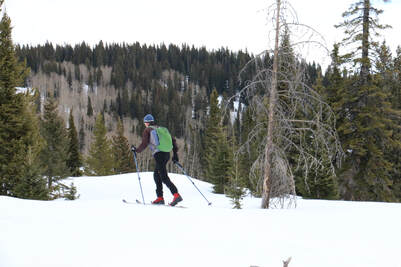 Myth: No-wax cross country skis don’t need wax. False. A "No Wax" ski is an unfortunate description. XC skis that have a fish scale pattern that provides the "kick" help you glide forward. The pattern does not require kick wax. However, these skis will benefit from glide wax. There are many brands of liquid glide wax that are easy to apply and will enhance your XC ski day. Apply a liquid glide wax from tip to tail right through the "no wax" pattern. This will prevent the ski from icing up or glomming up with packed snow. Glide waxing your "no wax" skis will keep you skiing and very happy. Myth: If it's cold dress in as many layers as you can to stay warm. False. We recommend you dress for your winter activity not necessarily the weather. On a cold day a snowshoer or XC skier may dress pretty light with minimal breathable layers while a downhill skier may layer up significantly more including jacket and pant shells that are both windproof and waterproof. An aerobic activity will produce more consistent body heat than perhaps a downhill skier who has to also dress for a cold chair ride up the ski hill. On the same cold day, playing at different winter activities, you'll benefit with different layering options. 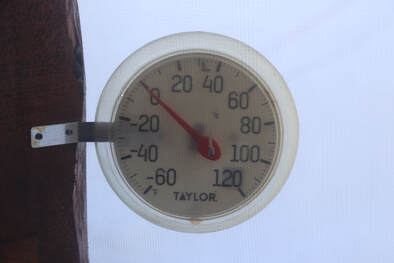 Myth: Cold is cold no matter what. False. It's funny to think about a 32 degree day in October feeling really cold and a 32 degree day in January feeling down right balmy! If time is relative so is cold. Sunshine, clouds, wind, and humidity all play a role in how cold a day feels. Be active all winter long and embrace the season no matter what the thermometer says! Myth: There are less hours in a winter day with Standard Time. False. Switching from Daylight Saving Time to Standard Time in November does not reduce the length or hours of a day. We heard a Denver weather forecaster misspeak on air before the Winter Solstice and say “since there are less hours in the day the sun is setting earlier.” This drives us crazy and often folks blame Standard Time for the reduction of daylight in the winter. This natural earth science event will occur whether we are on Standard Time or Daylight Saving Time. The point is to make as much of a winter day as possible. And that can include wearing a headlamp and going for a snowshoe tour at night! 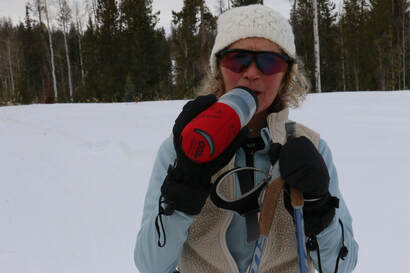 Myth: You don’t need to hydrate as much in winter as in summer because you don’t get as hot or thirsty. False. You need to hydrate equally all year long. And, hydrating in winter will actually help keep you warmer. Bring along a thermos filled with a hot drink on your winter excursion. The warmth of the drink will fill you with a very cozy feeling filled with gratitude for winter! Myth: Alcohol keeps you in warm on the trail in winter. False. The opposite is true. Alcohol drops your body temperature. Drinking alcohol may make you feel warm outside in winter because it causes blood to rush to your skin’s surface. This causes your blood vessels to widen and makes you lose heat faster. The best place to partake in an adult beverage during winter is at the end of the day, inside sitting in a comfortable chair beside the wood stove, sipping your libation in moderation and trading stories about the day’s adventure. Myth: You lose tons of body heat through the top of your head. False. While it is smart to always wear a hat outside in winter you lose only about 10% of your body heat through your head. 10% is not very much but who wants a cold head in winter anyway?. Just wear a hat no matter how little body heat you lose from the top of your head. And by the way, wearing a hat and protecting your ears from frostbite is a smart thing as well. 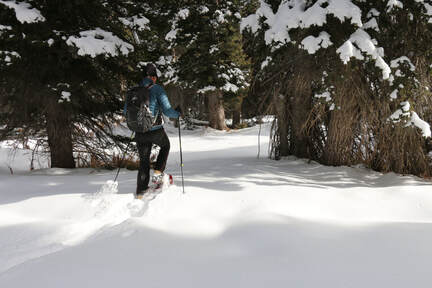 Myth: XC skiing and snowshoeing are boring. False. “We just went for a snowshoe tour.” I use to hear this disparaging remark often when I worked retail in a mountain shop. This phrase, with the emphasis on "just" discounts these activities as if the only worthy winter sport is downhill skiing. In fact, xc skiing and snowshoeing are equally as exciting or even more so. Hands down these two winter activities provide a major boost to your overall physical and mental health. They provide a great cardiovascular workout increasing heart and lung health. And, arguably, they allow you to connect with nature in a more significant way by slowing down and acknowledging the beauty surrounding you. 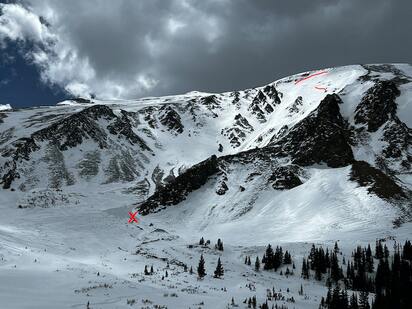 Photo: CAIC Photo: CAIC Myth: If avalanche risk is rated at low or moderate you can ski or ride anywhere. False. Always keep your guard up when traveling through the backcountry whether you are snowshoeing, skiing, snowboarding, or hiking. Avalanches can occur year round. A reduced risk does not eliminate risk. Take avalanche awareness courses to educate yourself and your backcountry partners. Be aware of the overall avalanche danger by checking the CAIC website. And always play it smart. Myth: If avalanche risk is rated at high or extreme stay out of the backcountry no matter what. False. There are many places that are safe to travel in the backcountry when conditions are ripe for avalanches. It is easy to avoid avalanche terrain. Stay on flat or very low angle terrain. Tour through wide open meadows. Avoid all suspicious slopes. Be aware of potential avalanche terrain above you. You may be on flat terrain but what do the slopes and ridges above you look like? Avoid terrain traps where an avalanche (big or small) might trap you. Do not take unnecessary risks, stay off all slopes that look suspicious. Typically when avalanche risk is at its highest the winter weather is at its stormiest. While it can be fun to ski or snowshoe during a winter storm take all precautions to stay safe and warm so you can and enjoy many winter days to come! Myth: Winter can be enjoyed each and every day. TRUE! No matter the weather, no matter the outside temperature or wind speed, no matter how deep or thin the snowpack might be, no matter if the sun is shining or the day is cloudy, no matter how old your winter equipment or clothing is, or if you live in the country or city... Winter can be enjoyed each and every day by acknowledging its beauty and in turn, knowing it is another great day to be outside!
|
"The wild requires that we learn the terrain, nod to all the plants and animals and birds, ford the streams and cross the ridges, and tell a good story when we get back home." ~ Gary Snyder
Categories
All
“Hiking -I don’t like either the word or the thing. People ought to saunter in the mountains - not hike! Do you know the origin of the word ‘saunter?’ It’s a beautiful word. Away back in the Middle Ages people used to go on pilgrimages to the Holy Land, and when people in the villages through which they passed asked where they were going, they would reply, A la sainte terre,’ ‘To the Holy Land.’ And so they became known as sainte-terre-ers or saunterers. Now these mountains are our Holy Land, and we ought to saunter through them reverently, not ‘hike’ through them.” ~ John Muir |
© Copyright 2025 Barefoot Publications, All Rights Reserved

